ZyXEL Communications NBG420N Wireless N Router User Manual NBG334W User Guide
ZyXEL Communications Corporation Wireless N Router NBG334W User Guide
Contents
- 1. User manual part1
- 2. User manual part2
- 3. User manual part3
- 4. User manual part4
User manual part2

Chapter 7 Wireless LAN
NBG420N User’s Guide 101
7.6 MAC Filter
The MAC filter screen allows you to configure the NBG420N to give exclusive access to up to
32 devices (Allow) or exclude up to 32 devices from accessing the NBG420N (Deny). Every
Ethernet device has a unique MAC (Media Access Control) address. The MAC address is
assigned at the factory and consists of six pairs of hexadecimal characters, for example,
00:A0:C5:00:00:02. You need to know the MAC address of the devices to configure this
screen.
To change your NBG420N’s MAC filter settings, click Network > Wireless LAN > MAC
Filter. The screen appears as shown.
Group Key Update
Timer
The Group Key Update Timer is the rate at which the AP (if using WPA-PSK/
WPA2-PSK key management) or RADIUS server (if using WPA/WPA2 key
management) sends a new group key out to all clients. The re-keying process is
the WPA/WPA2 equivalent of automatically changing the WEP key for an AP and
all stations in a WLAN on a periodic basis. Setting of the Group Key Update
Timer is also supported in WPA-PSK/WPA2-PSK mode. The NBG420N default
is 1800 seconds (30 minutes).
Authentication Server
IP Address Enter the IP address of the external authentication server in dotted decimal
notation.
Port Number Enter the port number of the external authentication server. The default port
number is 1812.
You need not change this value unless your network administrator instructs you
to do so with additional information.
Shared Secret Enter a password (up to 31 alphanumeric characters) as the key to be shared
between the external authentication server and the NBG420N.
The key must be the same on the external authentication server and your
NBG420N. The key is not sent over the network.
Accounting Server
Active Select Yes from the drop down list box to enable user accounting through an
external authentication server.
IP Address Enter the IP address of the external accounting server in dotted decimal notation.
Port Number Enter the port number of the external accounting server. The default port number
is 1813.
You need not change this value unless your network administrator instructs you
to do so with additional information.
Shared Secret Enter a password (up to 31 alphanumeric characters) as the key to be shared
between the external accounting server and the NBG420N.
The key must be the same on the external accounting server and your
NBG420N. The key is not sent over the network.
Apply Click Apply to save your changes back to the NBG420N.
Reset Click Reset to reload the previous configuration for this screen.
Table 33 Network > Wireless LAN > General: WPA/WPA2
LABEL DESCRIPTION
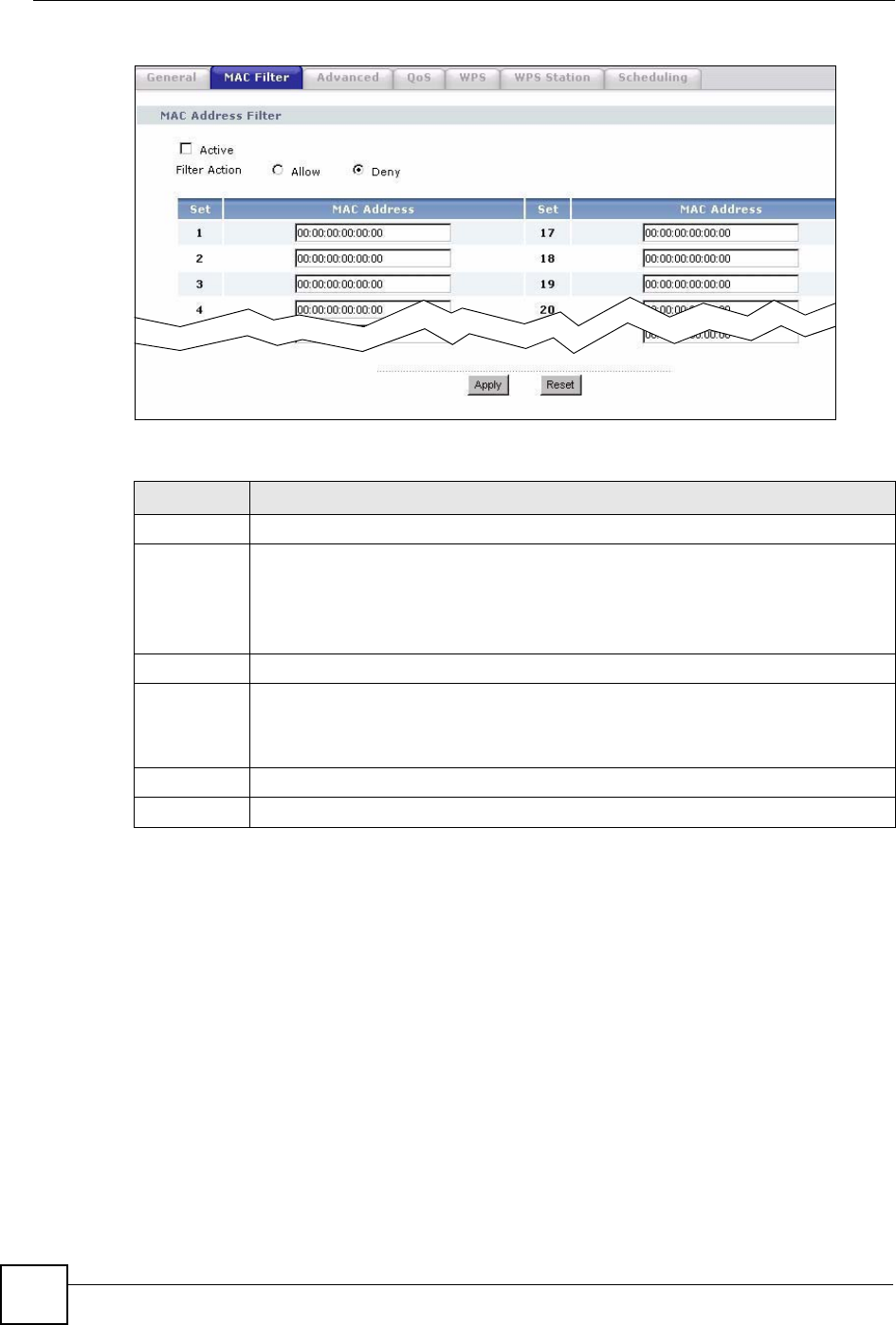
Chapter 7 Wireless LAN
NBG420N User’s Guide
102
Figure 66 Network > Wireless LAN > MAC Filter
The following table describes the labels in this menu.
7.7 Wireless LAN Advanced Screen
Click Network > Wireless LAN > Advanced. The screen appears as shown.
Table 34 Network > Wireless LAN > MAC Filter
LABEL DESCRIPTION
Active Select Yes from the drop down list box to enable MAC address filtering.
Filter Action Define the filter action for the list of MAC addresses in the MAC Address table.
Select Deny to block access to the NBG420N, MAC addresses not listed will be
allowed to access the NBG420N
Select Allow to permit access to the NBG420N, MAC addresses not listed will be
denied access to the NBG420N.
Set This is the index number of the MAC address.
MAC
Address
Enter the MAC addresses of the wireless station that are allowed or denied access to
the NBG420N in these address fields. Enter the MAC addresses in a valid MAC
address format, that is, six hexadecimal character pairs, for example,
12:34:56:78:9a:bc.
Apply Click Apply to save your changes back to the NBG420N.
Reset Click Reset to reload the previous configuration for this screen.
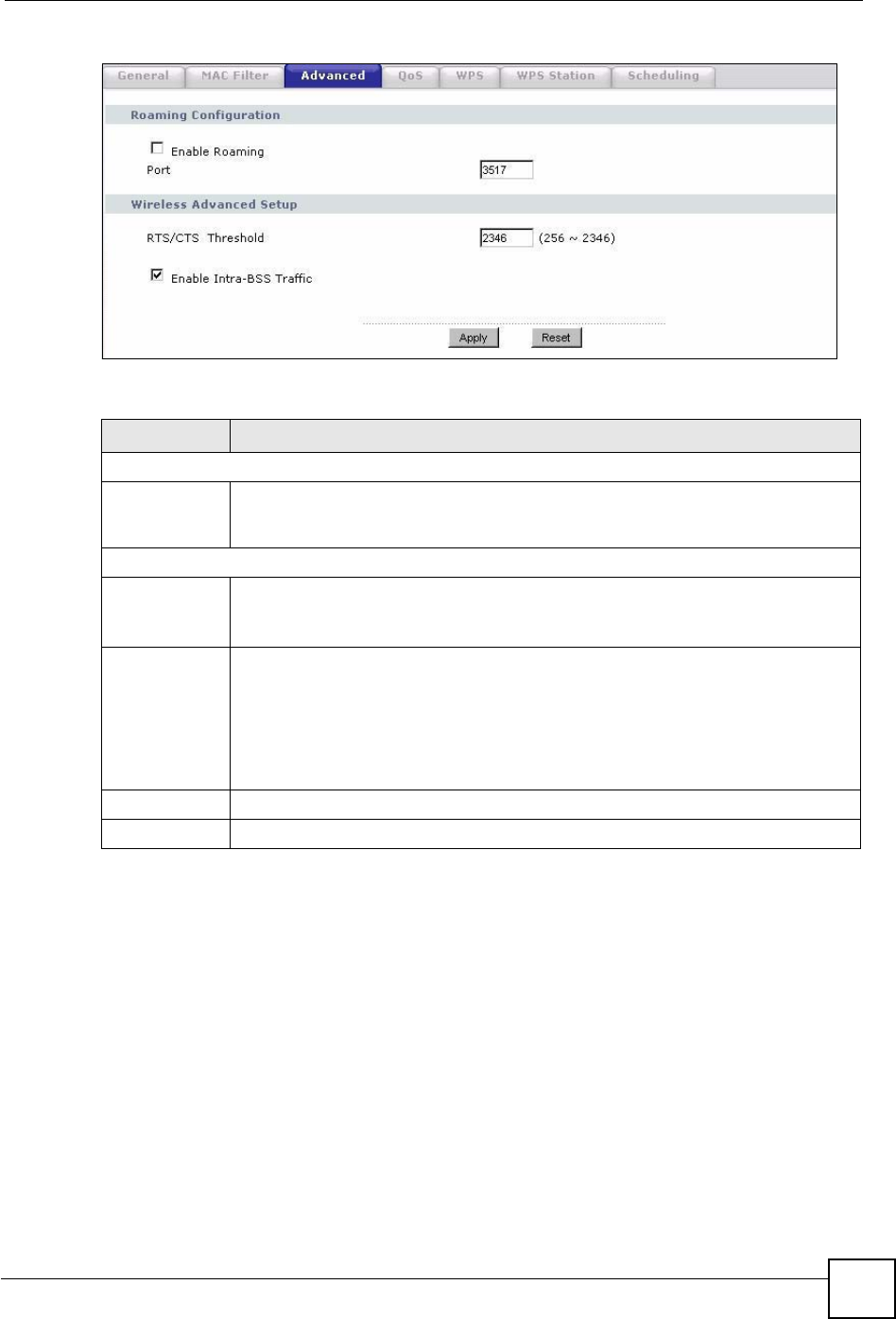
Chapter 7 Wireless LAN
NBG420N User’s Guide 103
Figure 67 Network > Wireless LAN > Advanced
The following table describes the labels in this screen.
7.8 Quality of Service (QoS) Screen
The QoS screen allows you to automatically give a service (such as e-mail, VoIP or FTP) a
priority level.
Click Network > Wireless LAN > QoS. The following screen appears.
Table 35 Network > Wireless LAN > Advanced
LABEL DESCRIPTION
Roaming Configuration
Enable
Roaming
Select this option if your network environment has multiple APs and you want your
wireless device to be able to access the network as you move between wireless
networks.
Wireless Advanced Setup
RTS/CTS
Threshold
Data with its frame size larger than this value will perform the RTS (Request To
Send)/CTS (Clear To Send) handshake.
Enter a value between 0 and 2432.
Enable Intra-
BSS Traffic
A Basic Service Set (BSS) exists when all communications between wireless clients
or between a wireless client and a wired network client go through one access point
(AP).
Intra-BSS traffic is traffic between wireless clients in the BSS. When Intra-BSS is
enabled, wireless client A and B can access the wired network and communicate
with each other. When Intra-BSS is disabled, wireless client A and B can still access
the wired network but cannot communicate with each other.
Apply Click Apply to save your changes back to the NBG420N.
Reset Click Reset to reload the previous configuration for this screen.
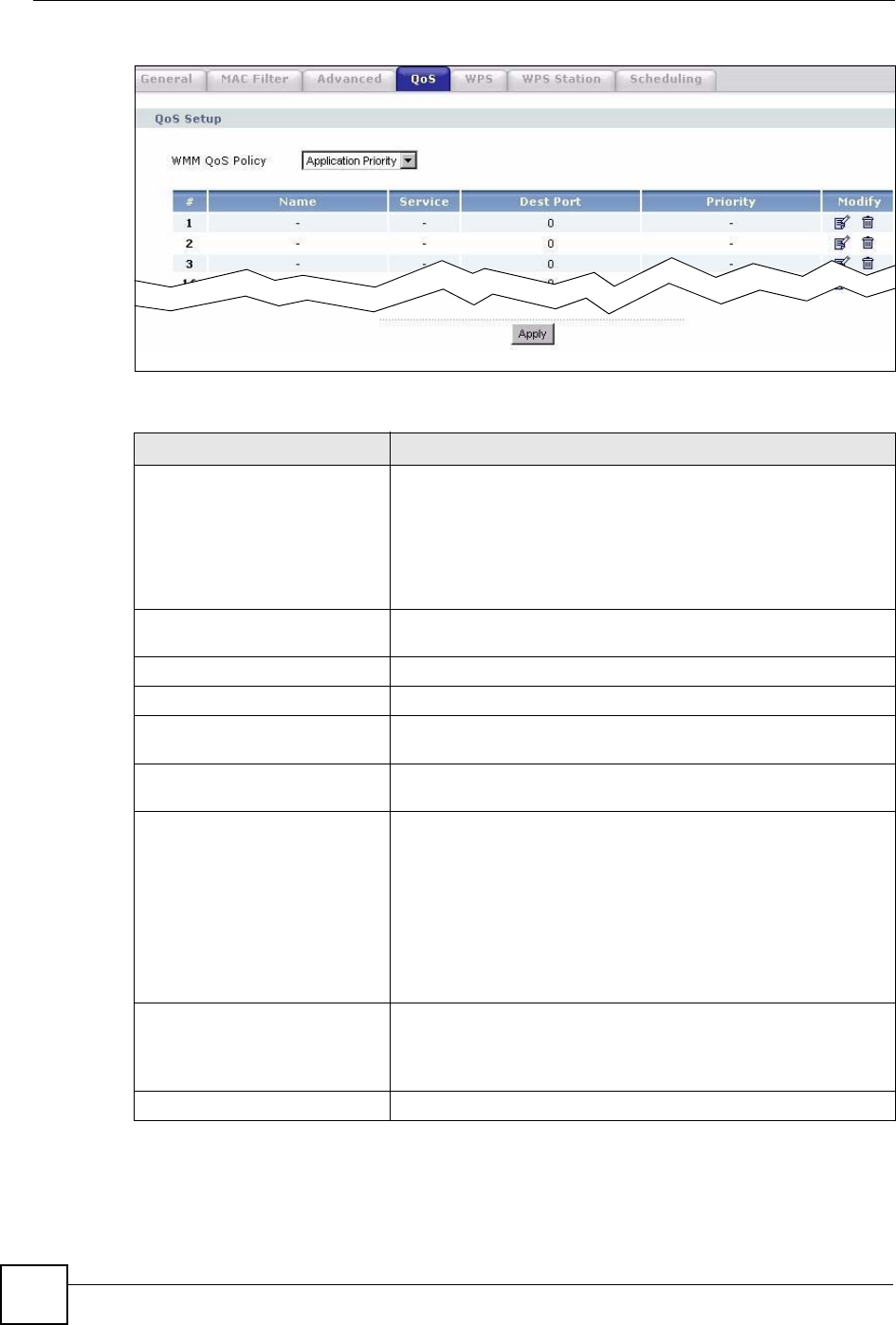
Chapter 7 Wireless LAN
NBG420N User’s Guide
104
Figure 68 Network > Wireless LAN > QoS
The following table describes the labels in this screen.
Table 36 Network > Wireless LAN > QoS
LABEL DESCRIPTION
WMM QoS Policy Select Default to have the NBG420N automatically give a service a
priority level according to the ToS value in the IP header of packets
it sends. WMM QoS (Wifi MultiMedia Quality of Service) gives high
priority to voice and video, which makes them run more smoothly.
Select Application Priority from the drop-down list box to display a
table of application names, services, ports and priorities to which
you want to apply WMM QoS.
The table appears only if you select Application Priority in WMM
QoS Policy.
# This is the number of an individual application entry.
Name This field displays a description given to an application entry.
Service This field displays either FTP,WWW,E-mail or a User Defined
service to which you want to apply WMM QoS.
Dest Port This field displays the destination port number to which the
application sends traffic.
Priority This field displays the priority of the application.
Highest - Typically used for voice or video that should be high-
quality.
High - Typically used for voice or video that can be medium-quality.
Mid - Typically used for applications that do not fit into another
priority. For example, Internet surfing.
Low - Typically used for non-critical “background” applications,
such as large file transfers and print jobs that should not affect
other applications.
Modify Click the Edit icon to open the Application Priority Configuration
screen. Modify an existing application entry or create a application
entry in the Application Priority Configuration screen.
Click the Remove icon to delete an application entry.
Apply Click Apply to save your changes to the NBG420N.
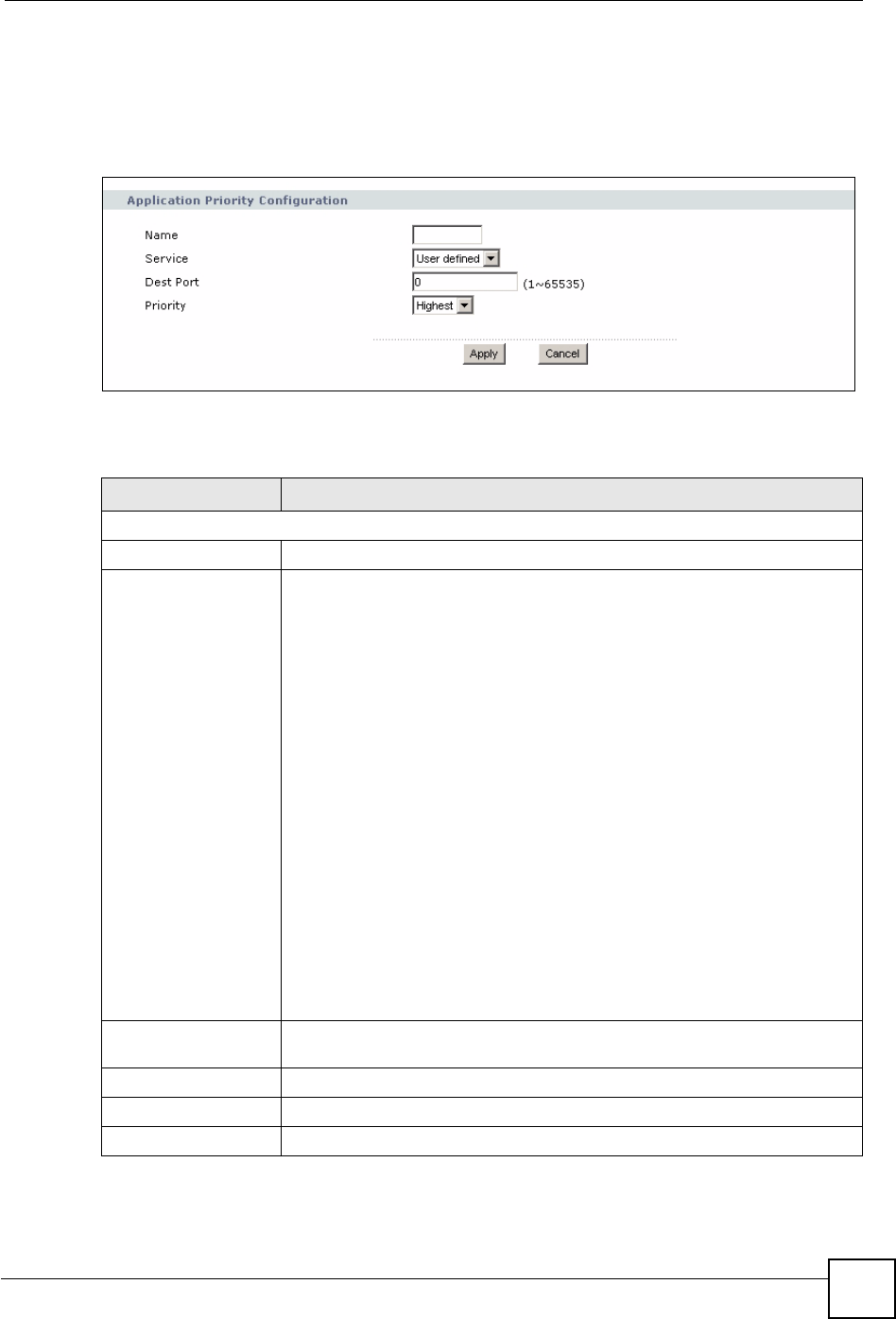
Chapter 7 Wireless LAN
NBG420N User’s Guide 105
7.8.1 Application Priority Configuration
Use this screen to edit a WMM QoS application entry. Click the edit icon under Modify. The
following screen displays.
Figure 69 Network > Wireless LAN > QoS: Application Priority Configuration
See Appendix F on page 321 for a list of commonly-used services and destination ports. The
following table describes the fields in this screen.
Network > Wireless LAN > QoS: Application Priority Configuration
LABEL DESCRIPTION
Application Priority Configuration
Name Type a description of the application priority.
Service The following is a description of the applications you can prioritize with WMM
QoS. Select a service from the drop-down list box.
• E-Mail
Electronic mail consists of messages sent through a computer network to
specific groups or individuals. Here are some default ports for e-mail:
POP3 - port 110
IMAP - port 143
SMTP - port 25
HTTP - port 80
•FTP
File Transfer Protocol enables fast transfer of files, including large files that it
may not be possible to send via e-mail. FTP uses port number 21.
•WWW
The World Wide Web is an Internet system to distribute graphical, hyper-
linked information, based on Hyper Text Transfer Protocol (HTTP) - a client/
server protocol for the World Wide Web. The Web is not synonymous with the
Internet; rather, it is just one service on the Internet. Other services on the
Internet include Internet Relay Chat and Newsgroups. The Web is accessed
through use of a browser.
•User-Defined
User-defined services are user specific services configured using known ports
and applications.
Dest Port This displays the port the selected service uses. Type a port number in the
field provided if you want to use a different port to the default port.
Priority Select a priority from the drop-down list box.
Apply Click Apply to save your changes back to the NBG420N.
Cancel Click Cancel to return to the previous screen.
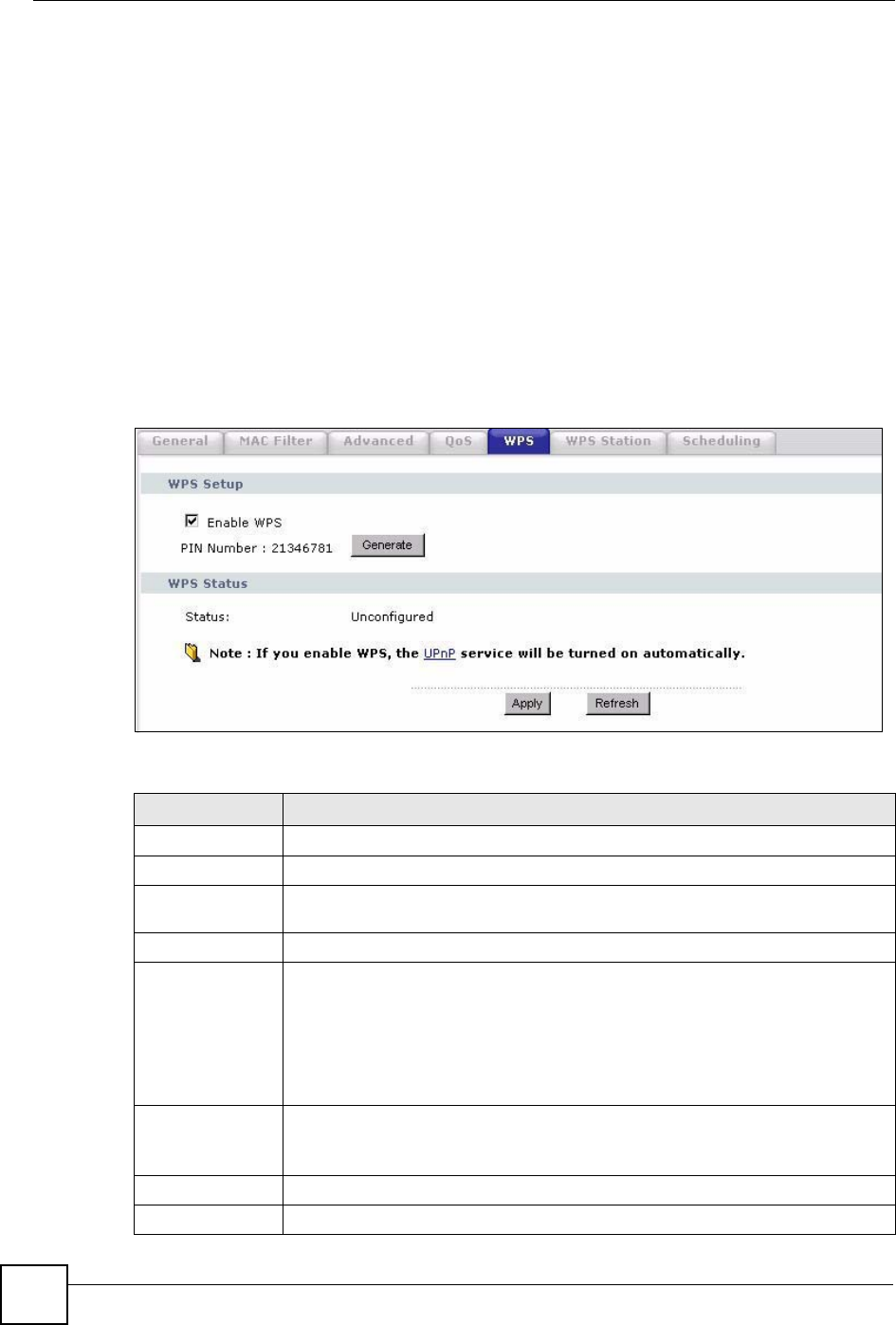
Chapter 7 Wireless LAN
NBG420N User’s Guide
106
7.9 WiFi Protected Setup
WiFi Protected Setup (WPS) is an industry standard specification, defined by the WiFi
Alliance. WPS allows you to quickly set up a wireless network with strong security, without
having to configure security settings manually. Depending on the devices in your network, you
can either press a button (on the device itself, or in its configuration utility) or enter a PIN
(Personal Identification Number) in the devices. Then, they connect and set up a secure
network by themselves. See how to set up a secure wireless network using WPS in the Section
6.1.2 on page 73.
7.9.1 WPS Screen
Use this screen to enable/disable WPS, view or generate a new PIN number and check current
WPS status. To open this screen, click Network >Wireless LAN > WPS tab.
Figure 70 WPS
The following table describes the labels in this screen.
Table 37 WPS
LABEL DESCRIPTION
WPS Setup
Enable WPS Select this to enable the WPS feature.
PIN Number This displays a PIN number last time system generated. Click Generate to
generate a new PIN number.
WPS Status
Status This displays Configured when the NBG420N has connected to a wireless
network using WPS or when Enable WPS is selected and wireless or wireless
security settings have been changed. The current wireless and wireless security
settings also appear in the screen.
This displays Unconfigured if WPS is disabled and there are no wireless or
wireless security changes on the NBG420N or you click Release_Configuration
to remove the configured wireless and wireless security settings.
Release
Configuration
This button is only available when the WPS status displays Configured.
Click this button to remove all configured wireless and wireless security settings
for WPS connections on the NBG420N.
Apply Click Apply to save your changes back to the NBG420N.
Refresh Click Refresh to get this screen information afresh.
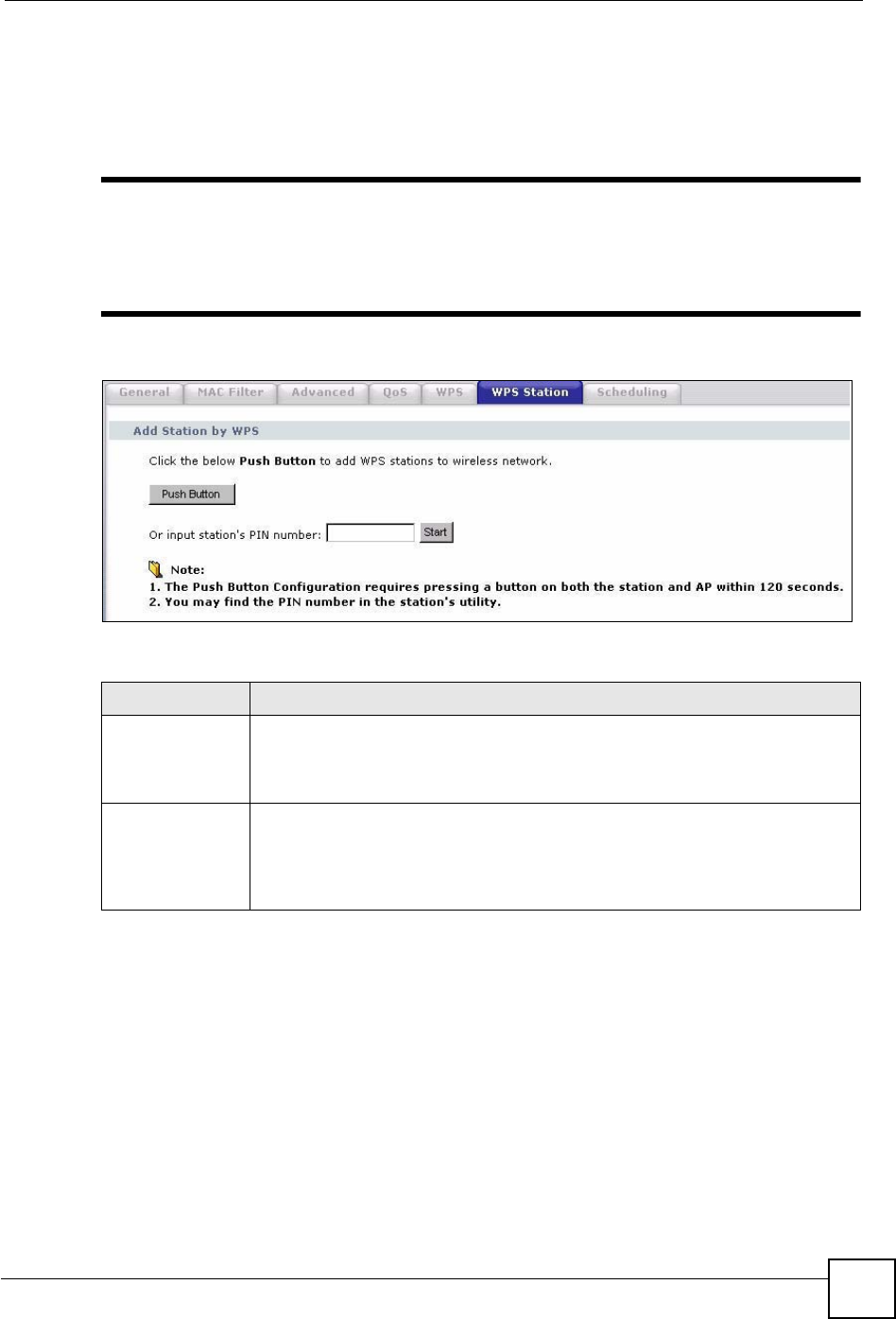
Chapter 7 Wireless LAN
NBG420N User’s Guide 107
7.9.2 WPS Station Screen
Use this screen when you want to add a wireless station using WPS. To open this screen, click
Network > Wireless LAN > WPS Station tab.
"
Note: After you click Push Button on this screen, you have to press a similar
button in the wireless station utility within 2 minutes. To add the second
wireless station, you have to press these buttons on both device and the
wireless station again after the first 2 minutes.
Figure 71 WPS Station
The following table describes the labels in this screen.
7.9.3 Scheduling
Use this screen to set the times your wireless LAN is turned on and off. Wireless LAN
scheduling is disabled by default. The wireless LAN can be scheduled to turn on or off on
certain days and at certain times. To open this screen, click Network > Wireless LAN >
Scheduling tab.
Table 38 WPS Station
LABEL DESCRIPTION
Push Button Use this button when you use the PBC (Push Button Configuration) method to
configure wireless stations’s wireless settings. See Section 6.1.2.1 on page 74.
Click this to start WPS-aware wireless station scanning and the wireless security
information synchronization.
Or input station’s
PIN number
Use this button when you use the PIN Configuration method to configure wireless
station’s wireless settings. See Section 6.1.2.2 on page 75.
Type the same PIN number generated in the wireless station’s utility. Then click
Start to associate to each other and perform the wireless security information
synchronization.
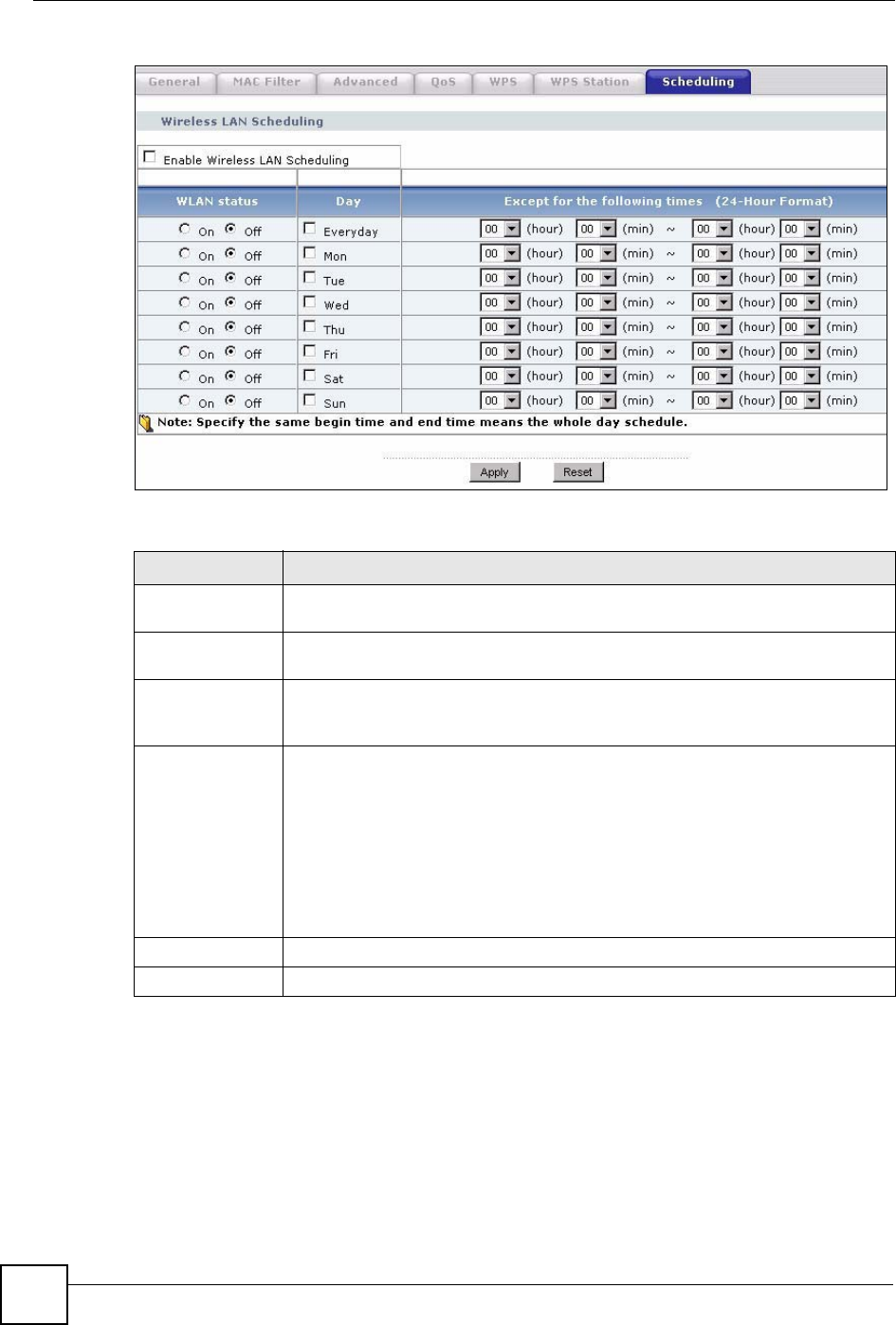
Chapter 7 Wireless LAN
NBG420N User’s Guide
108
Figure 72 Scheduling
The following table describes the labels in this screen.
7.10 iPod Touch Web Configurator
The iPod Touch web configurator displays when you are connecting to the NBG420N
wirelessly with an iPod Touch device through a web browser. It is different to the web
configurator that you access from your computer.
To connect wirelessly to the iPod Touch web configurator with your iPod Touch follow the
steps below:
Table 39 Scheduling
LABEL DESCRIPTION
Enable Wireless
LAN Scheduling
Select this to enable Wireless LAN scheduling.
WLAN Status Select On or Off to specify whether the Wireless LAN is turned on or off. This field
works in conjunction with the Day and Except for the following times fields.
Day Select Everyday or the specific days to turn the Wireless LAN on or off. If you
select Everyday you can not select any specific days. This field works in
conjunction with the Except for the following times field.
Except for the
following times
(24-Hour Format)
Select a begin time using the first set of hour and minute (min) drop down boxes
and select an end time using the second set of hour and minute (min) drop down
boxes. If you have chosen On earlier for the WLAN Status the Wireless LAN will
turn off between the two times you enter in these fields. If you have chosen Off
earlier for the WLAN Status the Wireless LAN will turn on between the two times
you enter in these fields.
Note: Entering the same begin time and end time will mean the
whole day.
Apply Click Apply to save your changes back to the NBG420N.
Reset Click Reset to reload the previous configuration for this screen.
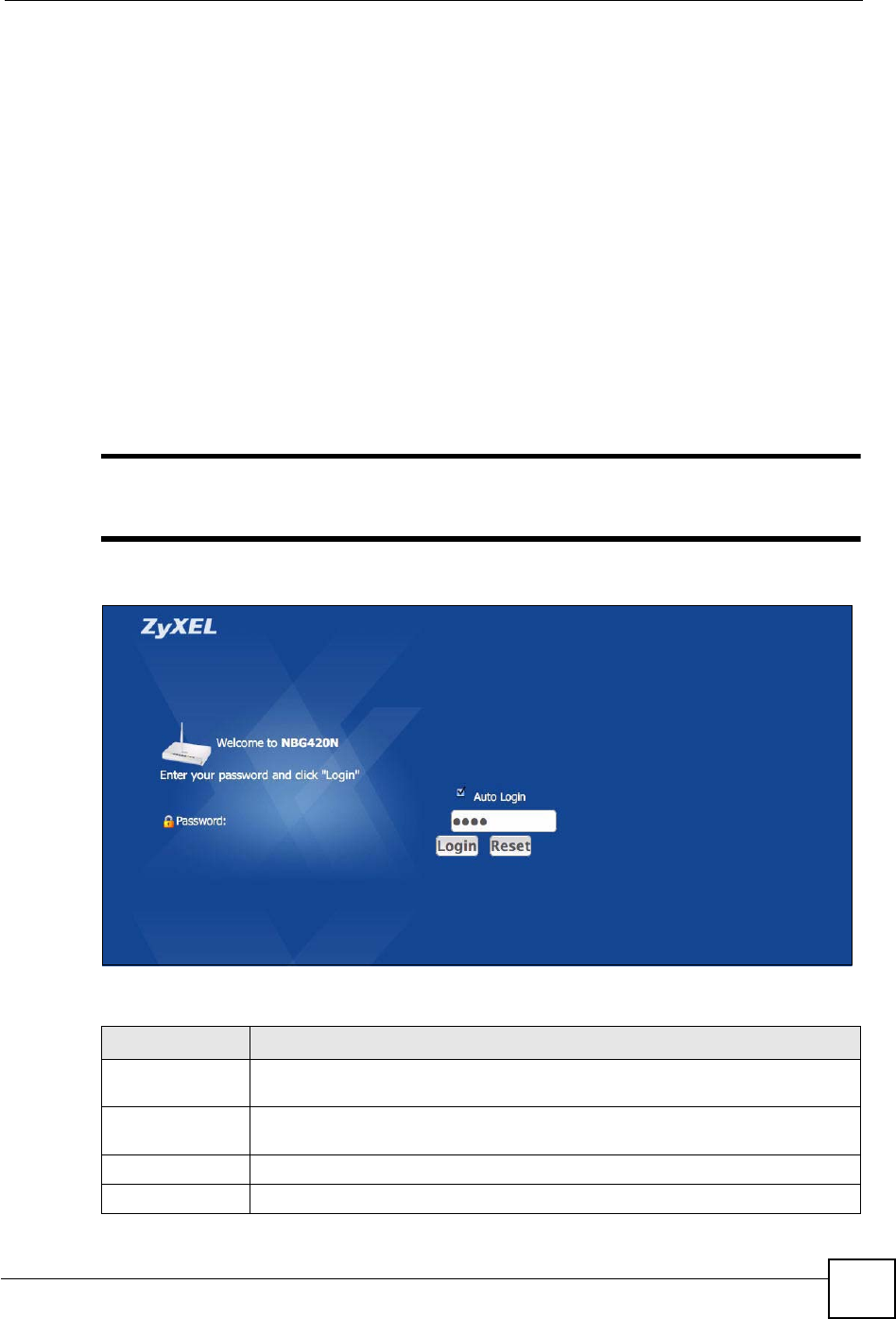
Chapter 7 Wireless LAN
NBG420N User’s Guide 109
1Make sure the Wireless LAN on the NBG420N is enabled and that you know the
security settings (if any). To do this check the Wireless LAN > General screen in the
web configurator from your computer.
2On the iPod Touch’s main screen press Settings > Wi-fi and from the list press the
NBG420N’s network name (SSID) to connect to it. If you are prompted for any security
settings enter them and press connect. If you cannot connect check your security settings
in the web configurator from your computer and try again.
3After connecting to the NBG420N’s wireless LAN network launch the iPod Touch
Internet browser and enter the NBG420N’s IP address (default: 192.168.1.1) into the
address bar. The login screen displays.
7.10.1 Login Screen
After accessing the NBG420N’s IP address in the iPod Touch web browser the screen below
will display.
"
You cannot change your password in the iPod Touch web configurator. To
change your password log into the web configurator using your computer.
Figure 73 Login Screen
The following table describes the labels in this screen.
Table 40 Login Screen
LABEL DESCRIPTION
Auto Login Select this checkbox to automatically log into the iPod Touch web configurator
when accessing it through the same iPod Touch device.
Password Enter the password for the NBG420N. If you haven’t changed the default
password earlier this is “1234”.
Login Press the Login button to log into the iPod Touch web configurator.
Reset Press the Reset button to clear your selections and start over.

Chapter 7 Wireless LAN
NBG420N User’s Guide
110
7.10.2 System Status
After successfully logging into the iPod Touch web configurator the System Status screen
displays.
"
Your changes in the iPod Touch web configurator are saved automatically after
pressing a button.
If you are going to use the WPS (Wi-Fi Protected Setup) function in the iPod Touch Web
Configurator it is recommended to configure your WPS settings first from your computer.
If WPS has not been configured previously the iPod Touch will lose it’s wireless connection to
the NBG420N after the NBG420N has connected to another device using WPS through the
iPod Touch web configurator. To reconnect to the wireless network using your iPod Touch you
must find out the new WPS settings by logging into the web configurator from your computer
and going to the Wireless LAN screen.
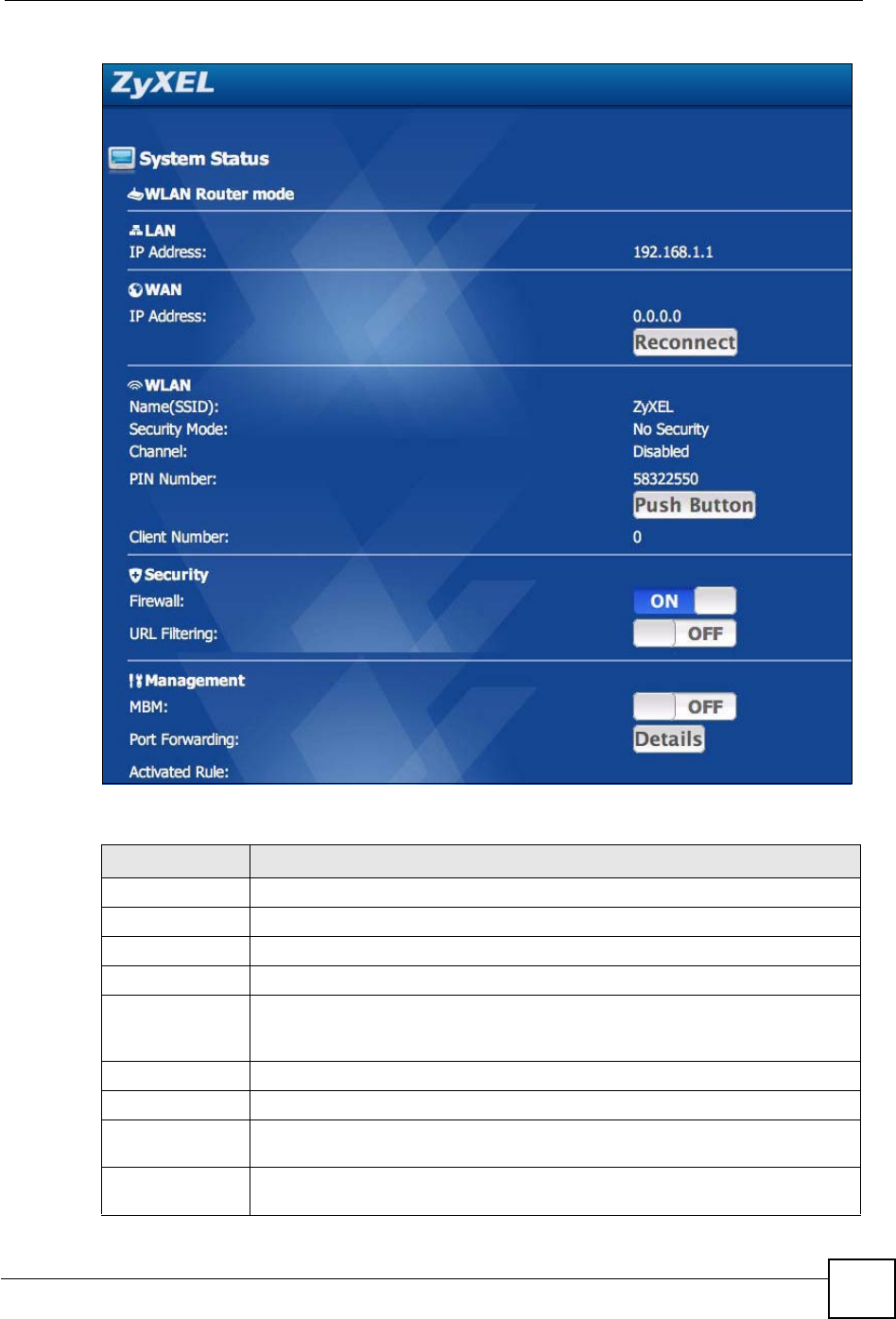
Chapter 7 Wireless LAN
NBG420N User’s Guide 111
Figure 74 System Status screen
The following table describes the labels in this screen.
Table 41 System Status screen
LABEL DESCRIPTION
Logout Press this to logout of the iPod Touch web configurator.
LAN
IP Address This field displays the NBG420N’s LAN (Local Area Network) IP address.
WAN
IP Address This field displays the NBG420N’s WAN IP address. If this field displays “-” it
means the WAN is not connected. Try pressing Reconnect if your WAN
connection is not working.
Reconnect Press Reconnect to renew your NBG420N’s WAN connection.
WLAN
Name (SSID) This field displays the SSID (Service set identifier) of the NBG420N’s Wireless
LAN.
Security Mode This field displays the security authentication mode of the NBG420N’s Wireless
LAN. This can be No Security,WPA-PSK,WPA2-PSK or WEP.

Chapter 7 Wireless LAN
NBG420N User’s Guide
112
7.10.3 WPS in Progress
After pressing Push Button in the System Status screen the WPS in Progress screen will
display.
It can take around two minutes for a successful WPS connection to be made. The System
Status screen will display after a connection has been made or if it has failed. For more
information on WPS see Section 7.9 on page 106.
Channel This field displays the channel the NBG420N’s Wireless LAN operates on. This
will display as disabled if auto channel selection mode is on.
PIN Number This field displays the NBG420N’s WPS (Wi-Fi Protected Setup) PIN number.
WPS allows you to connect wireless clients to your wireless LAN easily. See
Section 7.9 on page 106 for more information on WPS and the PIN method of
configuration.
Push Button Press the Push Button to start either the PBC (Push Button Configuration) or PIN
method of WPS configuration. The WPS in progress screen will display, see
Section 7.10.3 on page 112.
Client Number This field displays the number of wireless clients on the network.
Security
Firewall Press the left side of the button to turn the firewall ON. Press the right side of the
button to turn the firewall OFF. To configure the firewall access the web
configurator from your computer.
A Firewall enables the NBG420N to act as a secure gateway between the LAN
and the Internet.
URL Filtering Press the left side of the button to turn URL Filtering ON. Press the right side of
the button to turn URL Filtering OFF. To configure URL filtering access the web
configurator from your computer and go to the content filtering screens.
Content filtering enables you to block certain web features or specific URL
keywords.
Management
MBM Press the left side of the button to turn MBM (Media Bandwidth Management) ON.
Press the right side of the button to turn MBM OFF. To configure Media Bandwidth
Management access the web configurator from your computer and go to the
Bandwidth Management screens.
When accessed from a computer the web configurator allows you to specify
bandwidth management rules based on an application and/or subnet.
Port
Forwarding
Press Details to go to another screen to manage the port forwarding rules.
Activated Rule This field displays the currently activated port forwarding rules.
Table 41 System Status screen
LABEL DESCRIPTION
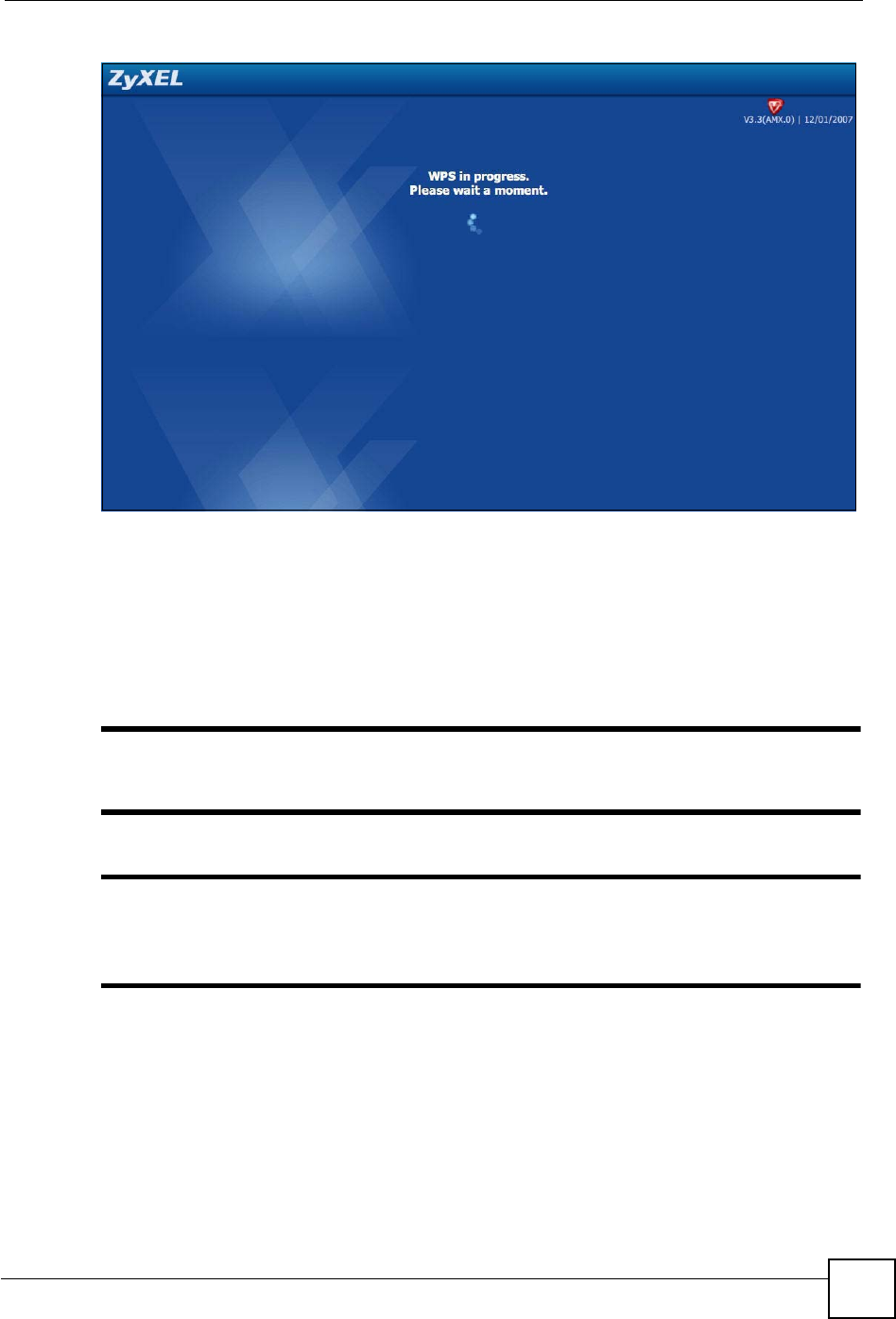
Chapter 7 Wireless LAN
NBG420N User’s Guide 113
Figure 75 WPS In Progress
7.10.4 Port Forwarding
After pressing the Details button in the System Status screen the port forwarding screen will
display. Use this screen to change the status of port forwarding rules that have been set up in
the web configurator from your computer. See Section 11.4 on page 139 for more information
on configuring port forwarding rules.
"
To go back to the System Status screen press the ZyXEL logo at the top of
the page.
"
To see any changes on the System Status screen you will need to refresh the
page first. Use the browser’s refresh function. See the iPod Touch’s
documentation if you cannot find it.
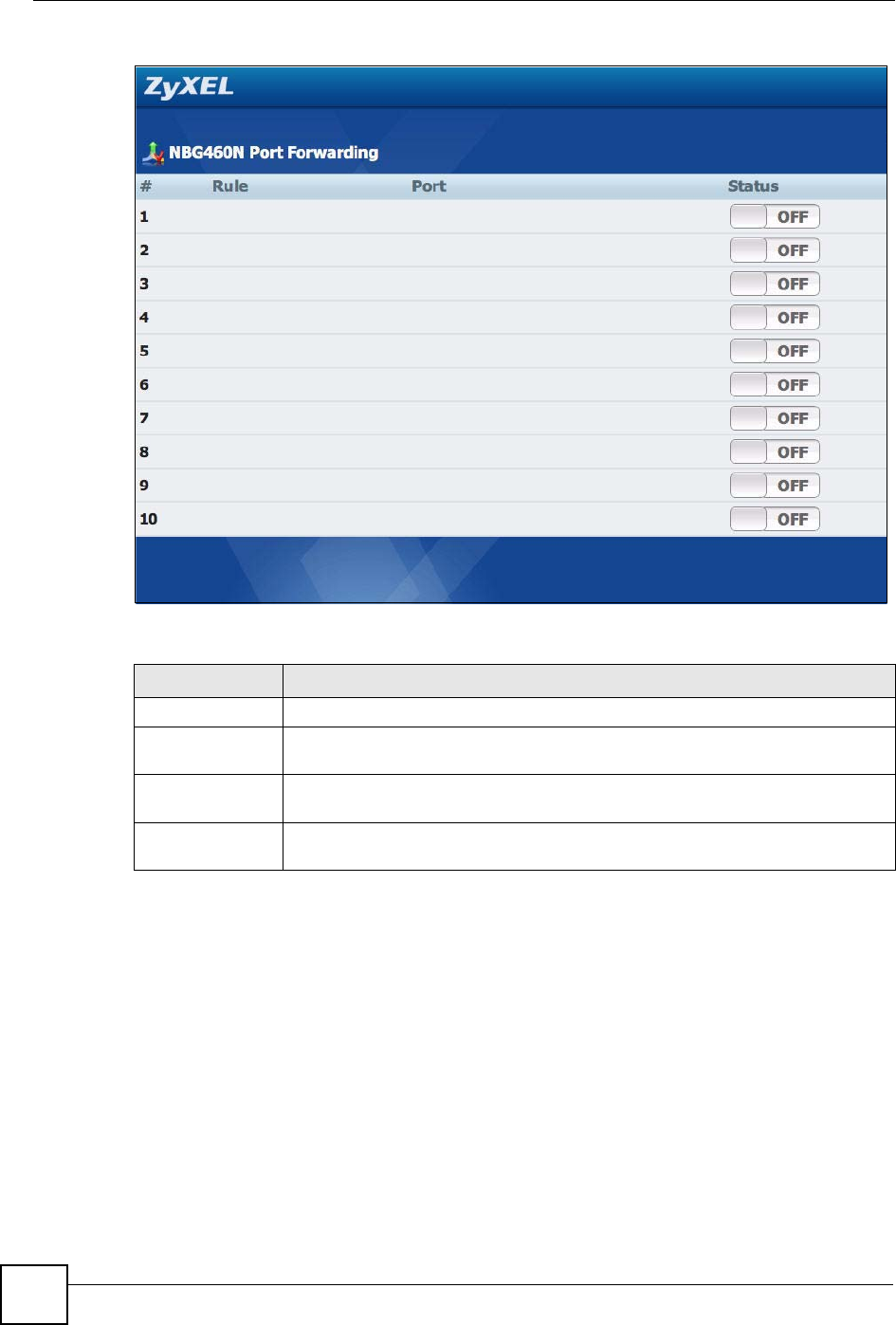
Chapter 7 Wireless LAN
NBG420N User’s Guide
114
Figure 76 Port Forwarding
The following table describes the labels in this screen.
7.11 Accessing the iPod Touch Web Configurator
To access the iPod Touch web configurator through your iPod Touch you must first connect it
to the NBG420N’s wireless network. Follow the steps below to do this.
Table 42 Port Forwarding
LABEL DESCRIPTION
#This is the number of an individual port forwarding entry.
Rule This column displays the configured port forwarding rules. To configure a new rule
you must use the web configurator from your computer.
Port This column displays the port number(s) which are forwarded when the rule is
turned on.
Status Use this column to manage the status of the rules. Press the left side of the button
to turn the rule ON and press the right side of the button to turn the rule OFF.
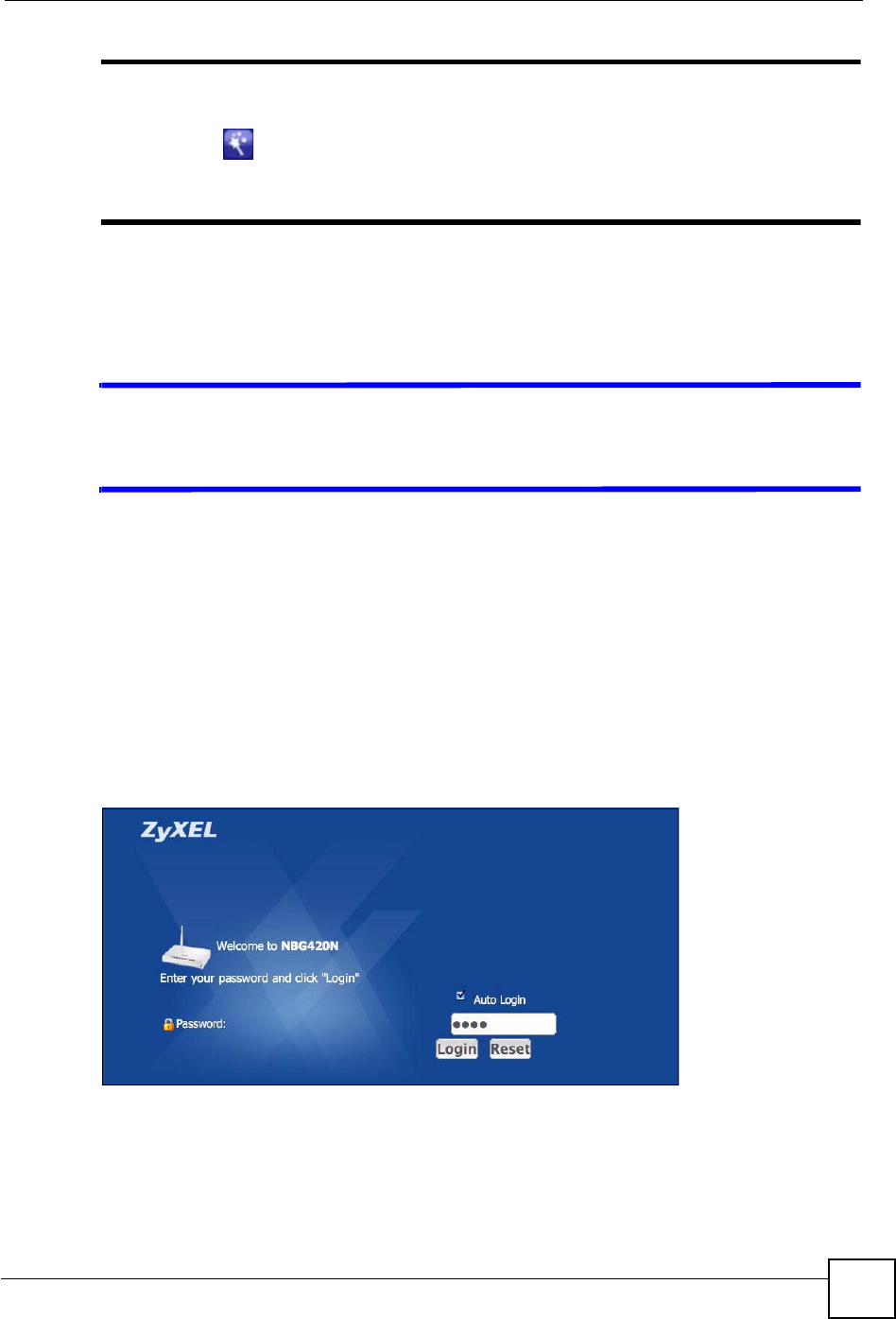
Chapter 7 Wireless LAN
NBG420N User’s Guide 115
"
If you have not configured your wireless settings yet you can do so by using
the Wizard in the web configurator you access from your computer. Click the
Wizard icon or the Go To Wizard Setup web link you see after logging
into the web configurator from your computer. See Chapter 4 on page 49 for
more information on using the Wizard.
1On the iPod Touch’s main screen press Settings and then press Wi-fi.
2On the list of networks press the NBG420N’s network name (SSID) to connect to it. If
you are prompted for any security settings enter them and press connect.
VThe pre-shared key is case-sensitive. If you have problems connecting then
try checking the security settings in the web configurator from your computer
and try again.
7.11.1 Accessing the iPod Touch Web Configurator
Now that you are connected to the NBG420N’s wireless network you can access the iPod
Touch web configurator. To do this follow the steps below:
1Launch the iPod Touch’s web browser from the main screen. The default web browser is
Safari.
2Enter the IP address of the NBG420N into the address bar and go to that address. The
default IP address for the NBG420N is 192.168.1.1.
3The login screen should display.
Figure 77 Login Screen

Chapter 7 Wireless LAN
NBG420N User’s Guide
116
VIf the login screen does not display properly, check that you are accessing the
correct IP address. Also check your iPod Touch web browser’s security
settings as they may affect how the page displays.
4If you wish to login automatically in the future make sure the Auto Login checkbox is
selected.
5Enter your password and press login. The default password for the NBG420N is “1234”.
6The System Status screen will display after successfully logging in. Congratulations!
For information on using the configurator see Section 7.10 on page 108.

NBG420N User’s Guide 117
CHAPTER 8
WAN
This chapter describes how to configure WAN settings.
8.1 WAN Overview
See the chapter about the connection wizard for more information on the fields in the WAN
screens.
8.2 WAN MAC Address
The MAC address screen allows users to configure the WAN port's MAC address by either
using the factory default or cloning the MAC address from a computer on your LAN. Choose
Factory Default to select the factory assigned default MAC Address.
Otherwise, click Clone the computer's MAC address - IP Address and enter the IP address
of the computer on the LAN whose MAC you are cloning. Once it is successfully configured,
the address will be copied to the rom file (ZyNOS configuration file). It will not change unless
you change the setting or upload a different ROM file. It is recommended that you clone the
MAC address prior to hooking up the WAN Port.
8.3 Multicast
Traditionally, IP packets are transmitted in one of either two ways - Unicast (1 sender - 1
recipient) or Broadcast (1 sender - everybody on the network). Multicast delivers IP packets to
a group of hosts on the network - not everybody and not just 1.
IGMP (Internet Group Multicast Protocol) is a network-layer protocol used to establish
membership in a Multicast group - it is not used to carry user data. IGMP version 2 (RFC
2236) is an improvement over version 1 (RFC 1112) but IGMP version 1 is still in wide use. If
you would like to read more detailed information about interoperability between IGMP
version 2 and version 1, please see sections 4 and 5 of RFC 2236. The class D IP address is
used to identify host groups and can be in the range 224.0.0.0 to 239.255.255.255. The address
224.0.0.0 is not assigned to any group and is used by IP multicast computers. The address
224.0.0.1 is used for query messages and is assigned to the permanent group of all IP hosts
(including gateways). All hosts must join the 224.0.0.1 group in order to participate in IGMP.
The address 224.0.0.2 is assigned to the multicast routers group.
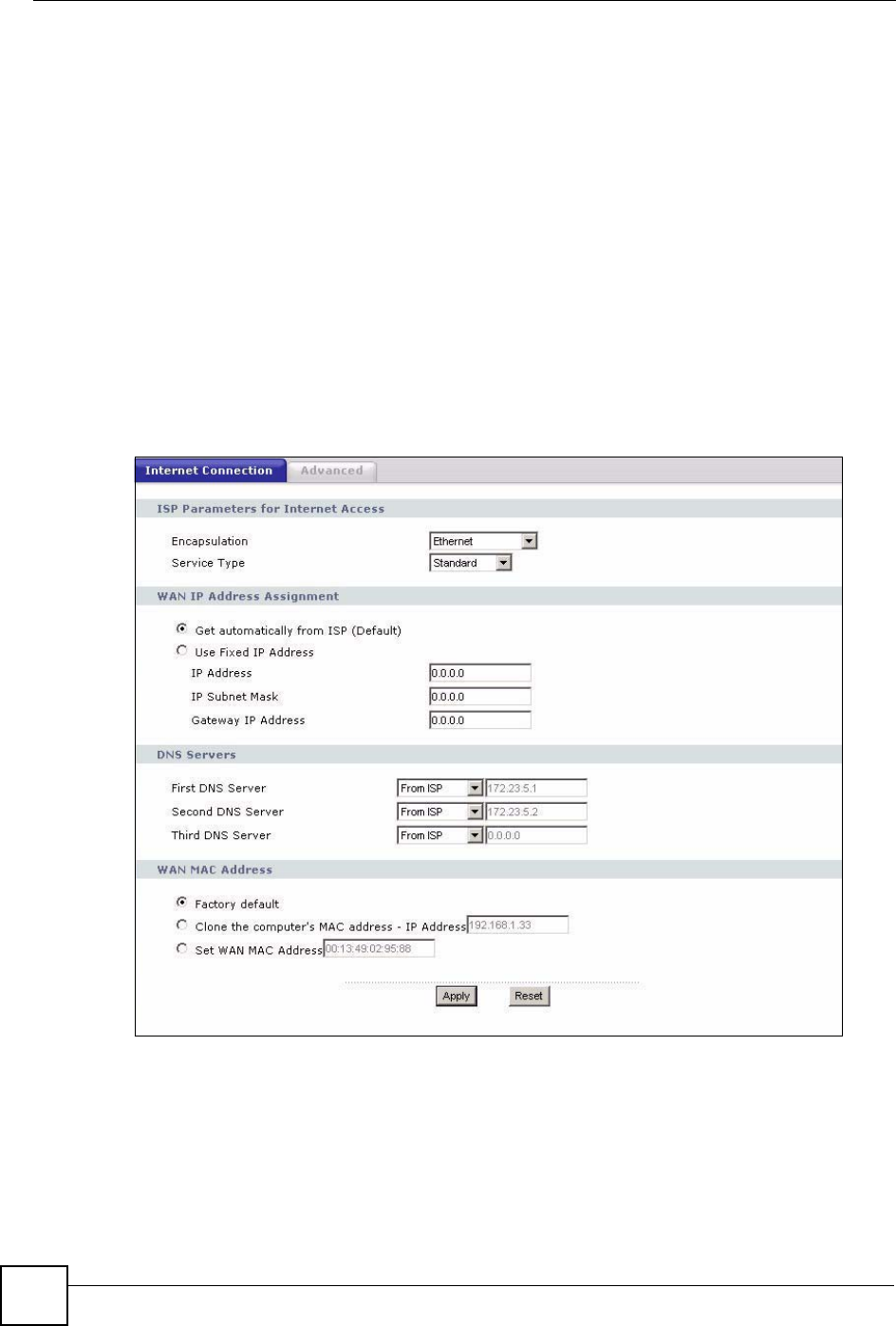
Chapter 8 WAN
NBG420N User’s Guide
118
The NBG420N supports both IGMP version 1 (IGMP-v1) and IGMP version 2 (IGMP-v2).
At start up, the NBG420N queries all directly connected networks to gather group
membership. After that, the NBG420N periodically updates this information. IP multicasting
can be enabled/disabled on the NBG420N LAN and/or WAN interfaces in the web
configurator (LAN; WAN). Select None to disable IP multicasting on these interfaces.
8.4 Internet Connection
Use this screen to change your NBG420N’s Internet access settings. Click Network > WA N .
The screen differs according to the encapsulation you choose.
8.4.1 Ethernet Encapsulation
This screen displays when you select Ethernet encapsulation.
Figure 78 Network > WAN > Internet Connection: Ethernet Encapsulation

Chapter 8 WAN
NBG420N User’s Guide 119
The following table describes the labels in this screen.
8.4.2 PPPoE Encapsulation
The NBG420N supports PPPoE (Point-to-Point Protocol over Ethernet). PPPoE is an IETF
standard (RFC 2516) specifying how a personal computer (PC) interacts with a broadband
modem (DSL, cable, wireless, etc.) connection. The PPP over Ethernet option is for a dial-
up connection using PPPoE.
Table 43 Network > WAN > Internet Connection: Ethernet Encapsulation
LABEL DESCRIPTION
Encapsulation You must choose the Ethernet option when the WAN port is used as a regular
Ethernet.
Service Type Choose from Standard,RR-Telstra (RoadRunner Telstra authentication method),
RR-Manager (Roadrunner Manager authentication method), RR-Toshiba
(Roadrunner Toshiba authentication method) or Telia Login.
The following fields do not appear with the Standard service type.
WAN IP Address Assignment
Get automatically
from ISP
Select this option If your ISP did not assign you a fixed IP address. This is the
default selection.
Use Fixed IP
Address
Select this option If the ISP assigned a fixed IP address.
IP Address Enter your WAN IP address in this field if you selected Use Fixed IP Address.
IP Subnet
Mask
Enter the IP Subnet Mask in this field.
Gateway IP
Address
Enter a Gateway IP Address (if your ISP gave you one) in this field.
DNS Servers
First DNS Server
Second DNS
Server
Third DNS Server
Select From ISP if your ISP dynamically assigns DNS server information (and the
NBG420N's WAN IP address). The field to the right displays the (read-only) DNS
server IP address that the ISP assigns.
Select User-Defined if you have the IP address of a DNS server. Enter the DNS
server's IP address in the field to the right. If you chose User-Defined, but leave
the IP address set to 0.0.0.0, User-Defined changes to None after you click
Apply. If you set a second choice to User-Defined, and enter the same IP
address, the second User-Defined changes to None after you click Apply.
Select None if you do not want to configure DNS servers. If you do not configure
a DNS server, you must know the IP address of a computer in order to access it.
WAN MAC
Address
The MAC address section allows users to configure the WAN port's MAC address
by either using the NBG420N’s MAC address, copying the MAC address from a
computer on your LAN or manually entering a MAC address.
Factory default Select Factory default to use the factory assigned default MAC Address.
Clone the
computer’s MAC
address
Select Clone the computer's MAC address - IP Address and enter the IP
address of the computer on the LAN whose MAC you are cloning. Once it is
successfully configured, the address will be copied to the rom file (ZyNOS
configuration file). It will not change unless you change the setting or upload a
different ROM file.
Set WAN MAC
Address
Select this option and enter the MAC address you want to use.
Apply Click Apply to save your changes back to the NBG420N.
Reset Click Reset to begin configuring this screen afresh.
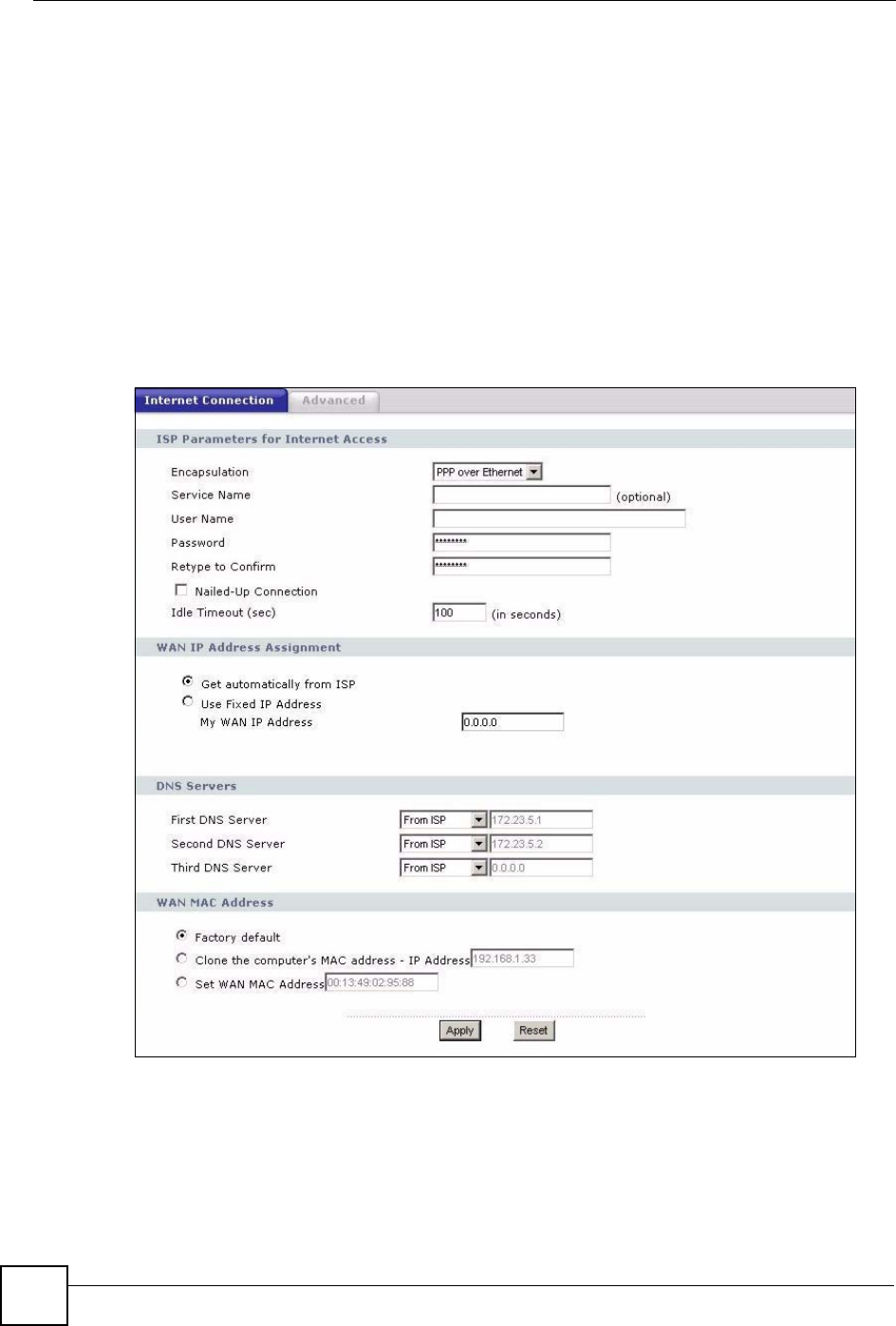
Chapter 8 WAN
NBG420N User’s Guide
120
For the service provider, PPPoE offers an access and authentication method that works with
existing access control systems (for example Radius).
One of the benefits of PPPoE is the ability to let you access one of multiple network services,
a function known as dynamic service selection. This enables the service provider to easily
create and offer new IP services for individuals.
Operationally, PPPoE saves significant effort for both you and the ISP or carrier, as it requires
no specific configuration of the broadband modem at the customer site.
By implementing PPPoE directly on the NBG420N (rather than individual computers), the
computers on the LAN do not need PPPoE software installed, since the NBG420N does that
part of the task. Furthermore, with NAT, all of the LANs’ computers will have access.
This screen displays when you select PPPoE encapsulation.
Figure 79 Network > WAN > Internet Connection: PPPoE Encapsulation

Chapter 8 WAN
NBG420N User’s Guide 121
The following table describes the labels in this screen.
Table 44 Network > WAN > Internet Connection: PPPoE Encapsulation
LABEL DESCRIPTION
ISP Parameters for Internet Access
Encapsulation The PPP over Ethernet choice is for a dial-up connection using PPPoE. The
NBG420N supports PPPoE (Point-to-Point Protocol over Ethernet). PPPoE is an
IETF Draft standard (RFC 2516) specifying how a personal computer (PC) interacts
with a broadband modem (i.e. xDSL, cable, wireless, etc.) connection.
Operationally, PPPoE saves significant effort for both the end user and ISP/carrier,
as it requires no specific configuration of the broadband modem at the customer
site. By implementing PPPoE directly on the router rather than individual
computers, the computers on the LAN do not need PPPoE software installed, since
the router does that part of the task. Further, with NAT, all of the LAN's computers
will have access.
Service Name Type the PPPoE service name provided to you. PPPoE uses a service name to
identify and reach the PPPoE server.
User Name Type the user name given to you by your ISP.
Password Type the password associated with the user name above.
Retype to
Confirm
Type your password again to make sure that you have entered is correctly.
Nailed-Up
Connection
Select Nailed-Up Connection if you do not want the connection to time out.
Idle Timeout This value specifies the time in seconds that elapses before the router
automatically disconnects from the PPPoE server.
WAN IP Address Assignment
Get automatically
from ISP
Select this option If your ISP did not assign you a fixed IP address. This is the
default selection.
Use Fixed IP
Address
Select this option If the ISP assigned a fixed IP address.
My WAN IP
Address
Enter your WAN IP address in this field if you selected Use Fixed IP Address.
DNS Servers
First DNS Server
Second DNS
Server
Third DNS Server
Select From ISP if your ISP dynamically assigns DNS server information (and the
NBG420N's WAN IP address). The field to the right displays the (read-only) DNS
server IP address that the ISP assigns.
Select User-Defined if you have the IP address of a DNS server. Enter the DNS
server's IP address in the field to the right. If you chose User-Defined, but leave
the IP address set to 0.0.0.0, User-Defined changes to None after you click Apply.
If you set a second choice to User-Defined, and enter the same IP address, the
second User-Defined changes to None after you click Apply.
Select None if you do not want to configure DNS servers. If you do not configure a
DNS server, you must know the IP address of a computer in order to access it.
WAN MAC
Address
The MAC address section allows users to configure the WAN port's MAC address
by using the NBG420N’s MAC address, copying the MAC address from a computer
on your LAN or manually entering a MAC address.
Factory default Select Factory default to use the factory assigned default MAC Address.
Clone the
computer’s MAC
address
Select Clone the computer's MAC address - IP Address and enter the IP
address of the computer on the LAN whose MAC you are cloning. Once it is
successfully configured, the address will be copied to the rom file (ZyNOS
configuration file). It will not change unless you change the setting or upload a
different ROM file.

Chapter 8 WAN
NBG420N User’s Guide
122
8.4.3 PPTP Encapsulation
Point-to-Point Tunneling Protocol (PPTP) is a network protocol that enables secure transfer of
data from a remote client to a private server, creating a Virtual Private Network (VPN) using
TCP/IP-based networks.
PPTP supports on-demand, multi-protocol and virtual private networking over public
networks, such as the Internet.
This screen displays when you select PPTP encapsulation.
Set WAN MAC
Address
Select this option and enter the MAC address you want to use.
Apply Click Apply to save your changes back to the NBG420N.
Reset Click Reset to begin configuring this screen afresh.
Table 44 Network > WAN > Internet Connection: PPPoE Encapsulation
LABEL DESCRIPTION
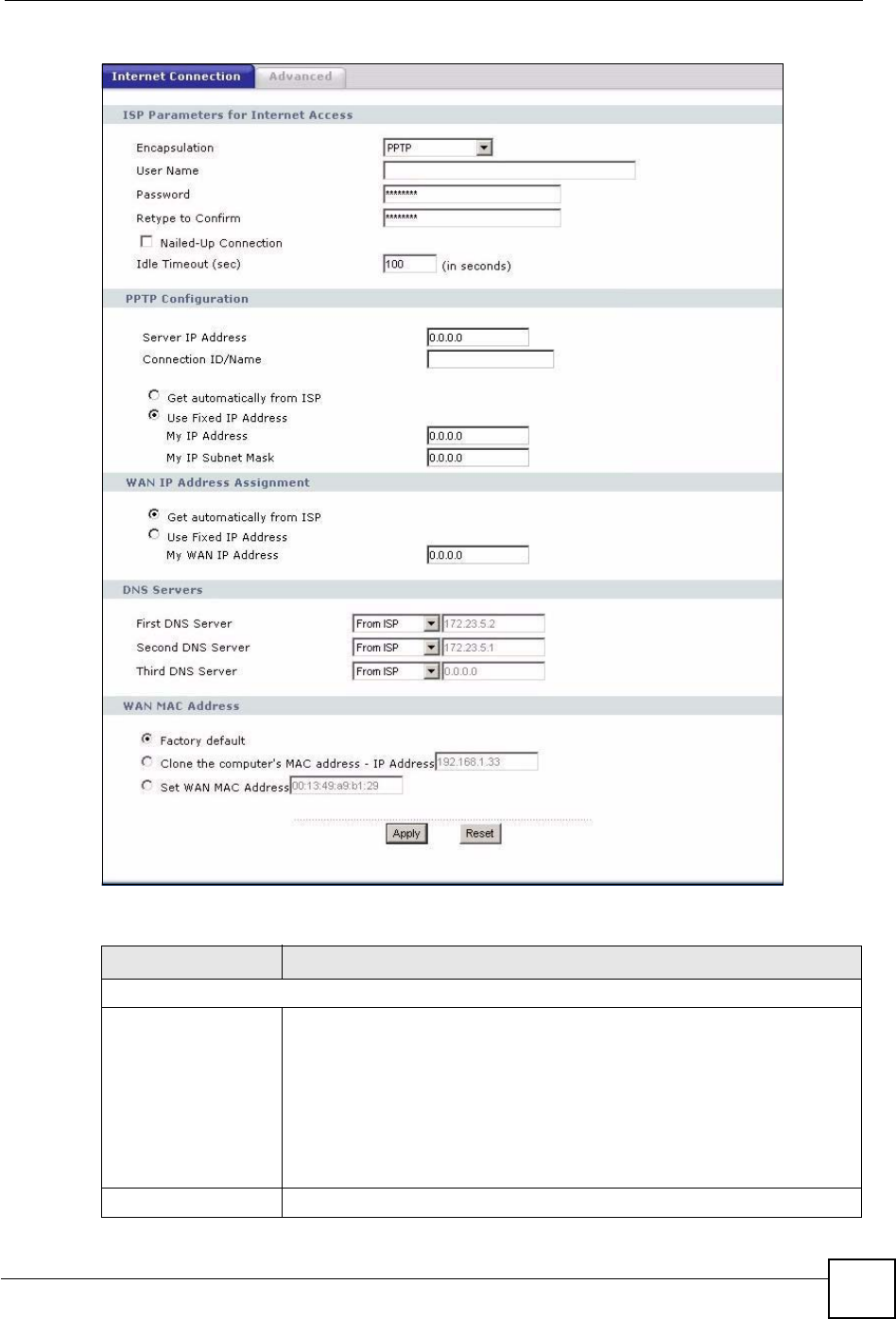
Chapter 8 WAN
NBG420N User’s Guide 123
Figure 80 Network > WAN > Internet Connection: PPTP Encapsulation
The following table describes the labels in this screen.
Table 45 Network > WAN > Internet Connection: PPTP Encapsulation
LABEL DESCRIPTION
ISP Parameters for Internet Access
Encapsulation Point-to-Point Tunneling Protocol (PPTP) is a network protocol that enables
secure transfer of data from a remote client to a private server, creating a
Virtual Private Network (VPN) using TCP/IP-based networks. PPTP supports
on-demand, multi-protocol, and virtual private networking over public
networks, such as the Internet. The NBG420N supports only one PPTP server
connection at any given time.
To configure a PPTP client, you must configure the User Name and
Password fields for a PPP connection and the PPTP parameters for a PPTP
connection.
User Name Type the user name given to you by your ISP.

Chapter 8 WAN
NBG420N User’s Guide
124
Password Type the password associated with the User Name above.
Retype to Confirm Type your password again to make sure that you have entered is correctly.
Nailed-up Connection Select Nailed-Up Connection if you do not want the connection to time out.
Idle Timeout This value specifies the time in seconds that elapses before the NBG420N
automatically disconnects from the PPTP server.
PPTP Configuration
Server IP Address Type the IP address of the PPTP server.
Connection ID/Name Type your identification name for the PPTP server.
Get automatically from
ISP
Select this option If your ISP did not assign you a fixed IP address. This is the
default selection.
Use Fixed IP Address Select this option If the ISP assigned a fixed IP address.
My IP Address Type the (static) IP address assigned to you by your ISP.
My IP Subnet
Mask
Your NBG420N will automatically calculate the subnet mask based on the IP
address that you assign. Unless you are implementing subnetting, use the
subnet mask computed by the NBG420N.
WAN IP Address Assignment
Get automatically from
ISP
Select this option If your ISP did not assign you a fixed IP address. This is the
default selection.
Use Fixed IP Address Select this option If the ISP assigned a fixed IP address.
My WAN IP
Address
Enter your WAN IP address in this field if you selected Use Fixed IP
Address.
DNS Servers
First DNS Server
Second DNS Server
Third DNS Server
Select From ISP if your ISP dynamically assigns DNS server information (and
the NBG420N's WAN IP address). The field to the right displays the (read-
only) DNS server IP address that the ISP assigns.
Select User-Defined if you have the IP address of a DNS server. Enter the
DNS server's IP address in the field to the right. If you chose User-Defined,
but leave the IP address set to 0.0.0.0, User-Defined changes to None after
you click Apply. If you set a second choice to User-Defined, and enter the
same IP address, the second User-Defined changes to None after you click
Apply.
Select None if you do not want to configure DNS servers. If you do not
configure a DNS server, you must know the IP address of a computer in order
to access it.
WAN MAC Address The MAC address section allows users to configure the WAN port's MAC
address by either using the NBG420N’s MAC address, copying the MAC
address from a computer on your LAN or manually entering a MAC address.
Factory default Select Factory default to use the factory assigned default MAC Address.
Clone the computer’s
MAC address
Select Clone the computer's MAC address - IP Address and enter the IP
address of the computer on the LAN whose MAC you are cloning. Once it is
successfully configured, the address will be copied to the rom file (ZyNOS
configuration file). It will not change unless you change the setting or upload a
different ROM file.
Set WAN MAC
Address
Select this option and enter the MAC address you want to use.
Apply Click Apply to save your changes back to the NBG420N.
Reset Click Reset to begin configuring this screen afresh.
Table 45 Network > WAN > Internet Connection: PPTP Encapsulation
LABEL DESCRIPTION
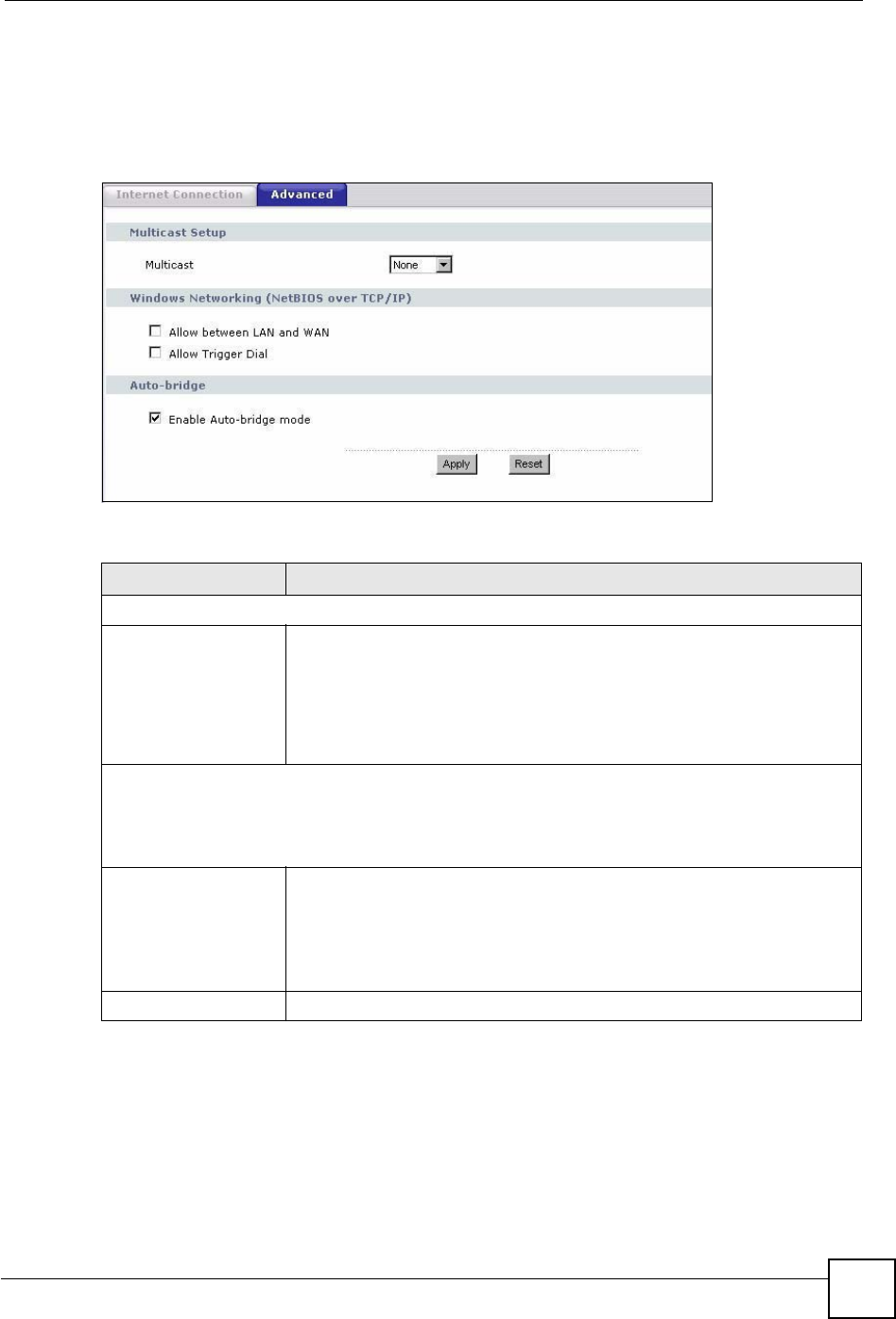
Chapter 8 WAN
NBG420N User’s Guide 125
8.5 Advanced WAN Screen
To change your NBG420N’s advanced WAN settings, click Network > WA N > Advanced.
The screen appears as shown.
Figure 81 Network > WAN > Advanced
The following table describes the labels in this screen.
Table 46 WAN > Advanced
LABEL DESCRIPTION
Multicast Setup
Multicast Select IGMP V-1,IGMP V-2 or None. IGMP (Internet Group Multicast
Protocol) is a network-layer protocol used to establish membership in a
Multicast group - it is not used to carry user data. IGMP version 2 (RFC 2236)
is an improvement over version 1 (RFC 1112) but IGMP version 1 is still in
wide use. If you would like to read more detailed information about
interoperability between IGMP version 2 and version 1, please see sections 4
and 5 of RFC 2236.
Windows Networking (NetBIOS over TCP/IP): NetBIOS (Network Basic Input/Output System) are TCP
or UDP broadcast packets that enable a computer to connect to and communicate with a LAN. For
some dial-up services such as PPPoE or PPTP, NetBIOS packets cause unwanted calls. However it
may sometimes be necessary to allow NetBIOS packets to pass through to the WAN in order to find a
computer on the WAN.
Allow between LAN
and WAN
Select this check box to forward NetBIOS packets from the LAN to the WAN
and from the WAN to the LAN. If your firewall is enabled with the default
policy set to block WAN to LAN traffic, you also need to enable the default
WAN to LAN firewall rule that forwards NetBIOS traffic.
Clear this check box to block all NetBIOS packets going from the LAN to the
WAN and from the WAN to the LAN.
Allow Trigger Dial Select this option to allow NetBIOS packets to initiate calls.

Chapter 8 WAN
NBG420N User’s Guide
126
Enable Auto-bridge
mode
Select this option to have the NBG420N switch to bridge mode automatically
when the NBG420N gets a WAN IP address in the range of 192.168.x.y
(where x and y are from zero to nine) no matter what the LAN IP address is.
This might happen if you put the NBG420N behind a NAT router that assigns
it this IP address. When the NBG420N is in bridge mode, the NBG420N acts
as an AP and all the interfaces (LAN, WAN and WLAN) are bridged. In this
mode, your NAT, DHCP server, firewall and bandwidth management (rules)
on the NBG420N are not available. You do not have to reconfigure them if
you return to router mode.
Note: The NBG420N automatically turns back to Router Mode
when the NBG420N gets a WAN IP address that is not in
the 192.168.x.y range.
Auto-bridging only works under the following conditions:
• The WAN IP must be 192.168.x.y (where x and y must be from zero to
nine). If the LAN IP address and the WAN IP address are in the same
subnet but x or y is greater than nine, the device operates in router mode
(with firewall and bandwidth management available).
• The device must be in Router Mode (see Chapter 24 on page 259 for
more information) for auto-bridging to become active.
Apply Click Apply to save your changes back to the NBG420N.
Reset Click Reset to begin configuring this screen afresh.
Table 46 WAN > Advanced
LABEL DESCRIPTION

NBG420N User’s Guide 127
CHAPTER 9
LAN
This chapter describes how to configure LAN settings.
9.1 LAN Overview
A Local Area Network (LAN) is a shared communication system to which many computers
are attached. A LAN is a computer network limited to the immediate area, usually the same
building or floor of a building. The LAN screens can help you configure a LAN DHCP server,
manage IP addresses, and partition your physical network into logical networks.
9.1.1 IP Pool Setup
The NBG420N is pre-configured with a pool of 32 IP addresses starting from 192.168.1.33 to
192.168.1.64. This configuration leaves 31 IP addresses (excluding the NBG420N itself) in
the lower range (192.168.1.2 to 192.168.1.32) for other server computers, for instance, servers
for mail, FTP, TFTP, web, etc., that you may have.
9.1.2 System DNS Servers
Refer to the IP address and subnet mask section in the Connection Wizard chapter.
9.2 LAN TCP/IP
The NBG420N has built-in DHCP server capability that assigns IP addresses and DNS servers
to systems that support DHCP client capability.
9.2.1 Factory LAN Defaults
The LAN parameters of the NBG420N are preset in the factory with the following values:
• IP address of 192.168.1.1 with subnet mask of 255.255.255.0 (24 bits)
• DHCP server enabled with 32 client IP addresses starting from 192.168.1.33.
These parameters should work for the majority of installations. If your ISP gives you explicit
DNS server address(es), read the embedded web configurator help regarding what fields need
to be configured.

Chapter 9 LAN
NBG420N User’s Guide
128
9.2.2 IP Address and Subnet Mask
Refer to the IP address and subnet mask section in the Connection Wizard chapter for this
information.
9.2.3 Multicast
Traditionally, IP packets are transmitted in one of either two ways - Unicast (1 sender - 1
recipient) or Broadcast (1 sender - everybody on the network). Multicast delivers IP packets to
a group of hosts on the network - not everybody and not just 1.
IGMP (Internet Group Management Protocol) is a network-layer protocol used to establish
membership in a Multicast group - it is not used to carry user data. IGMP version 2 (RFC
2236) is an improvement over version 1 (RFC 1112) but IGMP version 1 is still in wide use. If
you would like to read more detailed information about interoperability between IGMP
version 2 and version 1, please see sections 4 and 5 of RFC 2236. The class D IP address is
used to identify host groups and can be in the range 224.0.0.0 to 239.255.255.255. The address
224.0.0.0 is not assigned to any group and is used by IP multicast computers. The address
224.0.0.1 is used for query messages and is assigned to the permanent group of all IP hosts
(including gateways). All hosts must join the 224.0.0.1 group in order to participate in IGMP.
The address 224.0.0.2 is assigned to the multicast routers group.
The NBG420N supports both IGMP version 1 (IGMP-v1) and IGMP version 2 (IGMP-v2).
At start up, the NBG420N queries all directly connected networks to gather group
membership. After that, the NBG420N periodically updates this information. IP multicasting
can be enabled/disabled on the NBG420N LAN and/or WAN interfaces in the web
configurator (LAN; WAN). Select None to disable IP multicasting on these interfaces.
9.2.4 Any IP
Traditionally, you must set the IP addresses and the subnet masks of a computer and the
NBG420N to be in the same subnet to allow the computer to access the Internet (through the
NBG420N). In cases where your computer is required to use a static IP address in another
network, you may need to manually configure the network settings of the computer every time
you want to access the Internet via the NBG420N.
With the Any IP feature and NAT enabled, the NBG420N allows a computer to access the
Internet without changing the network settings (such as IP address and subnet mask) of the
computer, when the IP addresses of the computer and the NBG420N are not in the same
subnet. Whether a computer is set to use a dynamic or static (fixed) IP address, you can simply
connect the computer to the NBG420N and access the Internet.
The following figure depicts a scenario where a computer is set to use a static private IP
address in the corporate environment. In a residential house where a NBG420N is installed,
you can still use the computer to access the Internet without changing the network settings,
even when the IP addresses of the computer and the NBG420N are not in the same subnet.
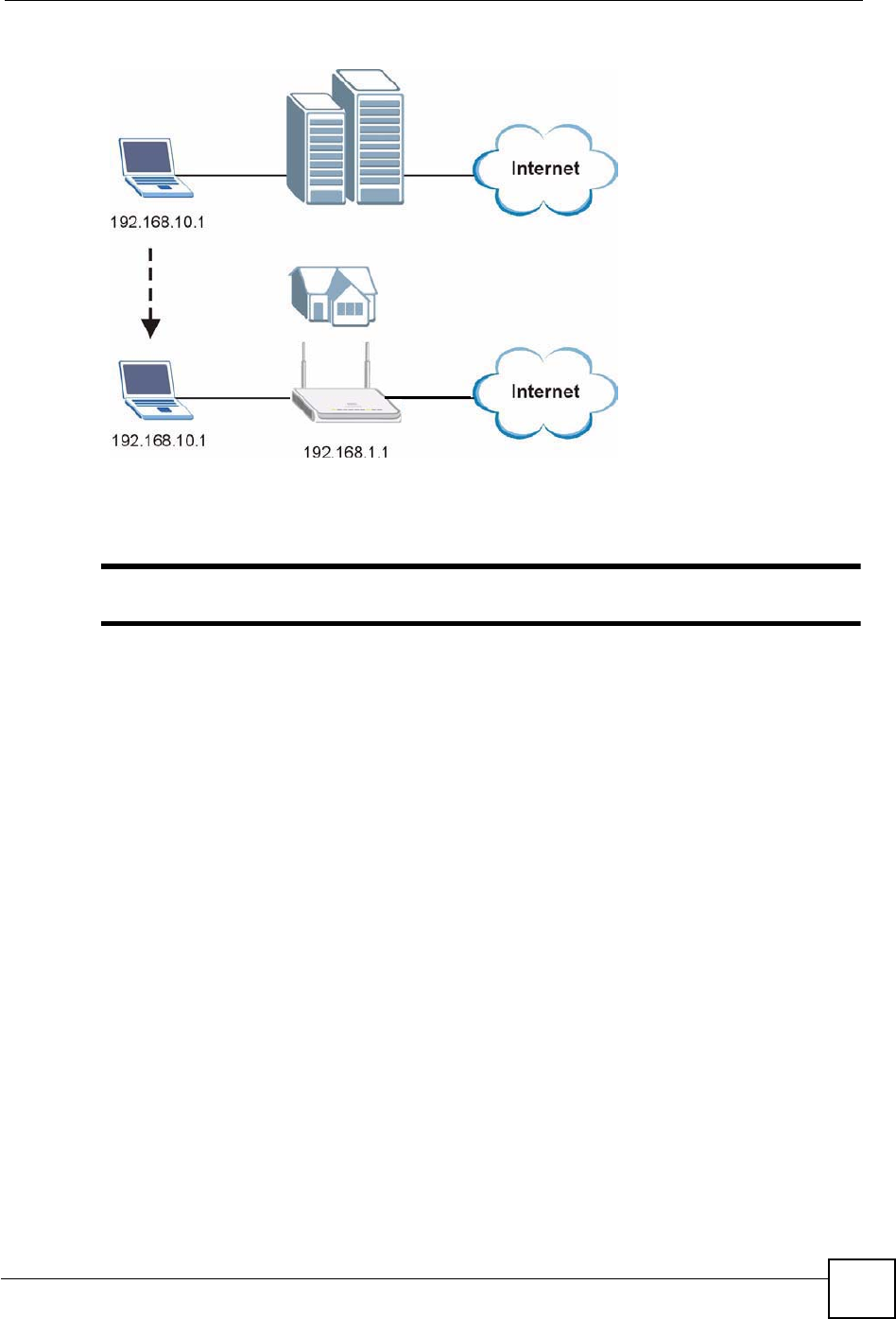
Chapter 9 LAN
NBG420N User’s Guide 129
Figure 82 Any IP Example
The Any IP feature does not apply to a computer using either a dynamic IP address or a static
IP address that is in the same subnet as the NBG420N’s IP address.
"
You must enable NAT to use the Any IP feature on the NBG420N.
Address Resolution Protocol (ARP) is a protocol for mapping an Internet Protocol address (IP
address) to a physical machine address, also known as a Media Access Control or MAC
address, on the local area network. IP routing table is defined on IP Ethernet devices (the
NBG420N) to decide which hop to use, to help forward data along to its specified destination.
The following lists out the steps taken, when a computer tries to access the Internet for the first
time through the NBG420N.
1When a computer (which is in a different subnet) first attempts to access the Internet, it
sends packets to its default gateway (which is not the NBG420N) by looking at the MAC
address in its ARP table.
2When the computer cannot locate the default gateway, an ARP request is broadcast on
the LAN.
3The NBG420N receives the ARP request and replies to the computer with its own MAC
address.
4The computer updates the MAC address for the default gateway to the ARP table. Once
the ARP table is updated, the computer is able to access the Internet through the
NBG420N.
5When the NBG420N receives packets from the computer, it creates an entry in the IP
routing table so it can properly forward packets intended for the computer.
After all the routing information is updated, the computer can access the NBG420N and the
Internet as if it is in the same subnet as the NBG420N.
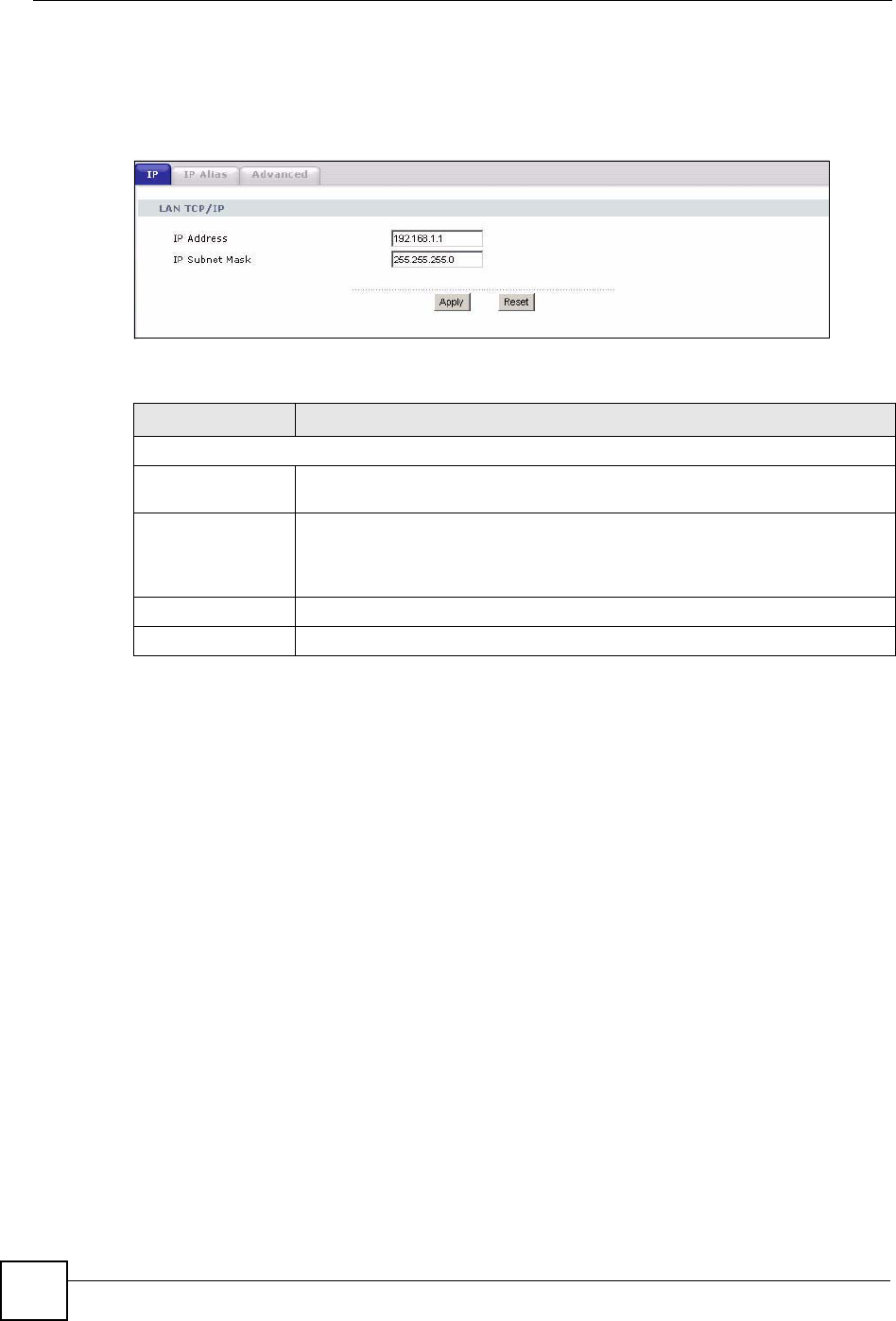
Chapter 9 LAN
NBG420N User’s Guide
130
9.3 LAN IP Screen
Use this screen to change your basic LAN settings. Click Network > LAN.
Figure 83 Network > LAN > IP
The following table describes the labels in this screen.
9.4 LAN IP Alias
IP alias allows you to partition a physical network into different logical networks over the
same Ethernet interface. The NBG420N supports three logical LAN interfaces via its single
physical Ethernet interface with the NBG420N itself as the gateway for each LAN network.
To change your NBG420N’s IP alias settings, click Network > LAN > IP Alias. The screen
appears as shown.
Table 47 Network > LAN > IP
LABEL DESCRIPTION
LAN TCP/IP
IP Address Type the IP address of your NBG420N in dotted decimal notation 192.168.1.1
(factory default).
IP Subnet Mask The subnet mask specifies the network number portion of an IP address. Your
NBG420N will automatically calculate the subnet mask based on the IP address
that you assign. Unless you are implementing subnetting, use the subnet mask
computed by the NBG420N.
Apply Click Apply to save your changes back to the NBG420N.
Reset Click Reset to begin configuring this screen afresh.
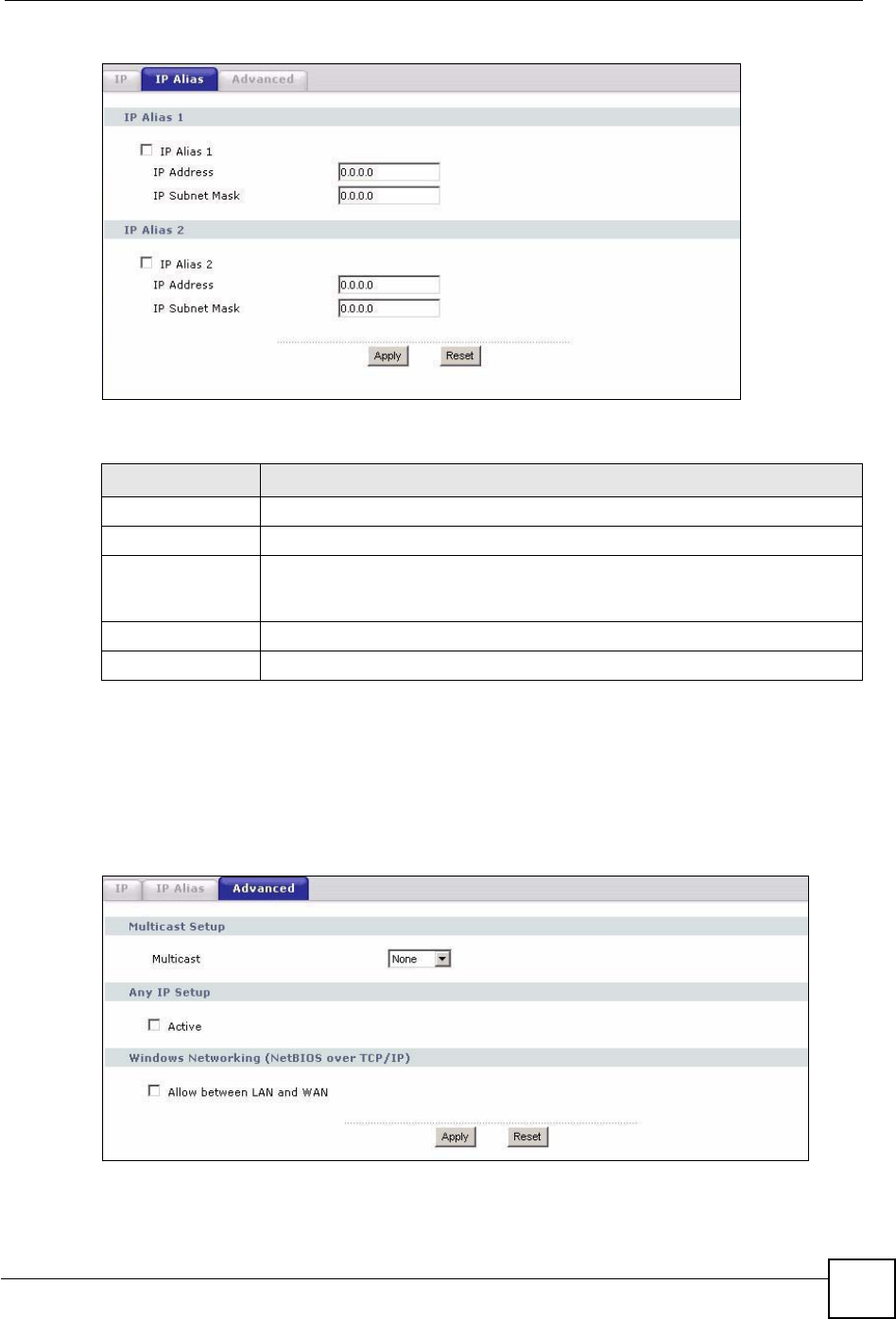
Chapter 9 LAN
NBG420N User’s Guide 131
Figure 84 Network > LAN > IP Alias
The following table describes the labels in this screen.
9.5 Advanced LAN Screen
To change your NBG420N’s advanced IP settings, click Network > LAN > Advanced. The
screen appears as shown.
Figure 85 Network > LAN > Advanced
Table 48 Network > LAN > IP Alias
LABEL DESCRIPTION
IP Alias 1,2 Select the check box to configure another LAN network for the NBG420N.
IP Address Enter the IP address of your NBG420N in dotted decimal notation.
IP Subnet Mask Your NBG420N will automatically calculate the subnet mask based on the IP
address that you assign. Unless you are implementing subnetting, use the
subnet mask computed by the NBG420N.
Apply Click Apply to save your changes back to the NBG420N.
Reset Click Reset to begin configuring this screen afresh.

Chapter 9 LAN
NBG420N User’s Guide
132
The following table describes the labels in this screen.
Table 49 Network > LAN > Advanced
LABEL DESCRIPTION
Multicast Select IGMP V-1 or IGMP V-2 or None. IGMP (Internet Group Multicast
Protocol) is a network-layer protocol used to establish membership in a
Multicast group - it is not used to carry user data. IGMP version 2 (RFC 2236)
is an improvement over version 1 (RFC 1112) but IGMP version 1 is still in
wide use. If you would like to read more detailed information about
interoperability between IGMP version 2 and version 1, please see sections 4
and 5 of RFC 2236.
Any IP Setup
Active Select this if you want to let computers on different subnets use the
NBG420N.
Windows Networking (NetBIOS over TCP/IP): NetBIOS (Network Basic Input/Output System) are TCP
or UDP broadcast packets that enable a computer to connect to and communicate with a LAN. For
some dial-up services such as PPPoE or PPTP, NetBIOS packets cause unwanted calls. However it
may sometimes be necessary to allow NetBIOS packets to pass through to the WAN in order to find a
computer on the WAN.
Allow between LAN
and WAN
Select this check box to forward NetBIOS packets from the LAN to the WAN
and from the WAN to the LAN. If your firewall is enabled with the default policy
set to block WAN to LAN traffic, you also need to enable the default WAN to
LAN firewall rule that forwards NetBIOS traffic.
Clear this check box to block all NetBIOS packets going from the LAN to the
WAN and from the WAN to the LAN.
Apply Click Apply to save your changes back to the NBG420N.
Reset Click Reset to begin configuring this screen afresh.
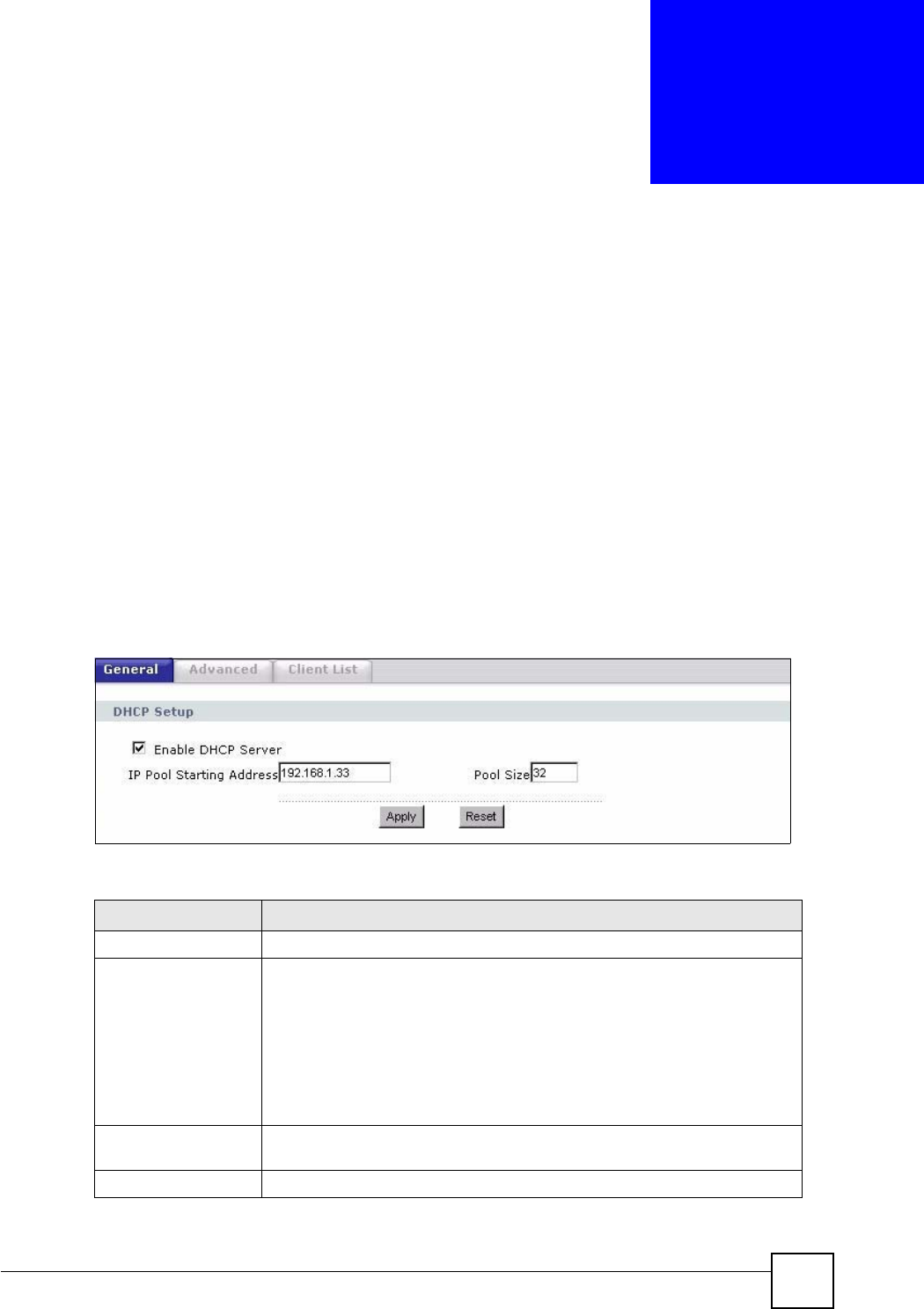
NBG420N User’s Guide 133
CHAPTER 10
DHCP
10.1 DHCP
DHCP (Dynamic Host Configuration Protocol, RFC 2131 and RFC 2132) allows individual
clients to obtain TCP/IP configuration at start-up from a server. You can configure the
NBG420N’s LAN as a DHCP server or disable it. When configured as a server, the NBG420N
provides the TCP/IP configuration for the clients. If DHCP service is disabled, you must have
another DHCP server on your LAN, or else the computer must be manually configured.
10.2 DHCP General Screen
Click Network > DHCP. The following screen displays.
Figure 86 Network > DHCP > General
The following table describes the labels in this screen.
Table 50 Network > DHCP > General
LABEL DESCRIPTION
LAN DHCP Setup
Enable DHCP Server Enable or Disable DHCP for LAN.
DHCP (Dynamic Host Configuration Protocol, RFC 2131 and RFC 2132)
allows individual clients (computers) to obtain TCP/IP configuration at startup
from a server. Leave the Enable DHCP Server check box selected unless
your ISP instructs you to do otherwise. Clear it to disable the NBG420N acting
as a DHCP server. When configured as a server, the NBG420N provides
TCP/IP configuration for the clients. If not, DHCP service is disabled and you
must have another DHCP server on your LAN, or else the computers must be
manually configured. When set as a server, fill in the following four fields.
IP Pool Starting
Address
This field specifies the first of the contiguous addresses in the IP address pool
for LAN.
Pool Size This field specifies the size, or count of the IP address pool for LAN.
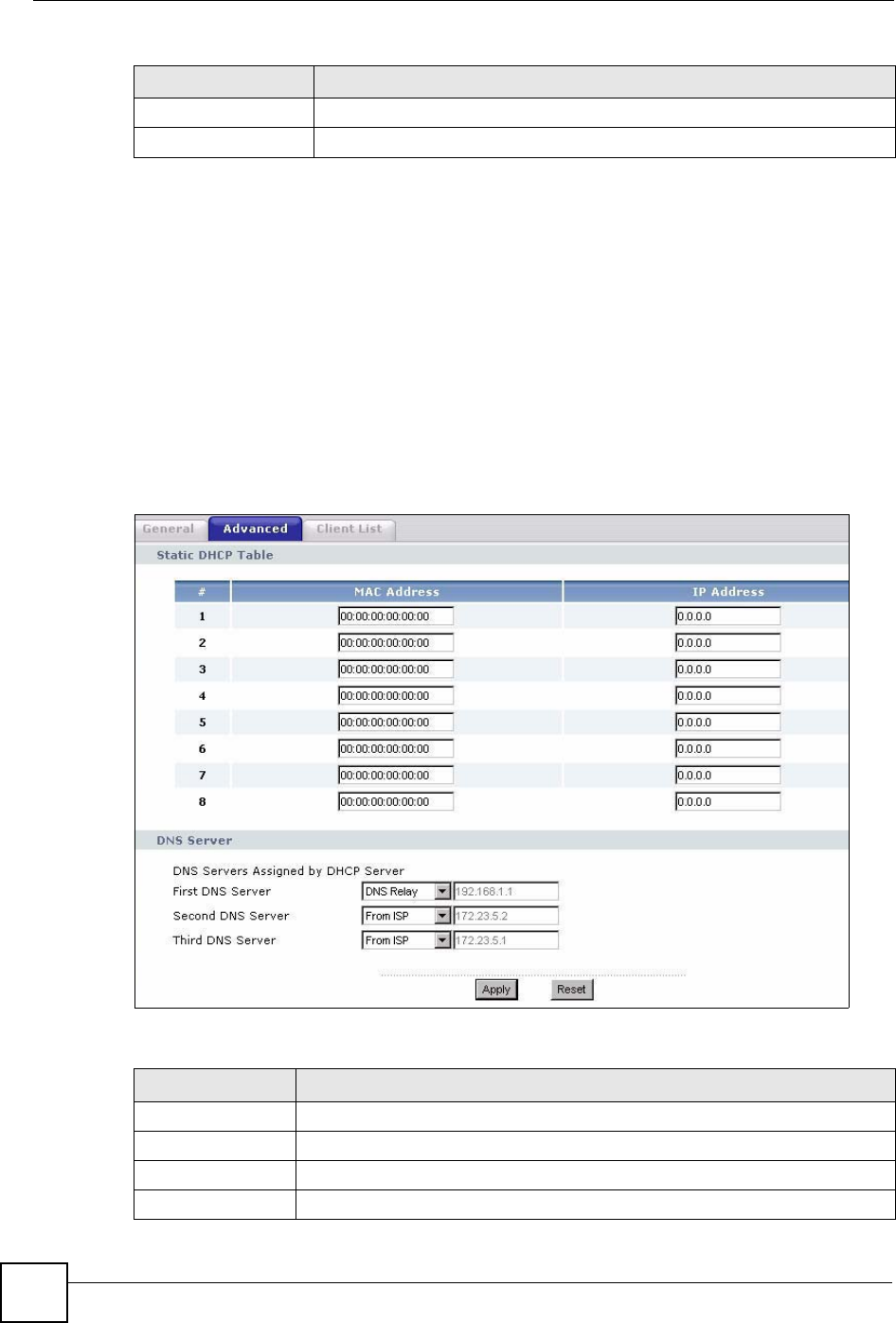
Chapter 10 DHCP
NBG420N User’s Guide
134
10.3 DHCP Advanced Screen
This screen allows you to assign IP addresses on the LAN to specific individual computers
based on their MAC addresses. You can also use this screen to configure the DNS server
information that the NBG420N sends to the DHCP clients.
Every Ethernet device has a unique MAC (Media Access Control) address. The MAC address
is assigned at the factory and consists of six pairs of hexadecimal characters, for example,
00:A0:C5:00:00:02.
To change your NBG420N’s static DHCP settings, click Network > DHCP > Advanced. The
following screen displays.
Figure 87 Network > DHCP > Advanced
The following table describes the labels in this screen.
Apply Click Apply to save your changes back to the NBG420N.
Reset Click Reset to begin configuring this screen afresh.
Table 50 Network > DHCP > General
LABEL DESCRIPTION
Table 51 Network > DHCP > Advanced
LABEL DESCRIPTION
Static DHCP Table
# This is the index number of the static IP table entry (row).
MAC Address Type the MAC address (with colons) of a computer on your LAN.
IP Address Type the LAN IP address of a computer on your LAN.

Chapter 10 DHCP
NBG420N User’s Guide 135
10.4 Client List Screen
The DHCP table shows current DHCP client information (including IP Address,Host Name
and MAC Address) of network clients using the NBG420N’s DHCP servers.
Configure this screen to always assign an IP address to a MAC address (and host name). Click
Network > DHCP Server > Client List.
"
You can also view a read-only client list by clicking the DHCP Table (Details...)
hyperlink in the Status screen.
The following screen displays.
DNS Server
DNS Servers
Assigned by DHCP
Server
The NBG420N passes a DNS (Domain Name System) server IP address (in the
order you specify here) to the DHCP clients. The NBG420N only passes this
information to the LAN DHCP clients when you select the Enable DHCP Server
check box. When you clear the Enable DHCP Server check box, DHCP service
is disabled and you must have another DHCP sever on your LAN, or else the
computers must have their DNS server addresses manually configured.
First DNS Server
Second DNS
Server
Third DNS Server
Select From ISP if your ISP dynamically assigns DNS server information (and
the NBG420N's WAN IP address). The field to the right displays the (read-only)
DNS server IP address that the ISP assigns.
Select User-Defined if you have the IP address of a DNS server. Enter the DNS
server's IP address in the field to the right. If you chose User-Defined, but leave
the IP address set to 0.0.0.0, User-Defined changes to None after you click
Apply. If you set a second choice to User-Defined, and enter the same IP
address, the second User-Defined changes to None after you click Apply.
Select DNS Relay to have the NBG420N act as a DNS proxy. The NBG420N's
LAN IP address displays in the field to the right (read-only). The NBG420N tells
the DHCP clients on the LAN that the NBG420N itself is the DNS server. When a
computer on the LAN sends a DNS query to the NBG420N, the NBG420N
forwards the query to the NBG420N's system DNS server (configured in the
WAN > Internet Connection screen) and relays the response back to the
computer. You can only select DNS Relay for one of the three servers; if you
select DNS Relay for a second or third DNS server, that choice changes to None
after you click Apply.
Select None if you do not want to configure DNS servers. If you do not configure
a DNS server, you must know the IP address of a computer in order to access it.
Apply Click Apply to save your changes back to the NBG420N.
Reset Click Reset to begin configuring this screen afresh.
Table 51 Network > DHCP > Advanced
LABEL DESCRIPTION
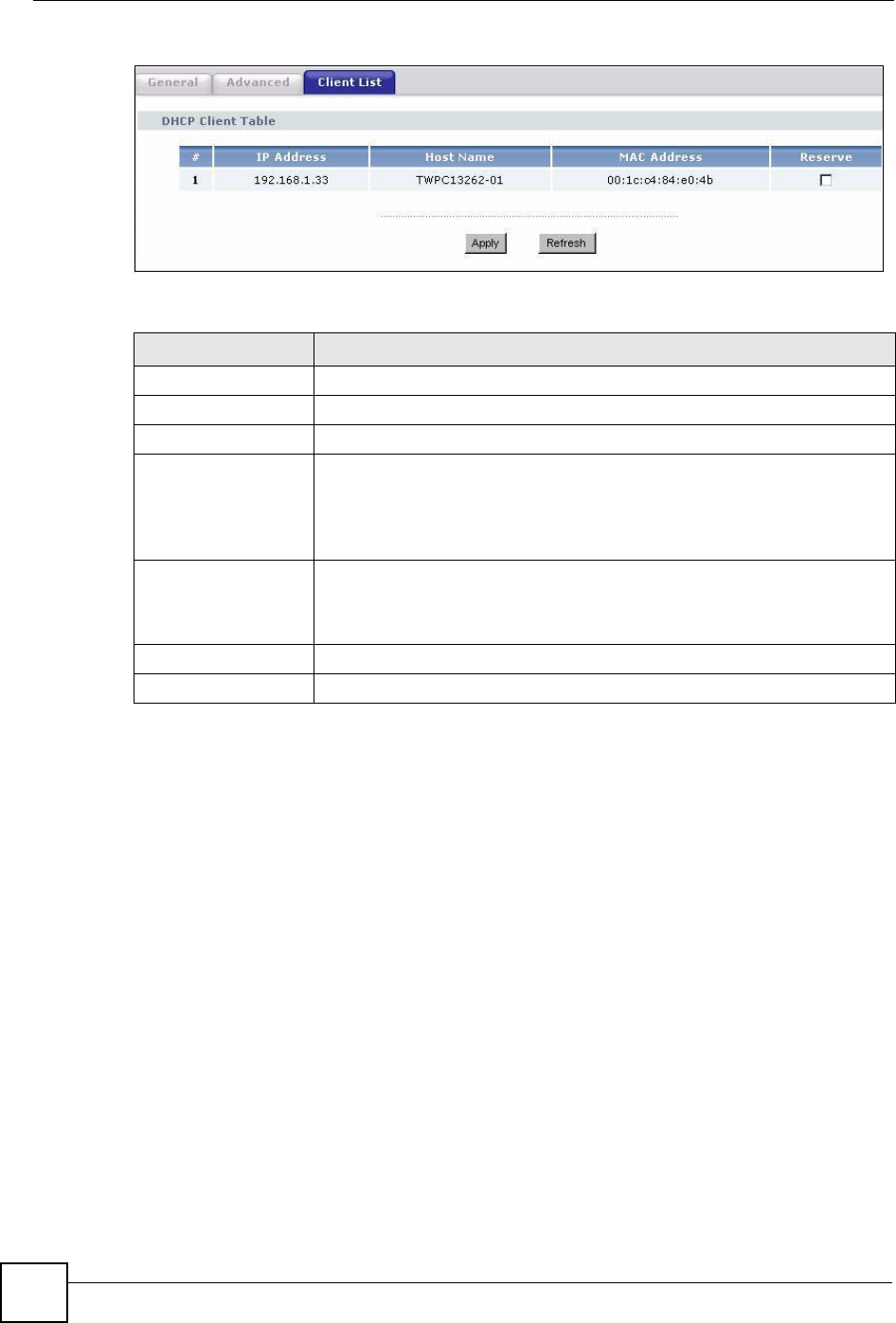
Chapter 10 DHCP
NBG420N User’s Guide
136
Figure 88 Network > DHCP > Client List
The following table describes the labels in this screen.
Table 52 Network > DHCP > Client List
LABEL DESCRIPTION
# This is the index number of the host computer.
IP Address This field displays the IP address relative to the # field listed above.
Host Name This field displays the computer host name.
MAC Address The MAC (Media Access Control) or Ethernet address on a LAN (Local Area
Network) is unique to your computer (six pairs of hexadecimal notation).
A network interface card such as an Ethernet adapter has a hardwired
address that is assigned at the factory. This address follows an industry
standard that ensures no other adapter has a similar address.
Reserve Select this check box in the DHCP Setup section to have the NBG420N
always assign the IP address(es) to the MAC address(es) (and host name(s)).
After you click Apply, the MAC address and IP address also display in the
Advanced screen (where you can edit them).
Apply Click Apply to save your settings.
Refresh Click Refresh to reload the DHCP table.

NBG420N User’s Guide 137
CHAPTER 11
Network Address Translation
(NAT)
This chapter discusses how to configure NAT on the NBG420N.
11.1 NAT Overview
NAT (Network Address Translation - NAT, RFC 1631) is the translation of the IP address of a
host in a packet. For example, the source address of an outgoing packet, used within one
network is changed to a different IP address known within another network.
11.2 Using NAT
"
You must create a firewall rule in addition to setting up NAT, to allow traffic
from the WAN to be forwarded through the NBG420N.
11.2.1 Port Forwarding: Services and Port Numbers
A port forwarding set is a list of inside (behind NAT on the LAN) servers, for example, web or
FTP, that you can make accessible to the outside world even though NAT makes your whole
inside network appear as a single machine to the outside world.
Use the Application screen to forward incoming service requests to the server(s) on your local
network. You may enter a single port number or a range of port numbers to be forwarded, and
the local IP address of the desired server. The port number identifies a service; for example,
web service is on port 80 and FTP on port 21. In some cases, such as for unknown services or
where one server can support more than one service (for example both FTP and web service),
it might be better to specify a range of port numbers.
In addition to the servers for specified services, NAT supports a default server. A service
request that does not have a server explicitly designated for it is forwarded to the default
server. If the default is not defined, the service request is simply discarded.
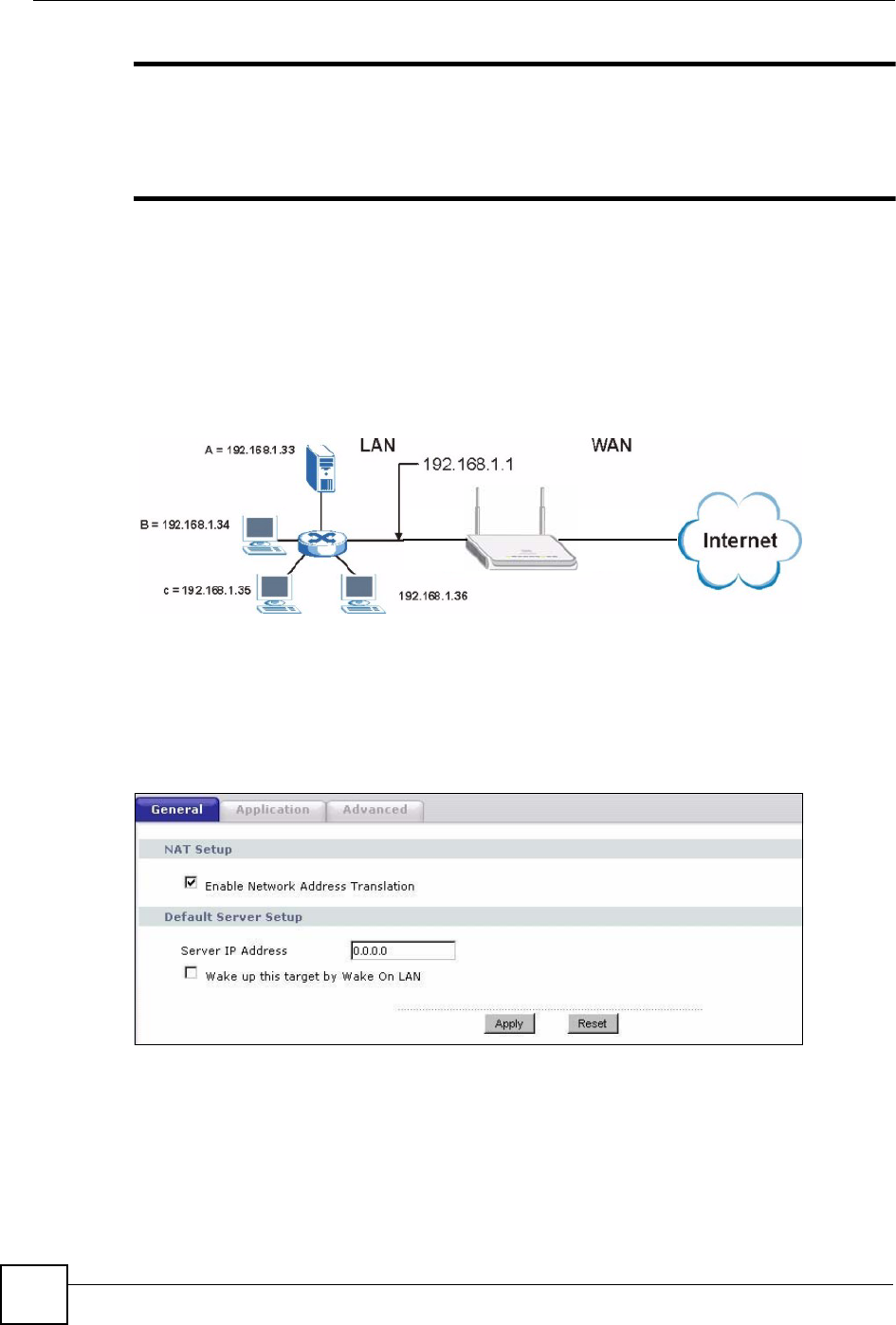
Chapter 11 Network Address Translation (NAT)
NBG420N User’s Guide
138
"
Many residential broadband ISP accounts do not allow you to run any server
processes (such as a Web or FTP server) from your location. Your ISP may
periodically check for servers and may suspend your account if it discovers
any active services at your location. If you are unsure, refer to your ISP.
11.2.2 Configuring Servers Behind Port Forwarding Example
Let's say you want to assign ports 21-25 to one FTP, Telnet and SMTP server (A in the
example), port 80 to another (B in the example) and assign a default server IP address of
192.168.1.35 to a third (C in the example). You assign the LAN IP addresses and the ISP
assigns the WAN IP address. The NAT network appears as a single host on the Internet.
Figure 89 Multiple Servers Behind NAT Example
11.3 General NAT Screen
Click Network > NAT to open the General screen.
Figure 90 Network > NAT > General

Chapter 11 Network Address Translation (NAT)
NBG420N User’s Guide 139
The following table describes the labels in this screen.
11.4 NAT Application Screen
Port forwarding allows you to define the local servers to which the incoming services will be
forwarded. To change your NBG420N’s port forwarding settings, click Network > NAT >
Application. The screen appears as shown.
"
If you do not assign a Default Server IP address in the NAT > General
screen, the NBG420N discards all packets received for ports that are not
specified in this screen or remote management.
Refer to Appendix F on page 321 for port numbers commonly used for particular services.
Table 53 Network > NAT > General
LABEL DESCRIPTION
Enable Network
Address
Translation
Network Address Translation (NAT) allows the translation of an Internet protocol
address used within one network (for example a private IP address used in a local
network) to a different IP address known within another network (for example a
public IP address used on the Internet).
Select the check box to enable NAT.
Default Server
Setup
Server IP
Address
In addition to the servers for specified services, NAT supports a default server. A
default server receives packets from ports that are not specified in the Application
screen.
If you do not assign a Default Server IP address, the NBG420N discards all
packets received for ports that are not specified in the Application screen or
remote management.
Wake up this
target by Wake
On LAN
Select this to use WoL (Wake On LAN) to turn on the server specified in the
Server IP Address field when packets are received on ports not specified in the
Application screen.
Note: For more information on Wake On LAN see Section 22.4 on
page 255.
Apply Click Apply to save your changes back to the NBG420N.
Reset Click Reset to begin configuring this screen afresh.
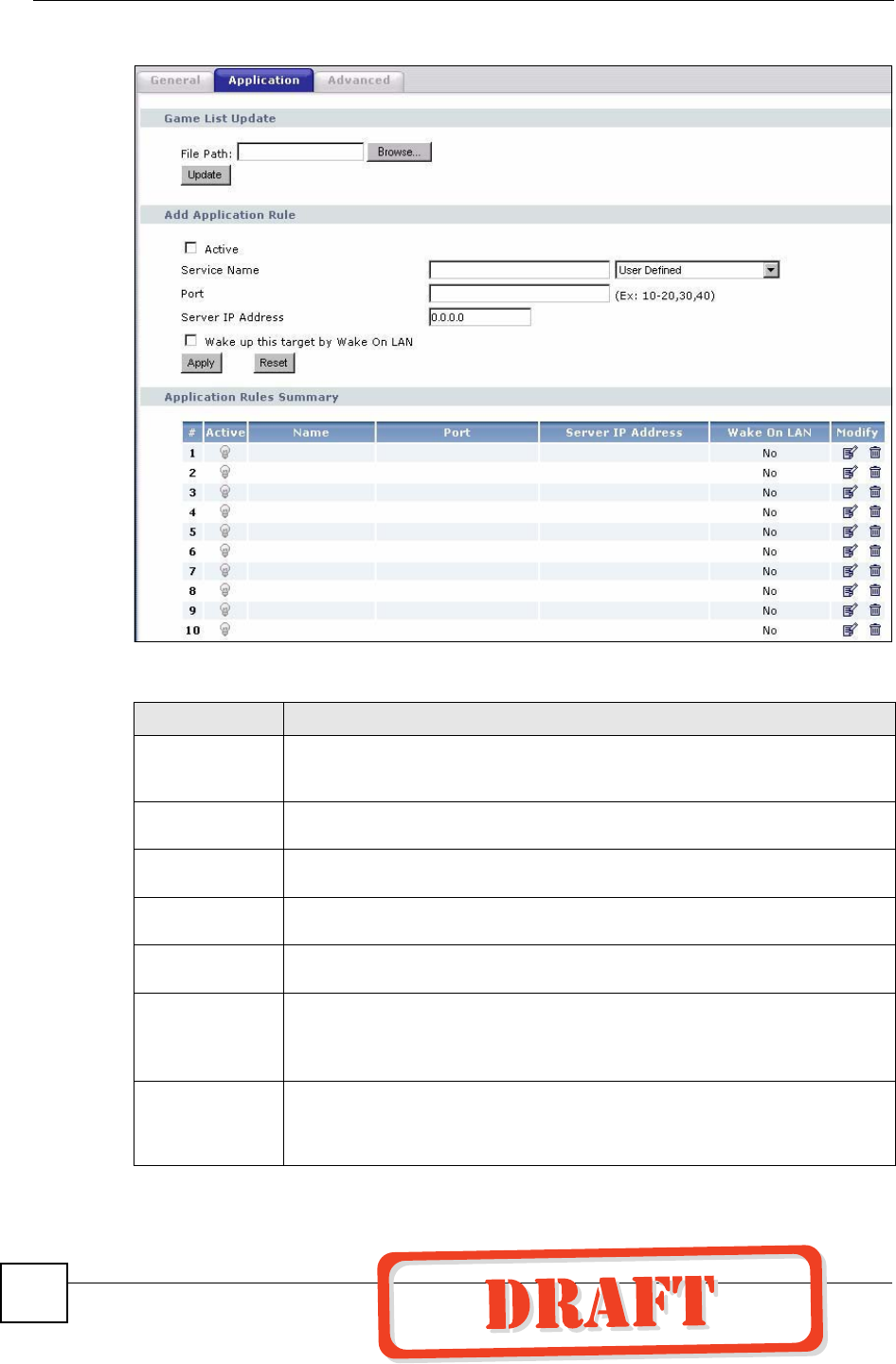
Chapter 11 Network Address Translation (NAT)
NBG420N User’s Guide
140
Figure 91 Network > NAT > Application
The following table describes the labels in this screen.
Table 54 NAT Application
LABEL DESCRIPTION
Game List Update A game list includes the pre-defined service name(s) and port number(s). You can
edit and upload it to the NBG420N to replace the existing entries in the second
field next to Service Name.
File Path Type in the location of the file you want to upload in this field or click Browse... to
find it.
Browse... Click Browse... to find the.txt file you want to upload. Remember that you must
decompress compressed (.zip) files before you can upload them.
Update Click Update to begin the upload process. This process may take up to two
minutes.
Add Application
Rule
Active Select the check box to enable this rule and the requested service can be
forwarded to the host with a specified internal IP address.
Clear the checkbox to disallow forwarding of these ports to an inside server
without having to delete the entry.
Service Name Type a name (of up to 31 printable characters) to identify this rule in the first field
next to Service Name. Otherwise, select a predefined service in the second field
next to Service Name. The predefined service name and port number(s) will
display in the Service Name and Port fields.

Chapter 11 Network Address Translation (NAT)
NBG420N User’s Guide 141
11.4.1 Game List Example
Here is an example game list text file. The index number, service name and associated port(s)
are specified by semi-colons (no spaces). Use the name=xxx (where xxx is the service name)
to create a new service. Port range can be separated with a hyphen (-) (no spaces). Multiple
(non-consecutive) ports can be separated by commas.
Port Type a port number(s) to be forwarded.
To specify a range of ports, enter a hyphen (-) between the first port and the last
port, such as 10-20.
To specify two or more non-consecutive port numbers, separate them by a comma
without spaces, such as 123,567.
Server IP Address Type the inside IP address of the server that receives packets from the port(s)
specified in the Port field.
Wake up this
target by Wake
On LAN
Select this to use WoL (Wake On LAN) to turn on the server specified in the IP
address field when packets are received on the ports specified in the Port field.
Note: For more information on Wake On LAN see Section 22.4 on
page 255.
Apply Click Apply to save your changes to the Application Rules Summary table.
Reset Click Reset to not save and return your new changes in the Service Name and
Port fields to the previous one.
Application Rules
Summary
#This is the number of an individual port forwarding server entry.
Active This icon is turned on when the rule is enabled.
Name This field displays a name to identify this rule.
Port This field displays the port number(s).
Server IP Address This field displays the inside IP address of the server.
Wake On LAN This field displays No when Wake On LAN is disabled and Yes when Wake On
LAN is enabled.
Modify Click the Edit icon to display and modify an existing rule setting in the fields under
Add Application Rule.
Click the Remove icon to delete a rule.
Table 54 NAT Application (continued)
LABEL DESCRIPTION

Chapter 11 Network Address Translation (NAT)
NBG420N User’s Guide
142
Figure 92 Game List Example
11.5 Trigger Port Forwarding
Some services use a dedicated range of ports on the client side and a dedicated range of ports
on the server side. With regular port forwarding you set a forwarding port in NAT to forward a
service (coming in from the server on the WAN) to the IP address of a computer on the client
side (LAN). The problem is that port forwarding only forwards a service to a single LAN IP
address. In order to use the same service on a different LAN computer, you have to manually
replace the LAN computer's IP address in the forwarding port with another LAN computer's IP
address.
Trigger port forwarding solves this problem by allowing computers on the LAN to
dynamically take turns using the service. The NBG420N records the IP address of a LAN
computer that sends traffic to the WAN to request a service with a specific port number and
protocol (a "trigger" port). When the NBG420N's WAN port receives a response with a
specific port number and protocol ("incoming" port), the NBG420N forwards the traffic to the
LAN IP address of the computer that sent the request. After that computer’s connection for
that service closes, another computer on the LAN can use the service in the same manner. This
way you do not need to configure a new IP address each time you want a different LAN
computer to use the application.
11.5.1 Trigger Port Forwarding Example
The following is an example of trigger port forwarding.
version=1
1;name=Battlefield 1942;port=14567,22000,23000-23009,27900,28900
2;name=Call of Duty;port=28960
3;name=Civilization IV;port=2056
4;name=Diablo I and II;port=6112-6119,4000
5;name=Doom 3;port=27666
6;name=F.E.A.R;port=27888
7;name=Final Fantasy XI;port=25,80,110,443,50000-65535
8;name=Guild Wars;port=6112,80
9;name=Half Life;port=6003,7002,27005,27010,27011,27015
10;name=Jedi Knight III: Jedi Academy;port=28060-28062,28070-28081
11;name=Need for Speed: Hot Pursuit 2;port=1230,8511-
8512,27900,28900,61200-61230
12;name=Neverwinter Nights;port=5120-5300,6500,27900,28900
13;name=Quake 2;port=27910
14;name=Quake 3;port=27660,27960
15;name=Rainbow Six 3: Raven Shield;port=7777-7787,8777-8787
16;name=Serious Sam II;port=25600-25605
17;name=Silent Hunter III;port=17997-18003
18;name=Soldier of Fortune II;port=20100-20112
19;name=Starcraft;port=6112-6119,4000
20;name=Star Trek: Elite Force II;port=29250,29256
21;name=SWAT 4;port=10480-10483
22;name=Warcraft II and III;port=6112-6119,4000
23;name=World of Warcraft;port=3724
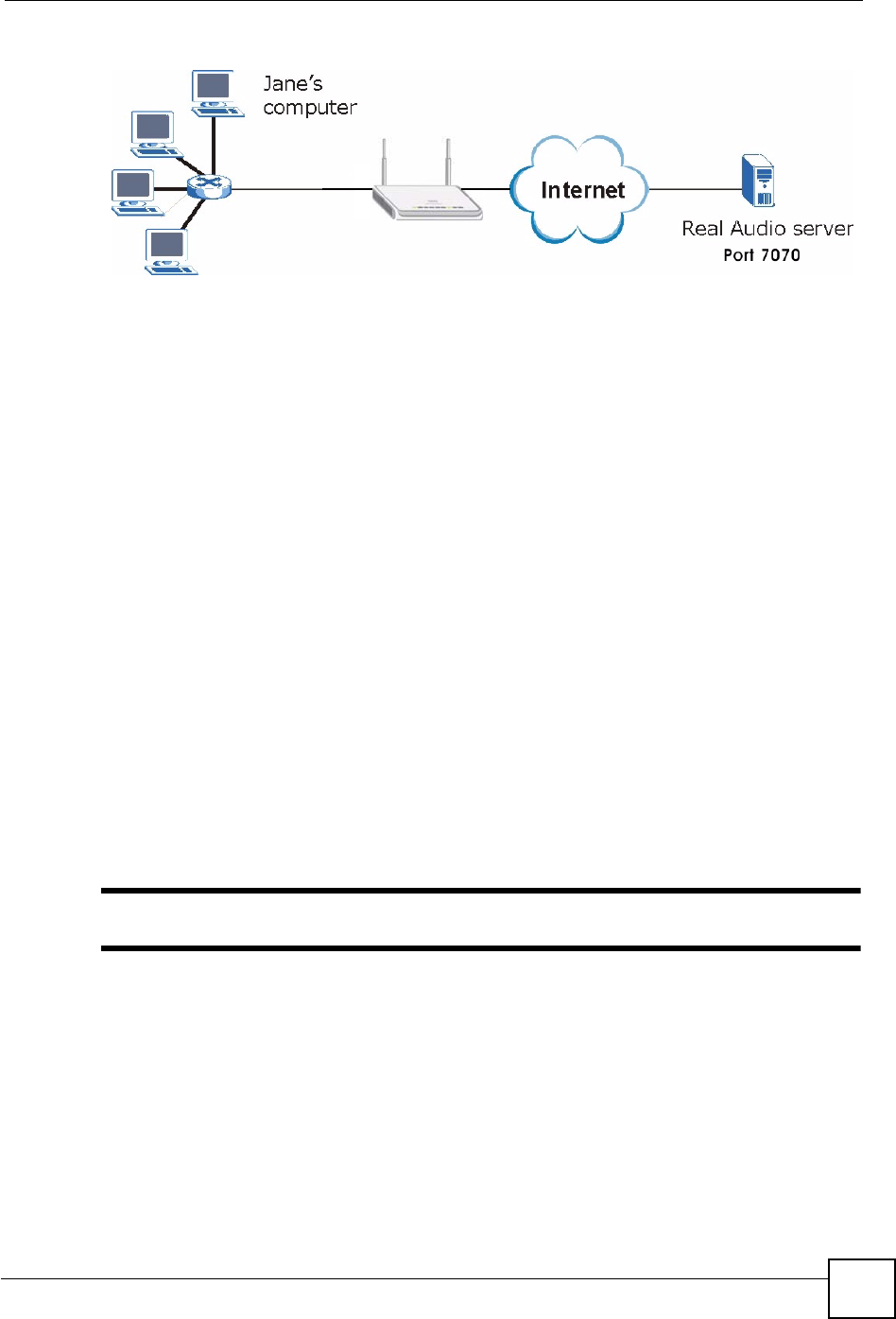
Chapter 11 Network Address Translation (NAT)
NBG420N User’s Guide 143
Figure 93 Trigger Port Forwarding Process: Example
1Jane requests a file from the Real Audio server (port 7070).
2Port 7070 is a “trigger” port and causes the NBG420N to record Jane’s computer IP
address. The NBG420N associates Jane's computer IP address with the "incoming" port
range of 6970-7170.
3The Real Audio server responds using a port number ranging between 6970-7170.
4The NBG420N forwards the traffic to Jane’s computer IP address.
5Only Jane can connect to the Real Audio server until the connection is closed or times
out. The NBG420N times out in three minutes with UDP (User Datagram Protocol), or
two hours with TCP/IP (Transfer Control Protocol/Internet Protocol).
11.5.2 Two Points To Remember About Trigger Ports
1Trigger events only happen on data that is going coming from inside the NBG420N and
going to the outside.
2If an application needs a continuous data stream, that port (range) will be tied up so that
another computer on the LAN can’t trigger it.
11.6 NAT Advanced Screen
To change your NBG420N’s trigger port settings, click Network > NAT > Advanced. The
screen appears as shown.
"
Only one LAN computer can use a trigger port (range) at a time.
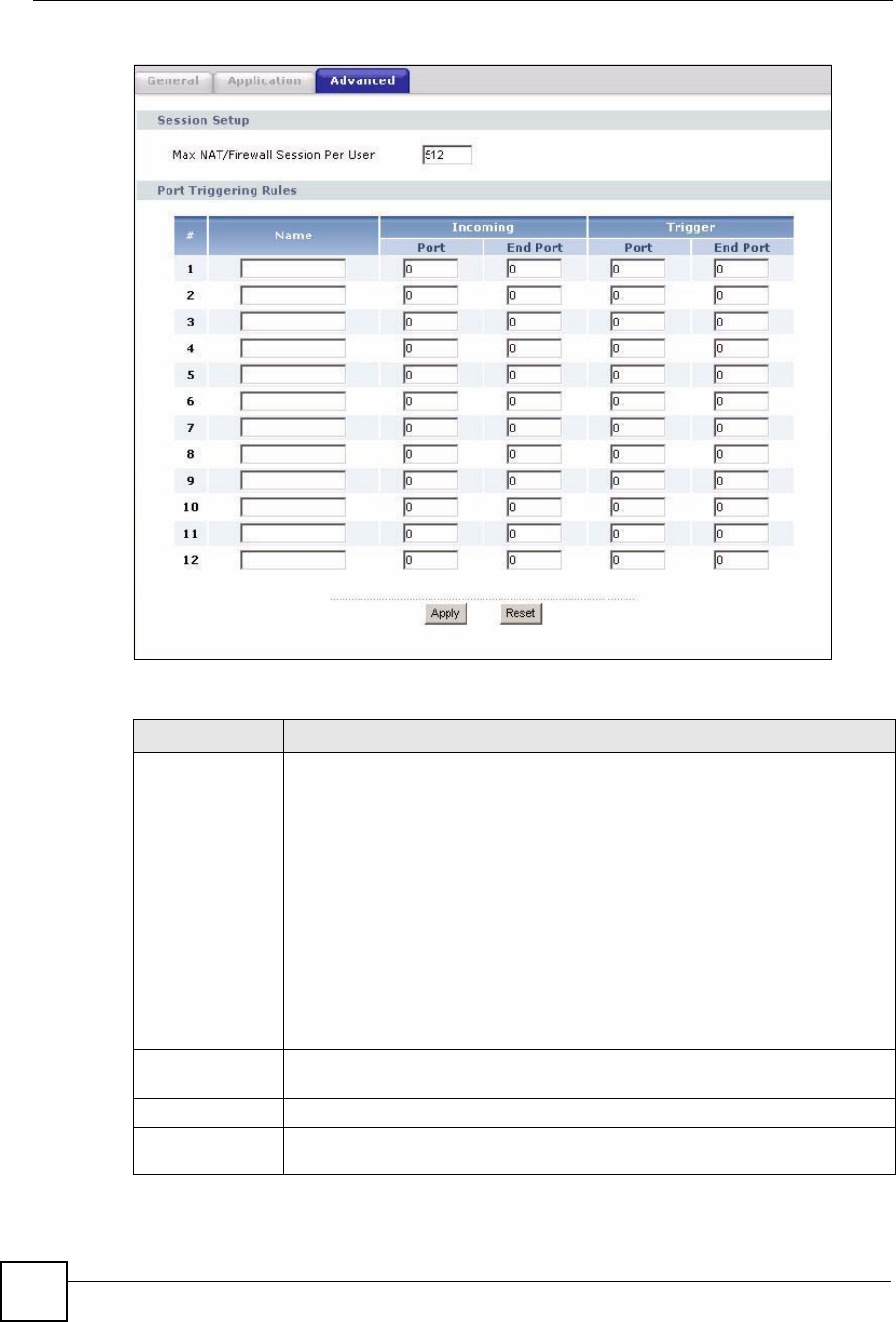
Chapter 11 Network Address Translation (NAT)
NBG420N User’s Guide
144
Figure 94 Network > NAT > Advanced
The following table describes the labels in this screen.
Table 55 Network > NAT > Advanced
LABEL DESCRIPTION
Max NAT/Firewall
Session Per User
Type a number ranging from 1 to 2048 to limit the number of NAT/firewall sessions
that a host can create.
When computers use peer to peer applications, such as file sharing
applications, they may use a large number of NAT sessions. If you do not
limit the number of NAT sessions a single client can establish, this can result in all
of the available NAT sessions being used. In this case, no additional NAT sessions
can be established, and users may not be able to access the Internet.
Each NAT session establishes a corresponding firewall session. Use this field to
limit the number of NAT/firewall sessions each client computer can establish
through the NBG420N.
If your network has a small number of clients using peer to peer applications, you
can raise this number to ensure that their performance is not degraded by the
number of NAT sessions they can establish. If your network has a large number of
users using peer to peer applications, you can lower this number to ensure no
single client is using all of the available NAT sessions.
Port Triggering
Rules
#This is the rule index number (read-only).
Name Type a unique name (up to 15 characters) for identification purposes. All
characters are permitted - including spaces.

Chapter 11 Network Address Translation (NAT)
NBG420N User’s Guide 145
Incoming Incoming is a port (or a range of ports) that a server on the WAN uses when it
sends out a particular service. The NBG420N forwards the traffic with this port (or
range of ports) to the client computer on the LAN that requested the service.
Start Port Type a port number or the starting port number in a range of port numbers.
End Port Type a port number or the ending port number in a range of port numbers.
Trigger The trigger port is a port (or a range of ports) that causes (or triggers) the
NBG420N to record the IP address of the LAN computer that sent the traffic to a
server on the WAN.
Start Port Type a port number or the starting port number in a range of port numbers.
End Port Type a port number or the ending port number in a range of port numbers.
Apply Click Apply to save your changes back to the NBG420N.
Reset Click Reset to begin configuring this screen afresh.
Table 55 Network > NAT > Advanced
LABEL DESCRIPTION

Chapter 11 Network Address Translation (NAT)
NBG420N User’s Guide
146

NBG420N User’s Guide 147
CHAPTER 12
Dynamic DNS
12.1 Dynamic DNS Introduction
Dynamic DNS allows you to update your current dynamic IP address with one or many
dynamic DNS services so that anyone can contact you (in NetMeeting, CU-SeeMe, etc.). You
can also access your FTP server or Web site on your own computer using a domain name (for
instance myhost.dhs.org, where myhost is a name of your choice) that will never change
instead of using an IP address that changes each time you reconnect. Your friends or relatives
will always be able to call you even if they don't know your IP address.
First of all, you need to have registered a dynamic DNS account with www.dyndns.org. This is
for people with a dynamic IP from their ISP or DHCP server that would still like to have a
domain name. The Dynamic DNS service provider will give you a password or key.
12.1.1 DynDNS Wildcard
Enabling the wildcard feature for your host causes *.yourhost.dyndns.org to be aliased to the
same IP address as yourhost.dyndns.org. This feature is useful if you want to be able to use,
for example, www.yourhost.dyndns.org and still reach your hostname.
"
If you have a private WAN IP address, then you cannot use Dynamic DNS.
12.2 Dynamic DNS Screen
To change your NBG420N’s DDNS, click Network > DDNS. The screen appears as shown.
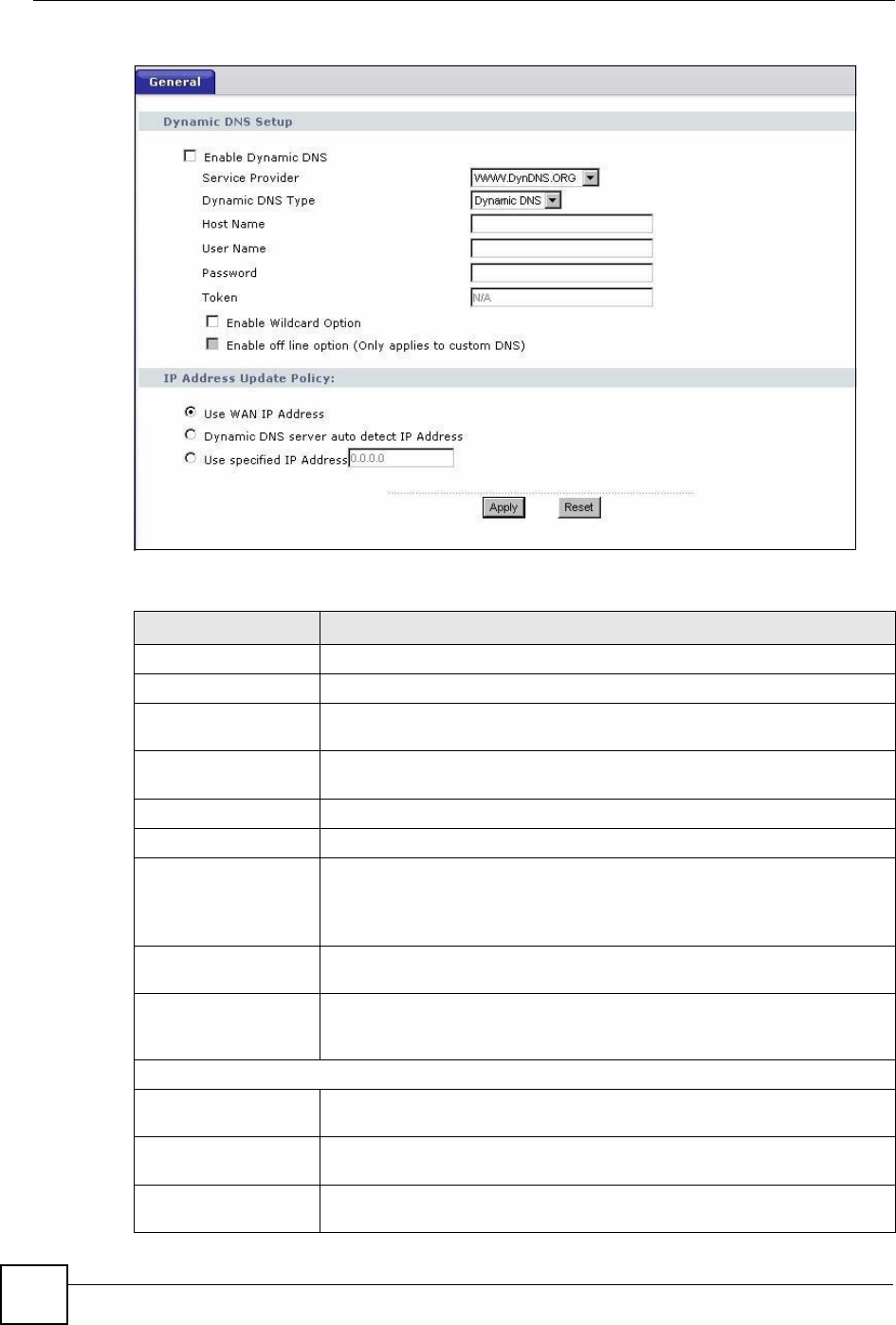
Chapter 12 Dynamic DNS
NBG420N User’s Guide
148
Figure 95 Dynamic DNS
The following table describes the labels in this screen.
Table 56 Dynamic DNS
LABEL DESCRIPTION
Enable Dynamic DNS Select this check box to use dynamic DNS.
Service Provider Select the name of your Dynamic DNS service provider.
Dynamic DNS Type Select the type of service that you are registered for from your Dynamic DNS
service provider.
Host Name Enter a host names in the field provided. You can specify up to two host
names in the field separated by a comma (",").
User Name Enter your user name.
Password Enter the password assigned to you.
Token Enter your client authorization key provided by the server to update DynDNS
records.
This field is configurable only when you select WWW.REGFISH.COM in the
Service Provider field.
Enable Wildcard
Option
Select the check box to enable DynDNS Wildcard.
Enable off line option This option is available when CustomDNS is selected in the DDNS Type
field. Check with your Dynamic DNS service provider to have traffic
redirected to a URL (that you can specify) while you are off line.
IP Address Update Policy:
Use WAN IP Address Select this option to update the IP address of the host name(s) to the WAN IP
address.
Dynamic DNS server
auto detect IP Address
Select this option to update the IP address of the host name(s) automatically
by the DDNS server. It is recommended that you select this option.
Use specified IP
Address
Type the IP address of the host name(s). Use this if you have a static IP
address.

Chapter 12 Dynamic DNS
NBG420N User’s Guide 149
Apply Click Apply to save your changes back to the NBG420N.
Reset Click Reset to begin configuring this screen afresh.
Table 56 Dynamic DNS
LABEL DESCRIPTION

Chapter 12 Dynamic DNS
NBG420N User’s Guide
150

151
PART III
Security
Firewall (153)
Content Filtering (161)
IPSec VPN (165)

152

NBG420N User’s Guide 153
CHAPTER 13
Firewall
This chapter gives some background information on firewalls and explains how to get started
with the NBG420N’s firewall.
13.1 Introduction to ZyXEL’s Firewall
13.1.1 What is a Firewall?
Originally, the term “firewall” referred to a construction technique designed to prevent the
spread of fire from one room to another. The networking term "firewall" is a system or group
of systems that enforces an access-control policy between two networks. It may also be
defined as a mechanism used to protect a trusted network from a network that is not trusted. Of
course, firewalls cannot solve every security problem. A firewall is one of the mechanisms
used to establish a network security perimeter in support of a network security policy. It should
never be the only mechanism or method employed. For a firewall to guard effectively, you
must design and deploy it appropriately. This requires integrating the firewall into a broad
information-security policy. In addition, specific policies must be implemented within the
firewall itself.
13.1.2 Stateful Inspection Firewall
Stateful inspection firewalls restrict access by screening data packets against defined access
rules. They make access control decisions based on IP address and protocol. They also
"inspect" the session data to assure the integrity of the connection and to adapt to dynamic
protocols. These firewalls generally provide the best speed and transparency; however, they
may lack the granular application level access control or caching that some proxies support.
Firewalls, of one type or another, have become an integral part of standard security solutions
for enterprises.
13.1.3 About the NBG420N Firewall
The NBG420N firewall is a stateful inspection firewall and is designed to protect against
Denial of Service attacks when activated (click the General tab under Firewall and then click
the Enable Firewall check box). The NBG420N's purpose is to allow a private Local Area
Network (LAN) to be securely connected to the Internet. The NBG420N can be used to
prevent theft, destruction and modification of data, as well as log events, which may be
important to the security of your network.

Chapter 13 Firewall
NBG420N User’s Guide
154
The NBG420N is installed between the LAN and a broadband modem connecting to the
Internet. This allows it to act as a secure gateway for all data passing between the Internet and
the LAN.
The NBG420N has one Ethernet WAN port and four Ethernet LAN ports, which are used to
physically separate the network into two areas.The WAN (Wide Area Network) port attaches
to the broadband (cable or DSL) modem to the Internet.
The LAN (Local Area Network) port attaches to a network of computers, which needs security
from the outside world. These computers will have access to Internet services such as e-mail,
FTP and the World Wide Web. However, "inbound access" is not allowed (by default) unless
the remote host is authorized to use a specific service.
13.1.4 Guidelines For Enhancing Security With Your Firewall
1Change the default password via web configurator.
2Think about access control before you connect to the network in any way, including
attaching a modem to the port.
3Limit who can access your router.
4Don't enable any local service (such as SNMP or NTP) that you don't use. Any enabled
service could present a potential security risk. A determined hacker might be able to find
creative ways to misuse the enabled services to access the firewall or the network.
5For local services that are enabled, protect against misuse. Protect by configuring the
services to communicate only with specific peers, and protect by configuring rules to
block packets for the services at specific interfaces.
6Protect against IP spoofing by making sure the firewall is active.
7Keep the firewall in a secured (locked) room.
13.2 Triangle Routes
If an alternate gateway on the LAN has an IP address in the same subnet as the NBG420N’s
LAN IP address, return traffic may not go through the NBG420N. This is called an
asymmetrical or “triangle” route. This causes the NBG420N to reset the connection, as the
connection has not been acknowledged.
You can have the NBG420N permit the use of asymmetrical route topology on the network
(not reset the connection).
Allowing asymmetrical routes may let traffic from the WAN go directly to the LAN without
passing through the NBG420N. A better solution is to use IP alias to put the NBG420N and
the backup gateway on separate subnets.
13.2.1 Triangle Routes and IP Alias
You can use IP alias instead of allowing triangle routes. IP Alias allow you to partition your
network into logical sections over the same interface.
By putting your LAN and Gateway A in different subnets, all returning network traffic must
pass through the NBG420N to your LAN. The following steps describe such a scenario.
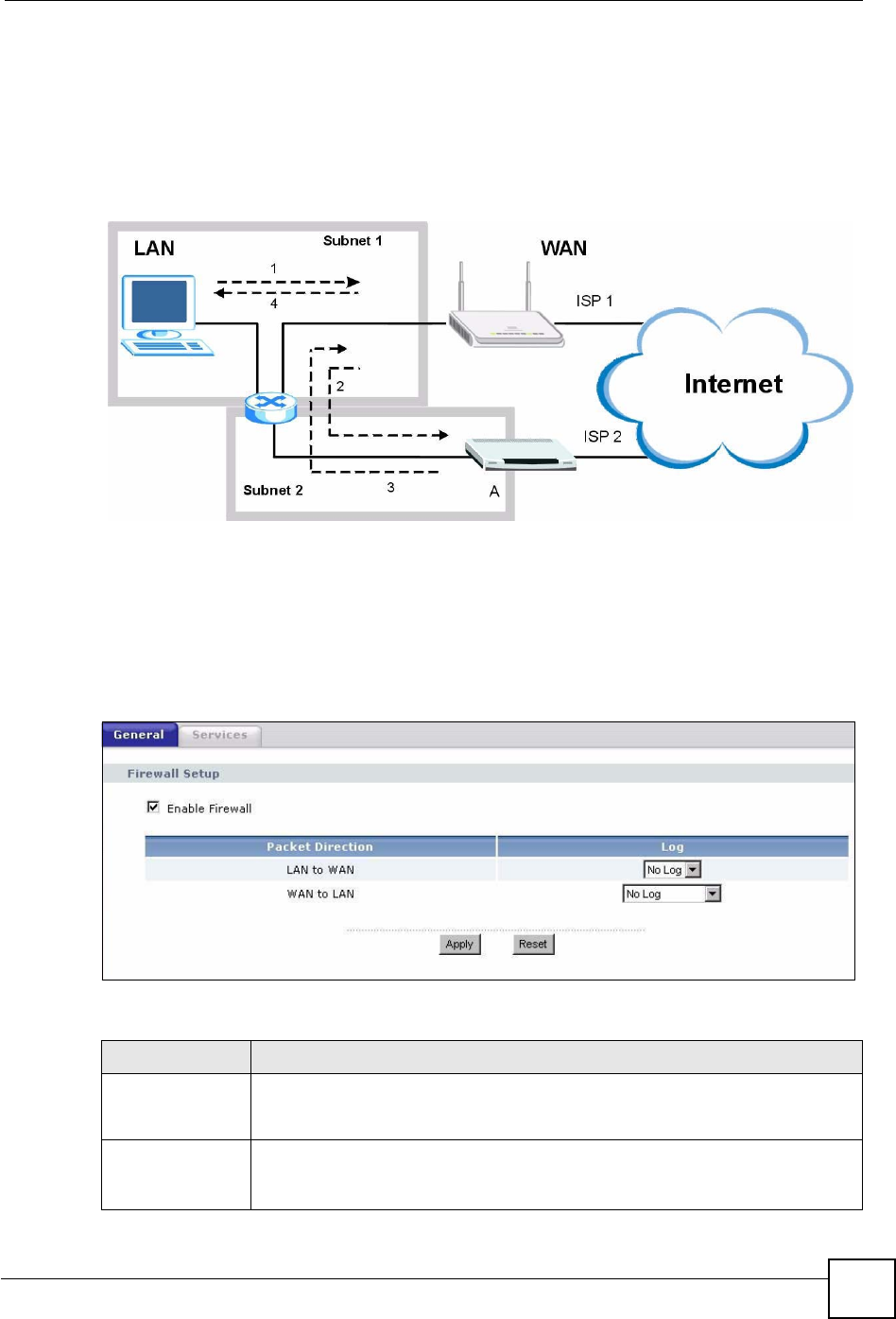
Chapter 13 Firewall
NBG420N User’s Guide 155
1A computer on the LAN initiates a connection by sending a SYN packet to a receiving
server on the WAN.
2The NBG420N reroutes the packet to Gateway A, which is in Subnet 2.
3The reply from the WAN goes to the NBG420N.
4The NBG420N then sends it to the computer on the LAN in Subnet 1.
Figure 96 Using IP Alias to Solve the Triangle Route Problem
13.3 General Firewall Screen
Click Security > Firewall to open the General screen. Use this screen to enable or disable the
NBG420N’s firewall, and set up firewall logs.
Figure 97 Security > Firewall > General l
The following table describes the labels in this screen.
Table 57 Security > Firewall > General
LABEL DESCRIPTION
Enable Firewall Select this check box to activate the firewall. The NBG420N performs access
control and protects against Denial of Service (DoS) attacks when the firewall is
activated.
Packet Direction This is the direction of travel of packets.
Firewall rules are grouped based on the direction of travel of packets to which they
apply.
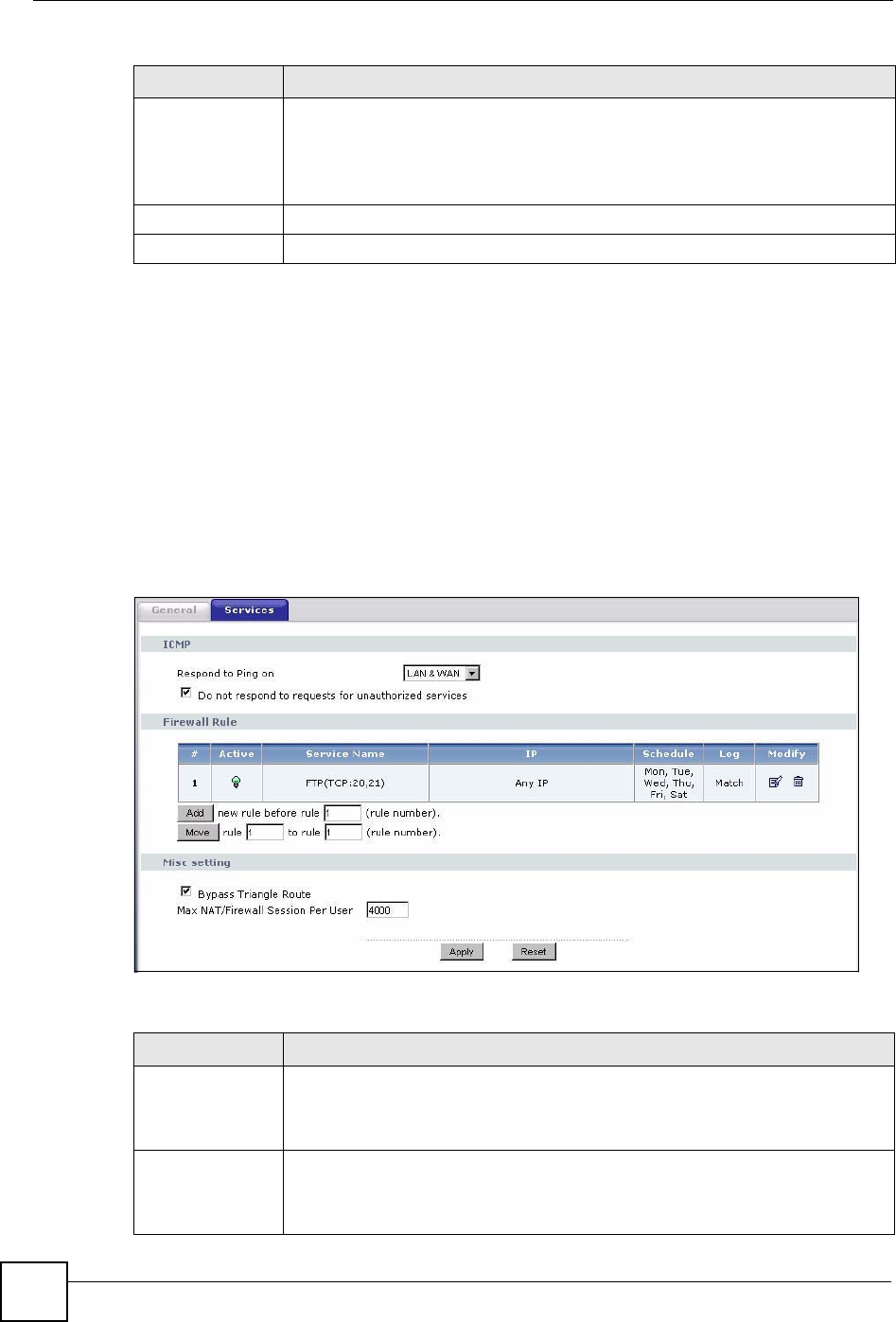
Chapter 13 Firewall
NBG420N User’s Guide
156
13.4 Services Screen
Click Security > Firewall > Services. The screen appears as shown next.
If an outside user attempts to probe an unsupported port on your NBG420N, an ICMP
response packet is automatically returned. This allows the outside user to know the NBG420N
exists. Use this screen to prevent the ICMP response packet from being sent. This keeps
outsiders from discovering your NBG420N when unsupported ports are probed.
You can also use this screen to enable service blocking, enter/delete/modify the services you
want to block and the date/time you want to block them.
Figure 98 Security > Firewall > Services
The following table describes the labels in this screen.
Log Select whether to create a log for packets that are traveling in the selected
direction when the packets are blocked (Log All) or forwarded (Log Forward). Or
select Not Log to not log any records.
To log packets related to firewall rules, make sure that Access Control under Log
is selected in the Logs > Log Settings screen.
Apply Click Apply to save the settings.
Reset Click Reset to start configuring this screen again.
Table 57 Security > Firewall > General
LABEL DESCRIPTION
Table 58 Security > Firewall > Services
LABEL DESCRIPTION
ICMP Internet Control Message Protocol is a message control and error-reporting
protocol between a host server and a gateway to the Internet. ICMP uses Internet
Protocol (IP) datagrams, but the messages are processed by the TCP/IP software
and directly apparent to the application user.
Respond to Ping
on
The NBG420N will not respond to any incoming Ping requests when Disable is
selected. Select LAN to reply to incoming LAN Ping requests. Select WAN to reply
to incoming WAN Ping requests. Otherwise select LAN & WAN to reply to all
incoming LAN and WAN Ping requests.

Chapter 13 Firewall
NBG420N User’s Guide 157
13.4.1 The Add Firewall Rule Screen
If you click Add or the Modify icon on an existing rule, the Add Firewall Rule screen is
displayed. Use this screen to add a firewall rule or to modify an existing one.
Do not respond to
requests for
unauthorized
services
Select this option to prevent hackers from finding the NBG420N by probing for
unused ports. If you select this option, the NBG420N will not respond to port
request(s) for unused ports, thus leaving the unused ports and the NBG420N
unseen. By default this option is not selected and the NBG420N will reply with an
ICMP Port Unreachable packet for a port probe on its unused UDP ports, and a
TCP Reset packet for a port probe on its unused TCP ports.
Note that the probing packets must first traverse the NBG420N's firewall
mechanism before reaching this anti-probing mechanism. Therefore if the firewall
mechanism blocks a probing packet, the NBG420N reacts based on the firewall
policy, which by default, is to send a TCP reset packet for a blocked TCP packet.
You can use the command "sys firewall tcprst rst [on|off]" to change this policy.
When the firewall mechanism blocks a UDP packet, it drops the packet without
sending a response packet.
Firewall Rule
# This is your firewall rule number. The ordering of your rules is important as rules
are applied in turn. Use the Move button to rearrange the order of the rules.
Active This icon is green when the rule is turned on. The icon is grey when the rule is
turned off.
Service Name This field displays the services and port numbers to which this firewall rule applies.
IP This field displays the IP address(es) the rule applies to.
Schedule This field displays the days the firewall rule is active.
Log This field shows you whether a log will be created when packets match the rule
(Match) or not (No).
Modify Click the Edit icon to modify an existing rule setting in the fields under the Add
Firewall Rule screen.
Click the Remove icon to delete a rule. Note that subsequent firewall rules move
up by one when you take this action.
Add Click the Add button to display the screen where you can configure a new firewall
rule. Modify the number in the textbox to add the rule before a specific rule
number.
Move The Move button moves a rule to a different position. In the first text box enter the
number of the rule you wish to move. In the second text box enter the number of
the rule you wish to move the first rule to and click the Move button.
Misc setting
Bypass Triangle
Route
Select this check box to have the NBG420N firewall ignore the use of triangle
route topology on the network.
Max NAT/Firewall
Session Per User
Type a number ranging from 1 to 2048 to limit the number of NAT/firewall sessions
that a host can create.
Apply Click Apply to save the settings.
Reset Click Reset to start configuring this screen again.
Table 58 Security > Firewall > Services
LABEL DESCRIPTION
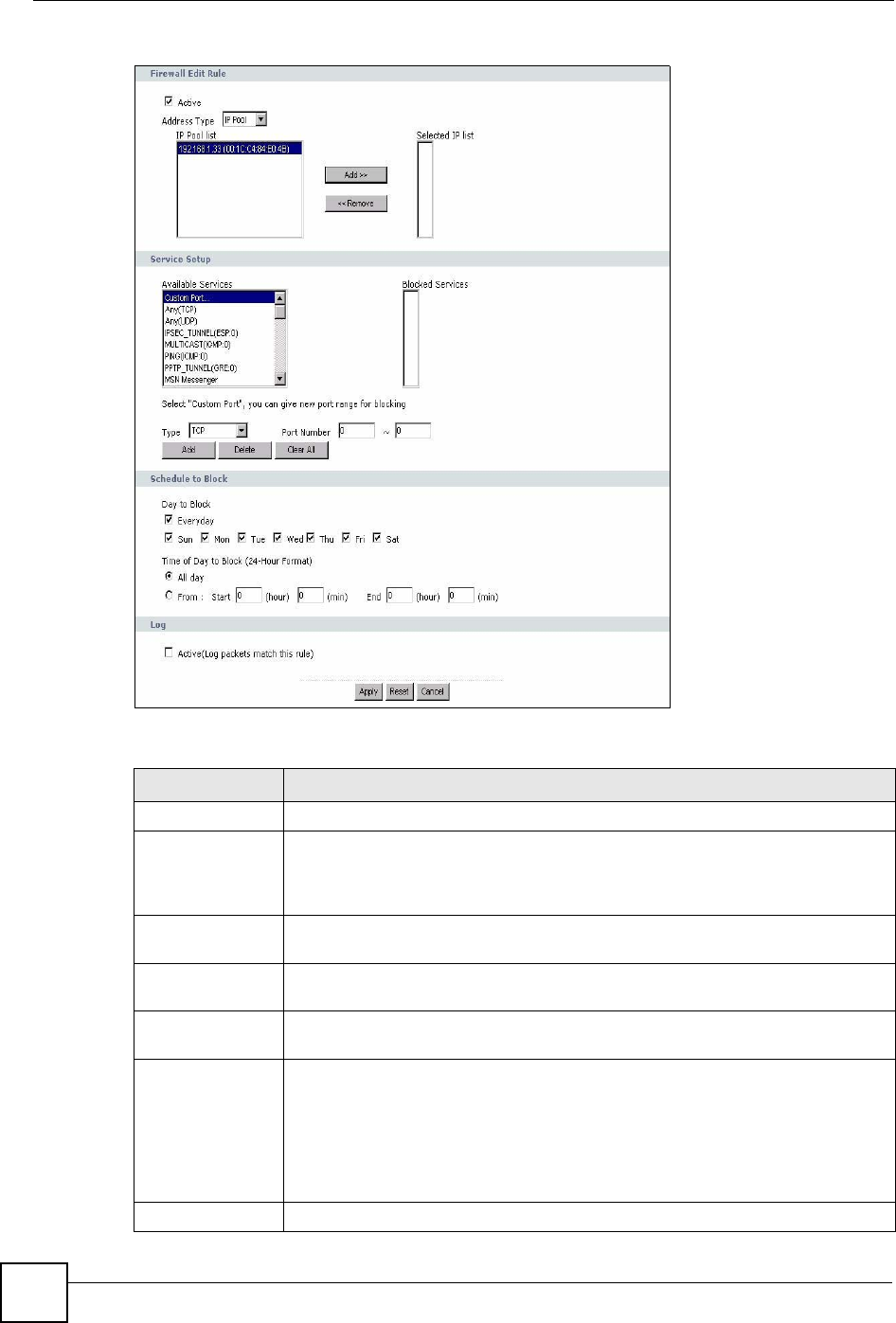
Chapter 13 Firewall
NBG420N User’s Guide
158
Figure 99 Security > Firewall > Services > Adding a Rule
The following table describes the labels in this screen.
Table 59 Security > Firewall > Services > Adding a Rule
LABEL DESCRIPTION
Active Select this check box to turn the rule on.
Address Type Do you want your rule to apply to packets with a particular (single) IP, a range of IP
addresses (for example 192.168.1.10 to 192.169.1.50), a pool of IP address or
any IP address? Select an option from the drop-down list box that includes: Any
IP,Single IP,IP Range and IP Pool.
IP Address Enter the single IP address here. This field is only available when Single IP is
selected as the Address Type.
Start IP Address Enter the starting IP address in a range here. This field is only available when IP
Range is selected as the Address Type.
End IP Address Enter the ending IP address in a range here. This field is only available when IP
Range is selected as the Address Type.
IP Pool List Add an IP address from the IP Pool List to the Selected IP List by highlighting an
IP address and clicking Add. To delete an IP address from the Selected IP List
highlight an IP address and click the Remove button. These fields are only
available when IP Pool is selected as the Address Type.
The IP Pool list gathers its IPs from entries in the ARP table. The ARP table
contains the IP addresses and MAC addresses of the devices that have sent traffic
to the NBG420N.
Service Setup

Chapter 13 Firewall
NBG420N User’s Guide 159
Available Services This is a list of pre-defined services (ports) you may prohibit your LAN computers
from using. Select the port you want to block using the drop-down list and click
Add to add the port to the Blocked Services field.
Blocked Services This is a list of services (ports) that will be inaccessible to computers on your LAN
once you enable service blocking.
Custom Port A custom port is a service that is not available in the pre-defined Available
Services list and you must define using the next two fields.
Type Choose the IP port (TCP or UDP) that defines your customized port from the drop
down list box.
Port Number Enter the port number range that defines the service. For example, if you want to
define the Gnutella service, then select TCP type and enter a port range from
6345 to 6349.
Add Select a service from the Available Services drop-down list and then click Add to
add a service to the Blocked Services
Delete Select a service from the Blocked Services list and then click Delete to remove
this service from the list.
Clear All Click Clear All to empty the Blocked Services.
Schedule to Block
Day to Block: Select a check box to configure which days of the week (or everyday) you want
service blocking to be active.
Time of Day to
Block (24-Hour
Format)
Select the time of day you want service blocking to take effect. Configure blocking
to take effect all day by selecting All Day. You can also configure specific times by
selecting From and entering the start time in the Start (hour) and Start (min)
fields and the end time in the End (hour) and End (min) fields. Enter times in 24-
hour format, for example, "3:00pm" should be entered as "15:00".
Log
Active (Log
packets match
this rule)
Select this to log packets that match this rule. Go to the Log Settings page and
select the Access Control logs category to have the NBG420N record these logs.
Misc setting
Bypass Triangle
Route
Select this check box to have the NBG420N firewall ignore the use of triangle
route topology on the network.
Max NAT/Firewall
Session Per User
Type a number ranging from 1 to 2048 to limit the number of NAT/firewall sessions
that a host can create.
Apply Click Apply to save the settings.
Reset Click Reset to start configuring this screen again.
Cancel Click Cancel to return to the Services screen without saving any changes.
Table 59 Security > Firewall > Services > Adding a Rule
LABEL DESCRIPTION

Chapter 13 Firewall
NBG420N User’s Guide
160

NBG420N User’s Guide 161
CHAPTER 14
Content Filtering
This chapter provides a brief overview of content filtering using the embedded web GUI.
14.1 Introduction to Content Filtering
Internet content filtering allows you to create and enforce Internet access policies tailored to
your needs. Content filtering is the ability to block certain web features or specific URL
keywords.
14.2 Restrict Web Features
The NBG420N can block web features such as ActiveX controls, Java applets, cookies and
disable web proxies.
14.3 Days and Times
The NBG420N also allows you to define time periods and days during which the NBG420N
performs content filtering.
14.4 Filter Screen
Click Security > Content Filter to open the Filter screen.
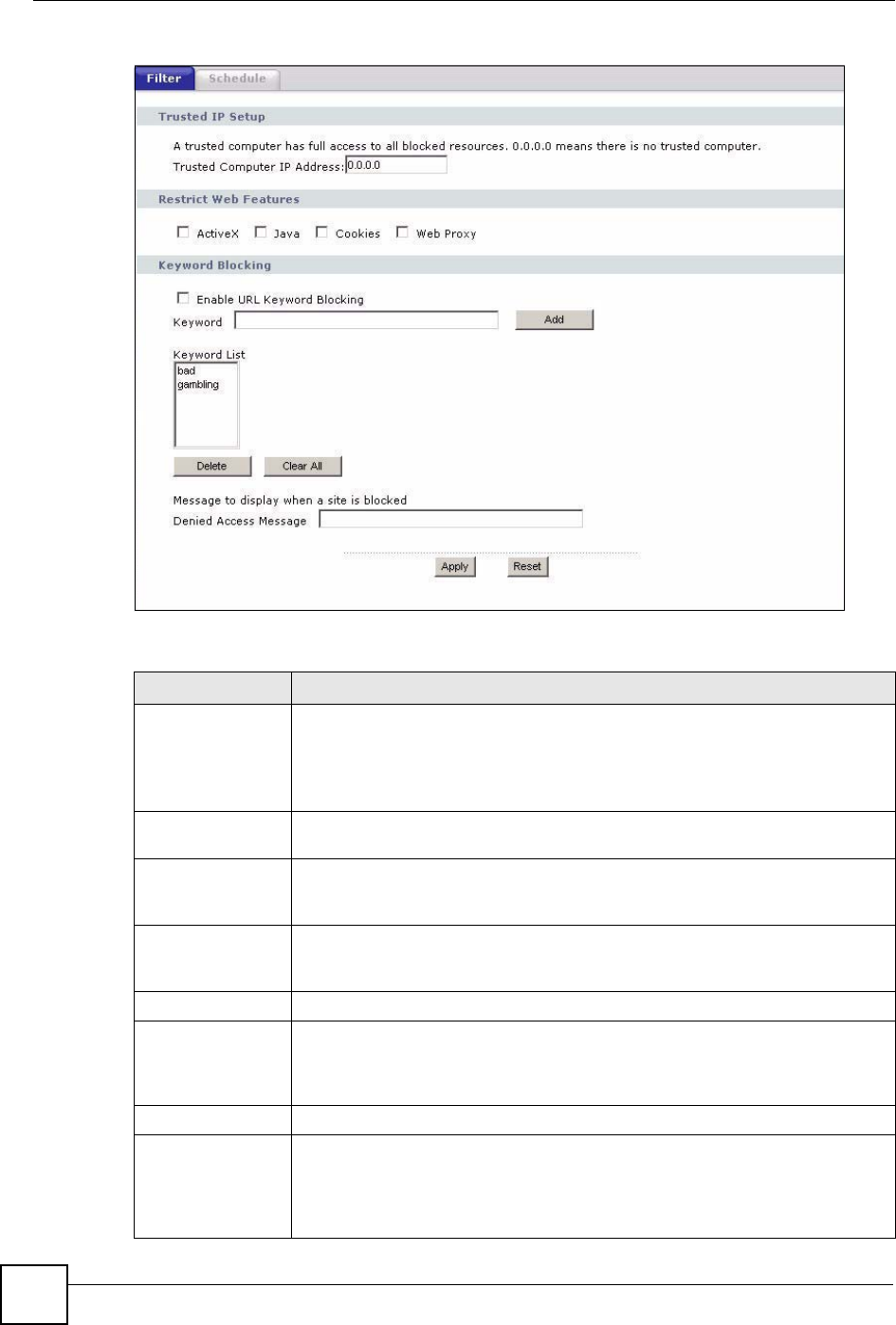
Chapter 14 Content Filtering
NBG420N User’s Guide
162
Figure 100 Security > Content Filter > Filter
The following table describes the labels in this screen.
Table 60 Security > Content Filter > Filter
LABEL DESCRIPTION
Trusted Computer
IP Address
To enable this feature, type an IP address of any one of the computers in your
network that you want to have as a trusted computer. This allows the trusted
computer to have full access to all features that are configured to be blocked by
content filtering.
Leave this field blank to have no trusted computers.
Restrict Web
Features
Select the box(es) to restrict a feature. When you download a page containing a
restricted feature, that part of the web page will appear blank or grayed out.
ActiveX A tool for building dynamic and active Web pages and distributed object
applications. When you visit an ActiveX Web site, ActiveX controls are
downloaded to your browser, where they remain in case you visit the site again.
Java A programming language and development environment for building
downloadable Web components or Internet and intranet business applications of
all kinds.
Cookies Used by Web servers to track usage and provide service based on ID.
Web Proxy A server that acts as an intermediary between a user and the Internet to provide
security, administrative control, and caching service. When a proxy server is
located on the WAN it is possible for LAN users to circumvent content filtering by
pointing to this proxy server.
Keyword Blocking
Enable URL
Keyword Blocking
The NBG420N can block Web sites with URLs that contain certain keywords in
the domain name or IP address. For example, if the keyword "bad" was enabled,
all sites containing this keyword in the domain name or IP address will be
blocked, e.g., URL http://www.website.com/bad.html would be blocked. Select
this check box to enable this feature.
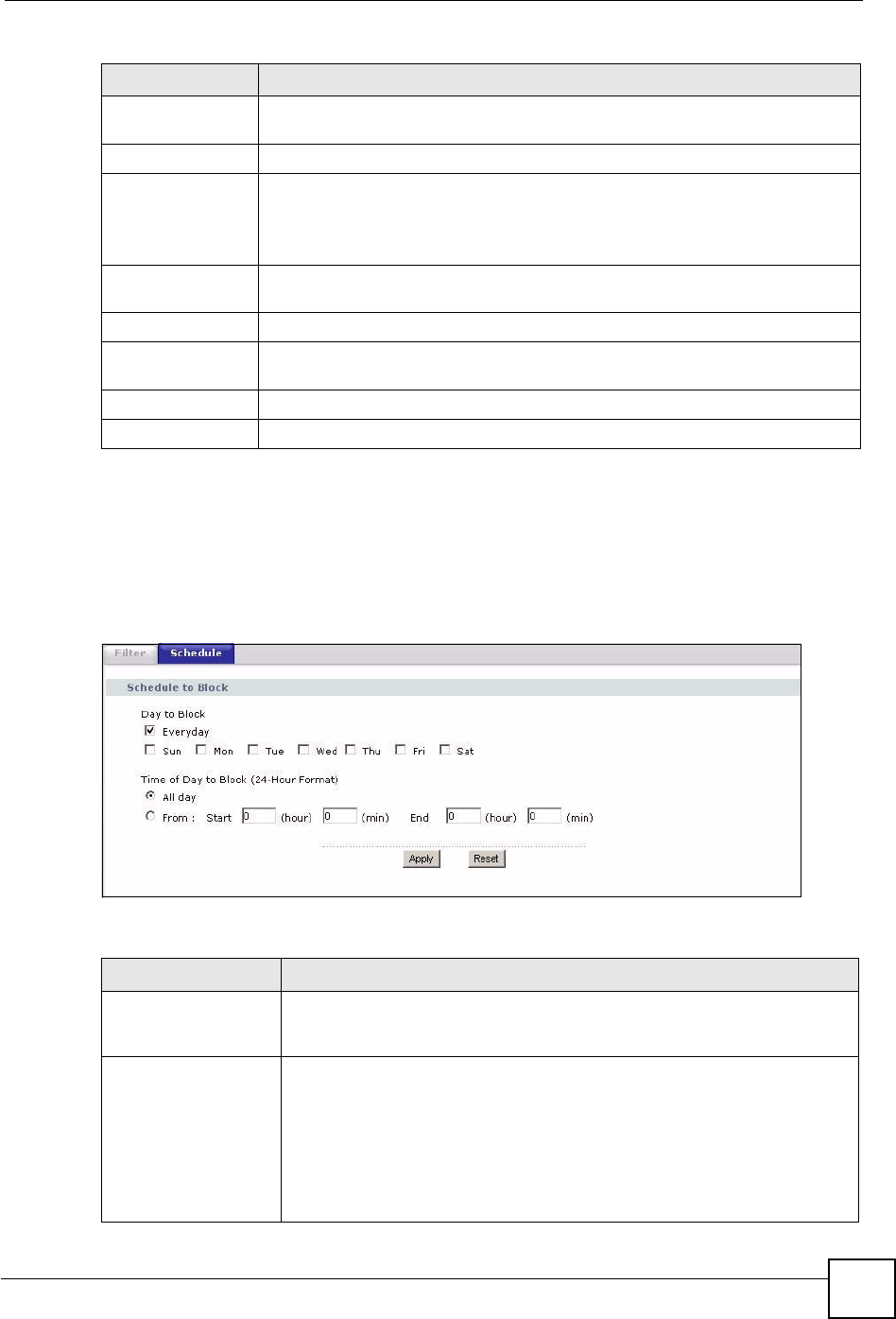
Chapter 14 Content Filtering
NBG420N User’s Guide 163
14.5 Schedule
Use this screen to set the day(s) and time you want the NBG420N to use content filtering.
Click Security > Content Filter > Schedule. The following screen displays.
Figure 101 Security > Content Filter > Schedule
The following table describes the labels in this screen.
Keyword Type a keyword in this field. You may use any character (up to 64 characters).
Wildcards are not allowed. You can also enter a numerical IP address.
Keyword List This list displays the keywords already added.
Add Click Add after you have typed a keyword.
Repeat this procedure to add other keywords. Up to 64 keywords are allowed.
When you try to access a web page containing a keyword, you will get a
message telling you that the content filter is blocking this request.
Delete Highlight a keyword in the lower box and click Delete to remove it. The keyword
disappears from the text box after you click Apply.
Clear All Click this button to remove all of the listed keywords.
Denied Access
Message
Enter a message to be displayed when a user tries to access a restricted web
site. The default message is “Please contact your network administrator!!”
Apply Click Apply to save your changes.
Reset Click Reset to begin configuring this screen afresh
Table 60 Security > Content Filter > Filter
LABEL DESCRIPTION
Table 61 Security > Content Filter > Schedule
LABEL DESCRIPTION
Day to Block Select check boxes for the days that you want the NBG420N to perform
content filtering. Select the Everyday check box to have content filtering
turned on all days of the week.
Time of Day to Block
(24-Hour Format)
Time of Day to Block allows the administrator to define during which time
periods content filtering is enabled. Time of Day to Block restrictions only
apply to the keywords (see above). Restrict web server data, such as ActiveX,
Java, Cookies and Web Proxy are not affected.
Select All Day to have content filtering always active on the days selected in
Day to Block with time of day limitations not enforced.
Select From and enter the time period, in 24-hour format, during which
content filtering will be enforced.

Chapter 14 Content Filtering
NBG420N User’s Guide
164
14.6 Customizing Keyword Blocking URL Checking
You can use commands to set how much of a website’s URL the content filter is to check for
keyword blocking. See the appendices for information on how to access and use the command
interpreter.
14.6.1 Domain Name or IP Address URL Checking
By default, the NBG420N checks the URL’s domain name or IP address when performing
keyword blocking.
This means that the NBG420N checks the characters that come before the first slash in the
URL.
For example, with the URL www.zyxel.com.tw/news/pressroom.php, content filtering only
searches for keywords within www.zyxel.com.tw.
14.6.2 Full Path URL Checking
Full path URL checking has the NBG420N check the characters that come before the last slash
in the URL.
For example, with the URL www.zyxel.com.tw/news/pressroom.php, full path URL checking
searches for keywords within www.zyxel.com.tw/news/.
Use the ip urlfilter customize actionFlags 6 [disable | enable]
command to extend (or not extend) the keyword blocking search to include the URL's full
path.
14.6.3 File Name URL Checking
Filename URL checking has the NBG420N check all of the characters in the URL.
For example, filename URL checking searches for keywords within the URL
www.zyxel.com.tw/news/pressroom.php.
Use the ip urlfilter customize actionFlags 8 [disable | enable]
command to extend (or not extend) the keyword blocking search to include the URL's
complete filename.
Apply Click Apply to save your customized settings and exit this screen.
Reset Click Reset to begin configuring this screen afresh
Table 61 Security > Content Filter > Schedule
LABEL DESCRIPTION
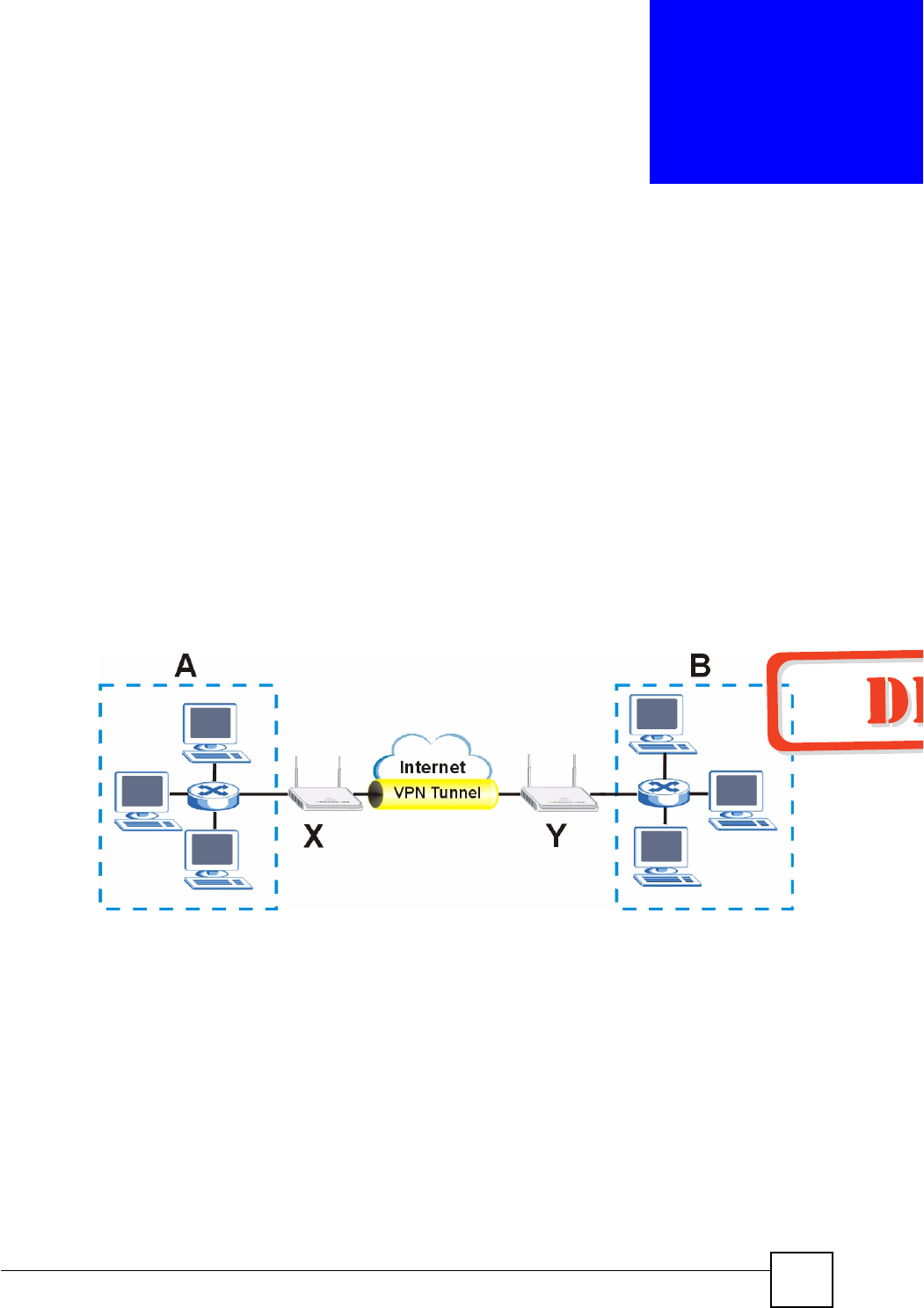
NBG420N User’s Guide 165
CHAPTER 15
IPSec VPN
15.1 IPSec VPN Overview
A virtual private network (VPN) provides secure communications between sites without the
expense of leased site-to-site lines. A secure VPN is a combination of tunneling, encryption,
authentication, access control and auditing. It is used to transport traffic over the Internet or
any insecure network that uses TCP/IP for communication.
Internet Protocol Security (IPSec) is a standards-based VPN that offers flexible solutions for
secure data communications across a public network like the Internet. IPSec is built around a
number of standardized cryptographic techniques to provide confidentiality, data integrity and
authentication at the IP layer.
The following figure provides one perspective of a VPN tunnel.
Figure 102 IPSec VPN: Overview
The VPN tunnel connects the NBG420N (X) and the remote IPSec router (Y). These routers
then connect the local network (A) and remote network (B).
15.1.1 What You Can Do in the IPSec VPN Screens
Use the General Screen (Section 15.2 on page 167) to display and manage the NBG420N’s
VPN rules (tunnels).
Use the SA Monitor Screen (Section 15.3 on page 183) to display and manage active VPN
connections.
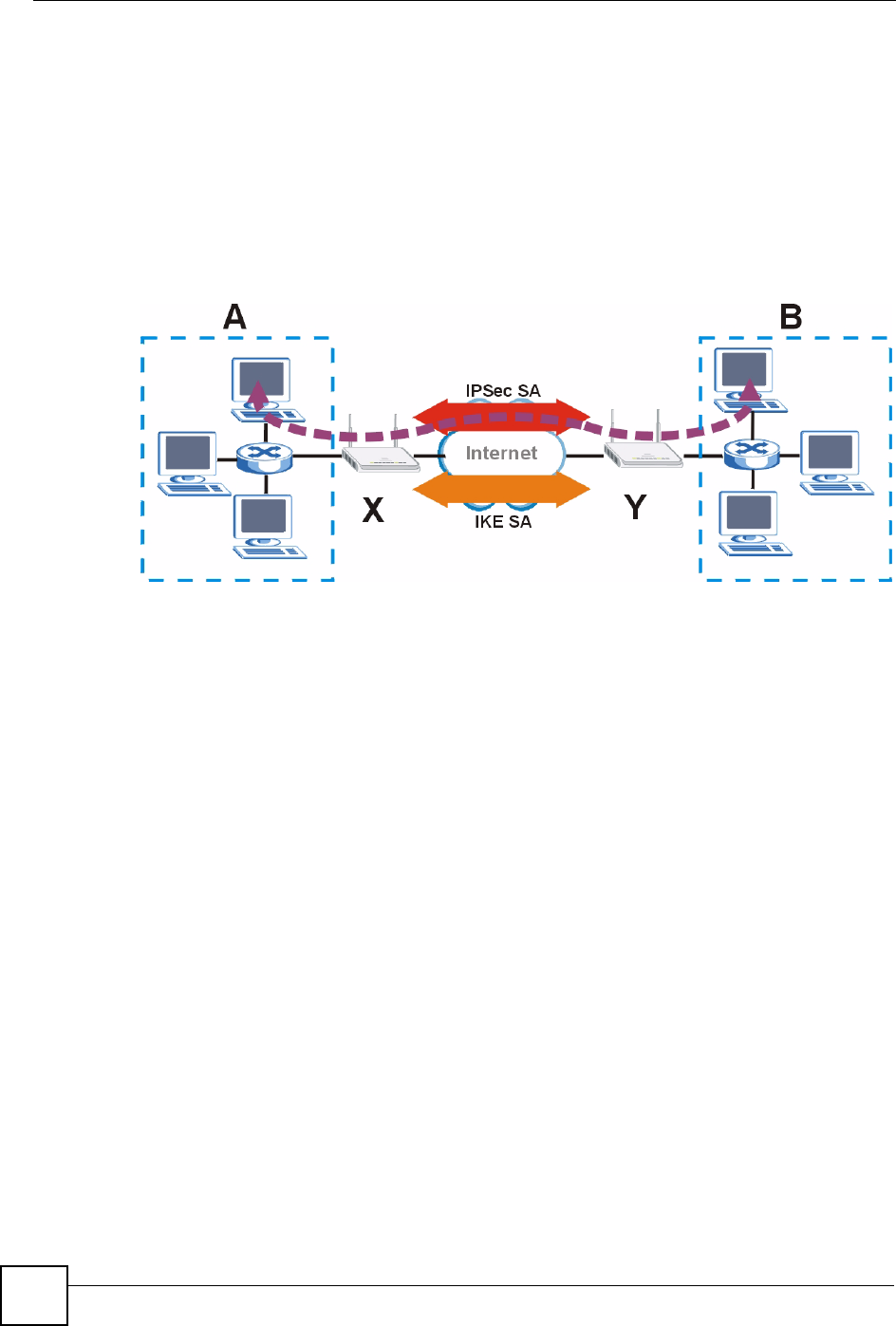
Chapter 15 IPSec VPN
NBG420N User’s Guide
166
15.1.2 What You Need To Know About IPSec VPN
A VPN tunnel is usually established in two phases. Each phase establishes a security
association (SA), a contract indicating what security parameters the NBG420N and the remote
IPSec router will use. The first phase establishes an Internet Key Exchange (IKE) SA between
the NBG420N and remote IPSec router. The second phase uses the IKE SA to securely
establish an IPSec SA through which the NBG420N and remote IPSec router can send data
between computers on the local network and remote network. The following figure illustrates
this.
Figure 103 VPN: IKE SA and IPSec SA
In this example, a computer in network A is exchanging data with a computer in network B.
Inside networks A and B, the data is transmitted the same way data is normally transmitted in
the networks. Between routers X and Y, the data is protected by tunneling, encryption,
authentication, and other security features of the IPSec SA. The IPSec SA is established
securely using the IKE SA that routers X and Y established first.
15.1.3 IKE SA (IKE Phase 1) Overview
The IKE SA provides a secure connection between the NBG420N and remote IPSec router.
It takes several steps to establish an IKE SA. The negotiation mode determines the number of
steps to use. There are two negotiation modes--main mode and aggressive mode. Main mode
provides better security, while aggressive mode is faster.
Note: Both routers must use the same negotiation mode.
These modes are discussed in more detail in Negotiation Mode on page 187. Main mode is
used in various examples in the rest of this section.
15.1.3.1 IP Addresses of the NBG420N and Remote IPSec Router
In the NBG420N, you have to specify the IP addresses of the NBG420N and the remote IPSec
router to establish an IKE SA.
You can usually provide a static IP address or a domain name for the NBG420N. Sometimes,
your NBG420N might also offer another alternative, such as using the IP address of a port or
interface.
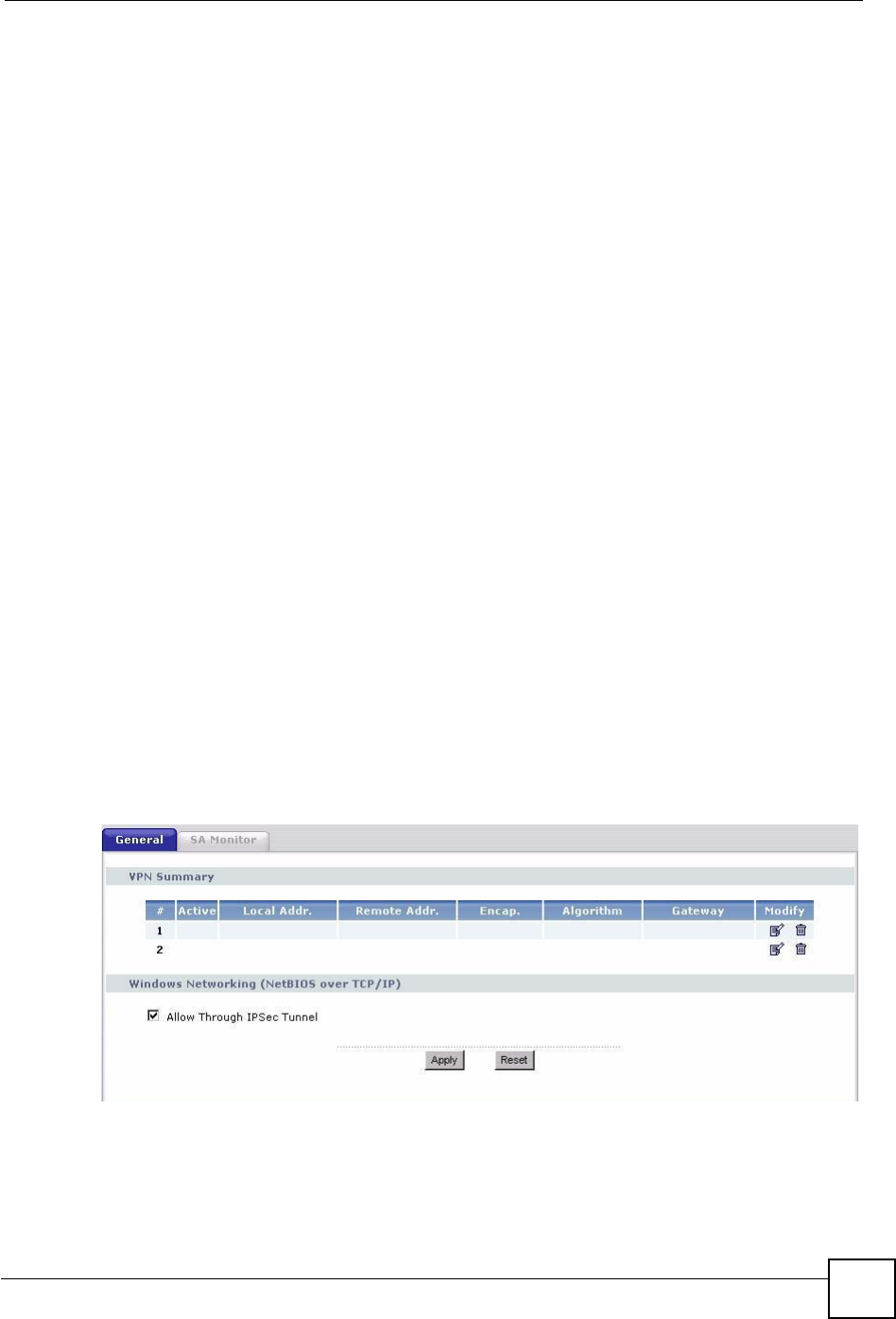
Chapter 15 IPSec VPN
NBG420N User’s Guide 167
You can usually provide a static IP address or a domain name for the remote IPSec router as
well. Sometimes, you might not know the IP address of the remote IPSec router (for example,
telecommuters). In this case, you can still set up the IKE SA, but only the remote IPSec router
can initiate an IKE SA.
15.1.4 IPSec SA (IKE Phase 2) Overview
Once the NBG420N and remote IPSec router have established the IKE SA, they can securely
negotiate an IPSec SA through which to send data between computers on the networks.
Note: The IPSec SA stays connected even if the underlying IKE SA is not available
anymore.
This section introduces the key components of an IPSec SA.
15.1.4.1 Local Network and Remote Network
In an IPSec SA, the local network consists of devices connected to the NBG420N and may be
called the local policy. Similarly, the remote network consists of the devices connected to the
remote IPSec router and may be called the remote policy.
Note: It is not recommended to set a VPN rule’s local and remote network settings
both to 0.0.0.0 (any). This causes the NBG420N to try to forward all access
attempts (to the local network, the Internet or even the NBG420N) to the
remote IPSec router. In this case, you can no longer manage the NBG420N.
15.2 The General Screen
Click Security > VPN to display the Summary screen. This is a read-only menu of your VPN
rules (tunnels). Edit a VPN rule by clicking the Edit icon.
Figure 104 Security > VPN > General

Chapter 15 IPSec VPN
NBG420N User’s Guide
168
The following table describes the fields in this screen.
15.2.1 VPN Rule Setup (Basic)
Click the Edit icon in the General screen to display the Rule Setup screen.
This figure helps explain the main fields.
Table 62 Security > VPN > General
LABEL DESCRIPTION
#This is the VPN policy index number.
Active This field displays whether the VPN policy is active or not.
This icon is turned on when the rule is enabled.
Local Addr. This displays the beginning and ending (static) IP addresses or a (static) IP address
and a subnet mask of computer(s) on your local network behind your NBG420N.
Remote Addr. This displays the beginning and ending (static) IP addresses or a (static) IP address
and a subnet mask of computer(s) on the remote network behind the remote IPSec
router.
This field displays 0.0.0.0 when the Secure Gateway Address field displays 0.0.0.0.
In this case only the remote IPSec router can initiate the VPN.
Encap. This field displays Tunnel or Transport mode (Tunnel is the default selection).
Algorithm This field displays the security protocol, encryption algorithm and authentication
algorithm used for an SA.
Gateway This is the static WAN IP address or URL of the remote IPSec router. This field
displays 0.0.0.0 when you configure the Secure Gateway Address field in the Rule
Setup screen to 0.0.0.0.
Modify Click the Edit icon to go to the screen where you can edit the VPN rule.
Click the Remove icon to remove an existing VPN rule.
Windows
Networking
(NetBIOS over
TCP/IP)
NetBIOS (Network Basic Input/Output System) are TCP or UDP packets that enable
a computer to find other computers. It may sometimes be necessary to allow
NetBIOS packets to pass through VPN tunnels in order to allow local computers to
find computers on the remote network and vice versa.
Allow NetBIOS
Traffic Through
IPSec Tunnel
Select this check box to send NetBIOS packets through the VPN connection.
Apply Click Apply to save your changes back to the NBG420N.
Reset Click Reset to begin configuring this screen afresh.
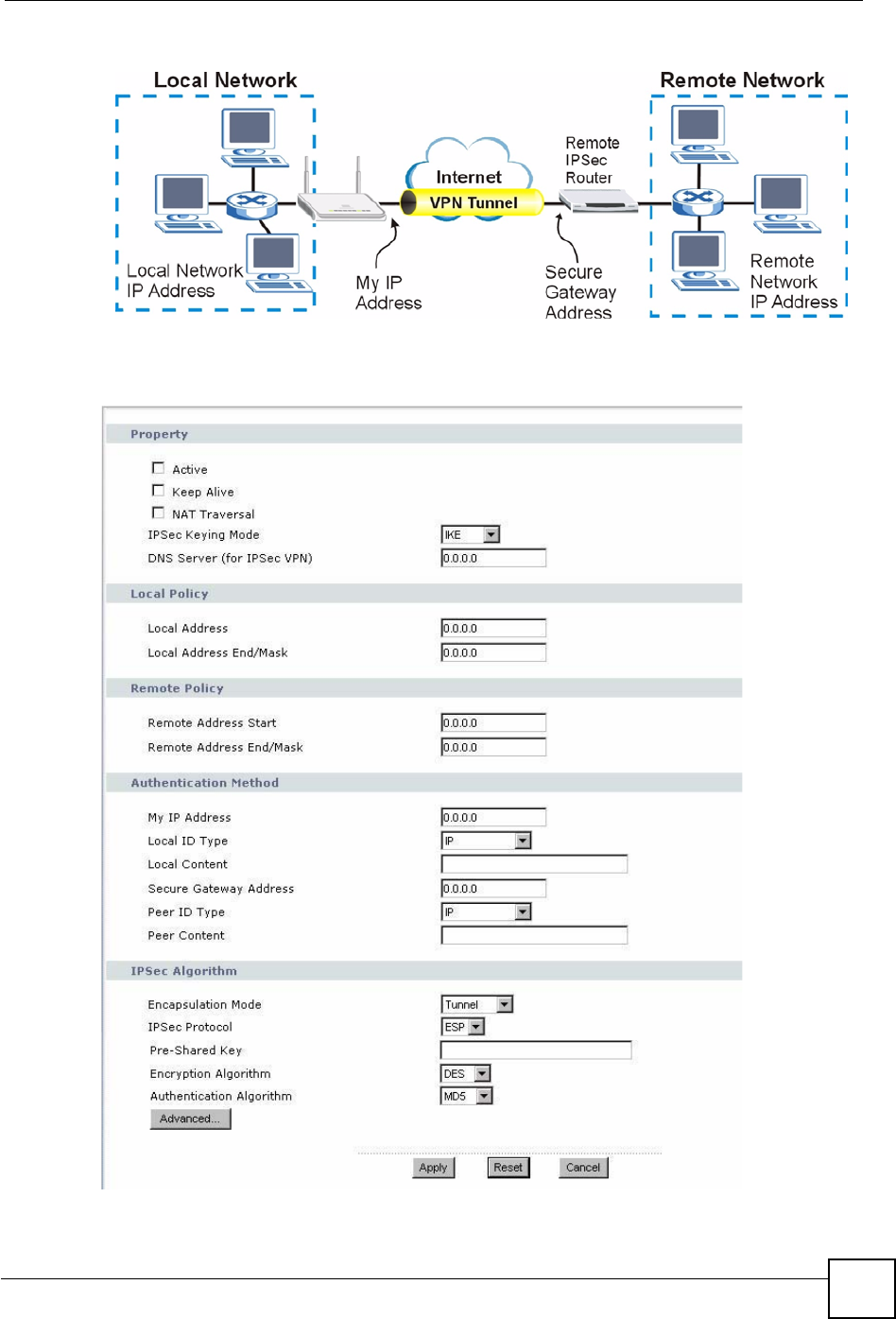
Chapter 15 IPSec VPN
NBG420N User’s Guide 169
Figure 105 IPSec Fields Summary
Use this screen to configure a VPN rule.
Figure 106 Security > VPN > General > Rule Setup: IKE (Basic)

Chapter 15 IPSec VPN
NBG420N User’s Guide
170
The following table describes the labels in this screen.
Table 63 SECURITY > VPN > Rule Setup: IKE (Basic)
LABEL DESCRIPTION
Property
Active Select this check box to activate this VPN policy.
Keep Alive Select this check box to have the NBG420N automatically reinitiate the SA after
the SA lifetime times out, even if there is no traffic. The remote IPSec router must
also have keep alive enabled in order for this feature to work.
NAT Traversal Select this check box to enable NAT traversal. NAT traversal allows you to set up
a VPN connection when there are NAT routers between the two IPSec routers.
Note: The remote IPSec router must also have NAT traversal
enabled.
You can use NAT traversal with ESP protocol using Transport or Tunnel mode,
but not with AH protocol nor with manual key management. In order for an IPSec
router behind a NAT router to receive an initiating IPSec packet, set the NAT
router to forward UDP ports 500 and 4500 to the IPSec router behind the NAT
router.
IPSec Keying
Mode
Select IKE or Manual from the drop-down list box. IKE provides more protection
so it is generally recommended. Manual is a useful option for troubleshooting if
you have problems using IKE key management.
DNS Server (for
IPSec VPN)
If there is a private DNS server that services the VPN, type its IP address here.
The NBG420N assigns this additional DNS server to the NBG420N's DHCP
clients that have IP addresses in this IPSec rule's range of local addresses.
A DNS server allows clients on the VPN to find other computers and servers on
the VPN by their (private) domain names.
Local Policy Local IP addresses must be static and correspond to the remote IPSec router's
configured remote IP addresses.
Two active SAs can have the same configured local or remote IP address, but not
both. You can configure multiple SAs between the same local and remote IP
addresses, as long as only one is active at any time.
In order to have more than one active rule with the Secure Gateway Address
field set to 0.0.0.0, the ranges of the local IP addresses cannot overlap between
rules.
If you configure an active rule with 0.0.0.0 in the Secure Gateway Address field
and the LAN’s full IP address range as the local IP address, then you cannot
configure any other active rules with the Secure Gateway Address field set to
0.0.0.0.
Local Address For a single IP address, enter a (static) IP address on the LAN behind your
NBG420N.
For a specific range of IP addresses, enter the beginning (static) IP address, in a
range of computers on your LAN behind your NBG420N.
To specify IP addresses on a network by their subnet mask, enter a (static) IP
address on the LAN behind your NBG420N.
Local Address End
/Mask
When the local IP address is a single address, type it a second time here.
When the local IP address is a range, enter the end (static) IP address, in a range
of computers on the LAN behind your NBG420N.
When the local IP address is a subnet address, enter a subnet mask on the LAN
behind your NBG420N.

Chapter 15 IPSec VPN
NBG420N User’s Guide 171
Remote Policy Remote IP addresses must be static and correspond to the remote IPSec router's
configured local IP addresses. The remote fields do not apply when the Secure
Gateway IP Address field is configured to 0.0.0.0. In this case only the remote
IPSec router can initiate the VPN.
Two active SAs cannot have the local and remote IP address(es) both the same.
Two active SAs can have the same local or remote IP address, but not both. You
can configure multiple SAs between the same local and remote IP addresses, as
long as only one is active at any time.
Remote Address For a single IP address, enter a (static) IP address on the network behind the
remote IPSec router.
For a specific range of IP addresses, enter the beginning (static) IP address, in a
range of computers on the network behind the remote IPSec router.
To specify IP addresses on a network by their subnet mask, enter a (static) IP
address on the network behind the remote IPSec router.
Remote Address
End /Mask
When the remote IP address is a single address, type it a second time here.
When the remote IP address is a range, enter the end (static) IP address, in a
range of computers on the network behind the remote IPSec router.
When the remote IP address is a subnet address, enter a subnet mask on the
network behind the remote IPSec router.
Authentication
Method
My IP Address Enter the NBG420N's static WAN IP address (if it has one) or leave the field set to
0.0.0.0.
The NBG420N uses its current WAN IP address (static or dynamic) in setting up
the VPN tunnel if you leave this field as 0.0.0.0. If the WAN connection goes
down, the NBG420N uses the dial backup IP address for the VPN tunnel when
using dial backup or the LAN IP address when using traffic redirect.
Otherwise, you can enter one of the dynamic domain names that you have
configured (in the DDNS screen) to have the NBG420N use that dynamic domain
name's IP address.
The VPN tunnel has to be rebuilt if My IP Address changes after setup.
Local ID Type Select IP to identify this NBG420N by its IP address.
Select Domain Name to identify this NBG420N by a domain name.
Select E-mail to identify this NBG420N by an e-mail address.
Local Content When you select IP in the Local ID Type field, type the IP address of your
computer in the Local Content field. The NBG420N automatically uses the IP
address in the My IP Address field (refer to the My IP Address field description)
if you configure the Local Content field to 0.0.0.0 or leave it blank.
It is recommended that you type an IP address other than 0.0.0.0 in the Local
Content field or use the Domain Name or E-mail ID type in the following
situations.
• When there is a NAT router between the two IPSec routers.
• When you want the remote IPSec router to be able to distinguish between
VPN connection requests that come in from IPSec routers with dynamic WAN
IP addresses.
When you select Domain Name or E-mail in the Local ID Type field, type a
domain name or e-mail address by which to identify this NBG420N in the Local
Content field. Use up to 31 ASCII characters including spaces, although trailing
spaces are truncated. The domain name or e-mail address is for identification
purposes only and can be any string.
Table 63 SECURITY > VPN > Rule Setup: IKE (Basic) (continued)
LABEL DESCRIPTION

Chapter 15 IPSec VPN
NBG420N User’s Guide
172
Secure Gateway
Address
Type the WAN IP address or the domain name (up to 31 characters) of the IPSec
router with which you're making the VPN connection. Set this field to 0.0.0.0 if the
remote IPSec router has a dynamic WAN IP address (the IPSec Keying Mode
field must be set to IKE).
In order to have more than one active rule with the Secure Gateway Address
field set to 0.0.0.0, the ranges of the local IP addresses cannot overlap between
rules.
If you configure an active rule with 0.0.0.0 in the Secure Gateway Address field
and the LAN’s full IP address range as the local IP address, then you cannot
configure any other active rules with the Secure Gateway Address field set to
0.0.0.0.
Note: You can also enter a remote secure gateway’s domain
name in the Secure Gateway Address field if the remote
secure gateway has a dynamic WAN IP address and is
using DDNS. The NBG420N has to rebuild the VPN tunnel
each time the remote secure gateway’s WAN IP address
changes (there may be a delay until the DDNS servers are
updated with the remote gateway’s new WAN IP address).
Peer ID Type Select IP to identify the remote IPSec router by its IP address.
Select Domain Name to identify the remote IPSec router by a domain name.
Select E-mail to identify the remote IPSec router by an e-mail address.
Peer Content The configuration of the peer content depends on the peer ID type.
For IP, type the IP address of the computer with which you will make the VPN
connection. If you configure this field to 0.0.0.0 or leave it blank, the NBG420N
will use the address in the Secure Gateway Address field (refer to the Secure
Gateway Address field description).
For Domain Name or E-mail, type a domain name or e-mail address by which to
identify the remote IPSec router. Use up to 31 ASCII characters including spaces,
although trailing spaces are truncated. The domain name or e-mail address is for
identification purposes only and can be any string.
It is recommended that you type an IP address other than 0.0.0.0 or use the
Domain Name or E-mail ID type in the following situations:
• When there is a NAT router between the two IPSec routers.
• When you want the NBG420N to distinguish between VPN connection
requests that come in from remote IPSec routers with dynamic WAN IP
addresses.
IPSec Algorithm
Encapsulation
Mode
Select Tunnel mode or Transport mode from the drop-down list box.
IPSec Protocol Select the security protocols used for an SA.
Both AH and ESP increase processing requirements and communications
latency (delay).
If you select ESP here, you must select options from the Encryption Algorithm
and Authentication Algorithm fields (described below).
Table 63 SECURITY > VPN > Rule Setup: IKE (Basic) (continued)
LABEL DESCRIPTION

Chapter 15 IPSec VPN
NBG420N User’s Guide 173
15.2.2 VPN Rule Setup (Advanced)
Click the Advanced... button in the Rule Setup screen to open this screen.
Use this screen to configure a VPN rule.
Pre-Shared Key Type your pre-shared key in this field. A pre-shared key identifies a
communicating party during a phase 1 IKE negotiation. It is called "pre-shared"
because you have to share it with another party before you can communicate
with them over a secure connection.
Type from 8 to 31 case-sensitive ASCII characters or from 16 to 62 hexadecimal
("0-9", "A-F") characters. You must precede a hexadecimal key with a "0x” (zero
x), which is not counted as part of the 16 to 62 character range for the key. For
example, in "0x0123456789ABCDEF", “0x” denotes that the key is hexadecimal
and “0123456789ABCDEF” is the key itself.
Both ends of the VPN tunnel must use the same pre-shared key. You will receive
a “PYLD_MALFORMED” (payload malformed) packet if the same pre-shared key
is not used on both ends.
Encryption
Algorithm
Select which key size and encryption algorithm to use for data communications.
Choices are:
DES - a 56-bit key with the DES encryption algorithm
3DES - a 168-bit key with the DES encryption algorithm
The NBG420N and the remote IPSec router must use the same algorithms and
key , which can be used to encrypt and decrypt the message or to generate and
verify a message authentication code. Longer keys require more processing
power, resulting in increased latency and decreased throughput.
Authentication
Algorithm
Select which hash algorithm to use to authenticate packet data. Choices are
SHA1 and MD5.SHA1 is generally considered stronger than MD5, but it is also
slower.
Advanced... Click Advanced... to configure more detailed settings of your IKE key
management.
Apply Click Apply to save your changes back to the NBG420N.
Reset Click Reset to begin configuring this screen afresh.
Cancel Click Cancel to exit the screen without making any changes.
Table 63 SECURITY > VPN > Rule Setup: IKE (Basic) (continued)
LABEL DESCRIPTION
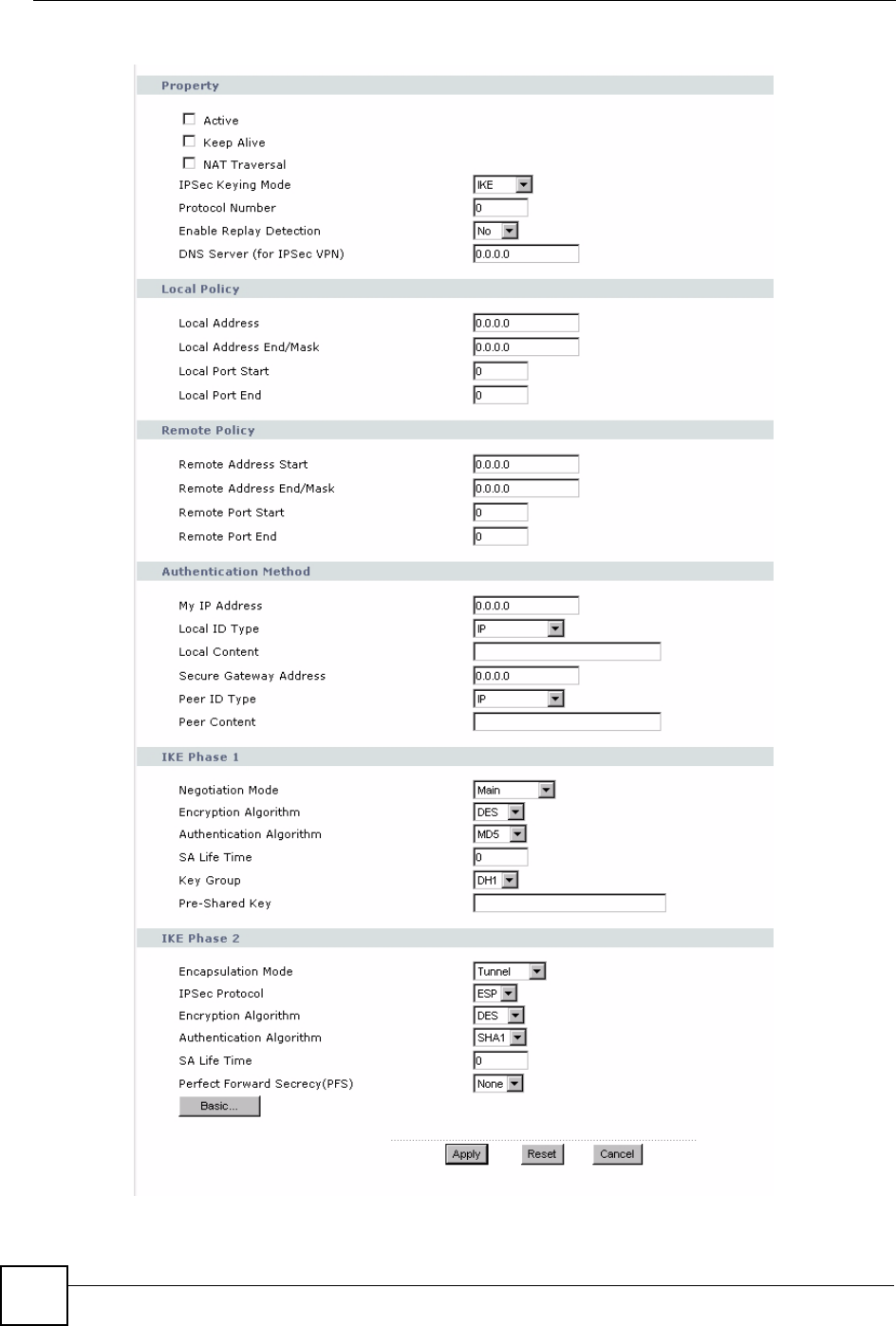
Chapter 15 IPSec VPN
NBG420N User’s Guide
174
Figure 107 Security > VPN > General > Rule Setup: IKE (Advanced)

Chapter 15 IPSec VPN
NBG420N User’s Guide 175
The following table describes the labels in this screen.
Table 64 Security > VPN > Rule Setup: IKE (Advanced)
LABEL DESCRIPTION
Property
Active Select this check box to activate this VPN policy.
Keep Alive Select this check box to have the NBG420N automatically reinitiate the SA after
the SA lifetime times out, even if there is no traffic. The remote IPSec router
must also have keep alive enabled in order for this feature to work.
NAT Traversal Select this check box to enable NAT traversal. NAT traversal allows you to set
up a VPN connection when there are NAT routers between the two IPSec
routers.
Note: The remote IPSec router must also have NAT traversal
enabled.
You can use NAT traversal with ESP protocol using Transport or Tunnel mode,
but not with AH protocol nor with manual key management. In order for an
IPSec router behind a NAT router to receive an initiating IPSec packet, set the
NAT router to forward UDP ports 500 and 4500 to the IPSec router behind the
NAT router.
IPSec Keying Mode Select IKE or Manual from the drop-down list box. IKE provides more
protection so it is generally recommended. Manual is a useful option for
troubleshooting if you have problems using IKE key management.
Protocol Number Enter 1 for ICMP, 6 for TCP, 17 for UDP, etc. 0 is the default and signifies any
protocol.
Enable Replay
Detection
As a VPN setup is processing intensive, the system is vulnerable to Denial of
Service (DoS) attacks The IPSec receiver can detect and reject old or duplicate
packets to protect against replay attacks. Select Yes from the drop-down menu
to enable replay detection, or select No to disable it.
DNS Server (for
IPSec VPN)
If there is a private DNS server that services the VPN, type its IP address here.
The NBG420N assigns this additional DNS server to the NBG420N's DHCP
clients that have IP addresses in this IPSec rule's range of local addresses.
A DNS server allows clients on the VPN to find other computers and servers on
the VPN by their (private) domain names.
Local Policy Local IP addresses must be static and correspond to the remote IPSec router's
configured remote IP addresses.
Two active SAs can have the same configured local or remote IP address, but
not both. You can configure multiple SAs between the same local and remote IP
addresses, as long as only one is active at any time.
In order to have more than one active rule with the Secure Gateway Address
field set to 0.0.0.0, the ranges of the local IP addresses cannot overlap between
rules.
If you configure an active rule with 0.0.0.0 in the Secure Gateway Address
field and the LAN’s full IP address range as the local IP address, then you
cannot configure any other active rules with the Secure Gateway Address field
set to 0.0.0.0.
Local Address For a single IP address, enter a (static) IP address on the LAN behind your
NBG420N.
For a specific range of IP addresses, enter the beginning (static) IP address, in
a range of computers on your LAN behind your NBG420N.
To specify IP addresses on a network by their subnet mask, enter a (static) IP
address on the LAN behind your NBG420N.

Chapter 15 IPSec VPN
NBG420N User’s Guide
176
Local Address End /
Mask
When the local IP address is a single address, type it a second time here.
When the local IP address is a range, enter the end (static) IP address, in a
range of computers on the LAN behind your NBG420N.
When the local IP address is a subnet address, enter a subnet mask on the
LAN behind your NBG420N.
Local Port Start 0 is the default and signifies any port. Type a port number from 0 to 65535.
Some of the most common IP ports are: 21, FTP; 53, DNS; 23, Telnet; 80,
HTTP; 25, SMTP; 110, POP3.
Local Port End Enter a port number in this field to define a port range. This port number must
be greater than that specified in the previous field. If Local Port Start is left at 0,
Local Port End will also remain at 0.
Remote Policy Remote IP addresses must be static and correspond to the remote IPSec
router's configured local IP addresses. The remote fields do not apply when the
Secure Gateway IP Address field is configured to 0.0.0.0. In this case only the
remote IPSec router can initiate the VPN.
Two active SAs cannot have the local and remote IP address(es) both the
same. Two active SAs can have the same local or remote IP address, but not
both. You can configure multiple SAs between the same local and remote IP
addresses, as long as only one is active at any time.
Remote Address For a single IP address, enter a (static) IP address on the network behind the
remote IPSec router.
For a specific range of IP addresses, enter the beginning (static) IP address, in
a range of computers on the network behind the remote IPSec router.
To specify IP addresses on a network by their subnet mask, enter a (static) IP
address on the network behind the remote IPSec router.
Remote Address
End /Mask
When the remote IP address is a single address, type it a second time here.
When the remote IP address is a range, enter the end (static) IP address, in a
range of computers on the network behind the remote IPSec router.
When the remote IP address is a subnet address, enter a subnet mask on the
network behind the remote IPSec router.
Remote Port Start 0 is the default and signifies any port. Type a port number from 0 to 65535.
Some of the most common IP ports are: 21, FTP; 53, DNS; 23, Telnet; 80,
HTTP; 25, SMTP; 110, POP3.
Remote Port End Enter a port number in this field to define a port range. This port number must
be greater than that specified in the previous field. If Remote Port Start is left at
0, Remote Port End will also remain at 0.
Authentication
Method
My IP Address Enter the NBG420N's static WAN IP address (if it has one) or leave the field set
to 0.0.0.0.
The NBG420N uses its current WAN IP address (static or dynamic) in setting up
the VPN tunnel if you leave this field as 0.0.0.0. If the WAN connection goes
down, the NBG420N uses the dial backup IP address for the VPN tunnel when
using dial backup or the LAN IP address when using traffic redirect.
Otherwise, you can enter one of the dynamic domain names that you have
configured (in the DDNS screen) to have the NBG420N use that dynamic
domain name's IP address.
The VPN tunnel has to be rebuilt if My IP Address changes after setup.
Local ID Type Select IP to identify this NBG420N by its IP address.
Select Domain Name to identify this NBG420N by a domain name.
Select E-mail to identify this NBG420N by an e-mail address.
Table 64 Security > VPN > Rule Setup: IKE (Advanced) (continued)
LABEL DESCRIPTION

Chapter 15 IPSec VPN
NBG420N User’s Guide 177
Local Content When you select IP in the Local ID Type field, type the IP address of your
computer in the Local Content field. The NBG420N automatically uses the IP
address in the My IP Address field (refer to the My IP Address field
description) if you configure the Local Content field to 0.0.0.0 or leave it blank.
It is recommended that you type an IP address other than 0.0.0.0 in the Local
Content field or use the Domain Name or E-mail ID type in the following
situations.
• When there is a NAT router between the two IPSec routers.
• When you want the remote IPSec router to be able to distinguish between
VPN connection requests that come in from IPSec routers with dynamic
WAN IP addresses.
When you select Domain Name or E-mail in the Local ID Type field, type a
domain name or e-mail address by which to identify this NBG420N in the Local
Content field. Use up to 31 ASCII characters including spaces, although trailing
spaces are truncated. The domain name or e-mail address is for identification
purposes only and can be any string.
Secure Gateway
Address
Type the WAN IP address or the domain name (up to 31 characters) of the
IPSec router with which you're making the VPN connection. Set this field to
0.0.0.0 if the remote IPSec router has a dynamic WAN IP address (the IPSec
Keying Mode field must be set to IKE).
In order to have more than one active rule with the Secure Gateway Address
field set to 0.0.0.0, the ranges of the local IP addresses cannot overlap between
rules.
If you configure an active rule with 0.0.0.0 in the Secure Gateway Address
field and the LAN’s full IP address range as the local IP address, then you
cannot configure any other active rules with the Secure Gateway Address field
set to 0.0.0.0.
Note: You can also enter a remote secure gateway’s domain
name in the Secure Gateway Address field if the remote
secure gateway has a dynamic WAN IP address and is
using DDNS. The NBG420N has to rebuild the VPN tunnel
each time the remote secure gateway’s WAN IP address
changes (there may be a delay until the DDNS servers are
updated with the remote gateway’s new WAN IP address).
Peer ID Type Select IP to identify the remote IPSec router by its IP address.
Select Domain Name to identify the remote IPSec router by a domain name.
Select E-mail to identify the remote IPSec router by an e-mail address.
Peer Content The configuration of the peer content depends on the peer ID type.
For IP, type the IP address of the computer with which you will make the VPN
connection. If you configure this field to 0.0.0.0 or leave it blank, the NBG420N
will use the address in the Secure Gateway Address field (refer to the Secure
Gateway Address field description).
For Domain Name or E-mail, type a domain name or e-mail address by which
to identify the remote IPSec router. Use up to 31 ASCII characters including
spaces, although trailing spaces are truncated. The domain name or e-mail
address is for identification purposes only and can be any string.
It is recommended that you type an IP address other than 0.0.0.0 or use the
Domain Name or E-mail ID type in the following situations:
• When there is a NAT router between the two IPSec routers.
• When you want the NBG420N to distinguish between VPN connection
requests that come in from remote IPSec routers with dynamic WAN IP
addresses.
Table 64 Security > VPN > Rule Setup: IKE (Advanced) (continued)
LABEL DESCRIPTION

Chapter 15 IPSec VPN
NBG420N User’s Guide
178
IKE Phase 1
Negotiation Mode Select Main or Aggressive from the drop-down list box. Multiple SAs
connecting through a secure gateway must have the same negotiation mode.
Encryption Algorithm Select which key size and encryption algorithm to use in the IKE SA. Choices
are:
DES - a 56-bit key with the DES encryption algorithm
3DES - a 168-bit key with the DES encryption algorithm
The NBG420N and the remote IPSec router must use the same algorithms and
keys. Longer keys require more processing power, resulting in increased
latency and decreased throughput.
Authentication
Algorithm
Select which hash algorithm to use to authenticate packet data in the IKE SA.
Choices are SHA1 and MD5.SHA1 is generally considered stronger than MD5,
but it is also slower.
SA Life Time
(Seconds)
Define the length of time before an IKE SA automatically renegotiates in this
field. It may range from 180 to 3,000,000 seconds (almost 35 days).
A short SA Life Time increases security by forcing the two VPN gateways to
update the encryption and authentication keys. However, every time the VPN
tunnel renegotiates, all users accessing remote resources are temporarily
disconnected.
Key Group Select which Diffie-Hellman key group (DHx) you want to use for encryption
keys. Choices are:
DH1 - use a 768-bit random number
DH2 - use a 1024-bit random number
Pre-Shared Key Type your pre-shared key in this field. A pre-shared key identifies a
communicating party during a phase 1 IKE negotiation. It is called "pre-shared"
because you have to share it with another party before you can communicate
with them over a secure connection.
Type from 8 to 31 case-sensitive ASCII characters or from 16 to 62
hexadecimal ("0-9", "A-F") characters. You must precede a hexadecimal key
with a "0x” (zero x), which is not counted as part of the 16 to 62 character range
for the key. For example, in "0x0123456789ABCDEF", “0x” denotes that the key
is hexadecimal and “0123456789ABCDEF” is the key itself.
Both ends of the VPN tunnel must use the same pre-shared key. You will
receive a “PYLD_MALFORMED” (payload malformed) packet if the same pre-
shared key is not used on both ends.
IKE Phase 2
Encapsulation Mode Select Tunnel mode or Transport mode.
IPSec Protocol Select the security protocols used for an SA.
Both AH and ESP increase processing requirements and communications
latency (delay).
If you select ESP here, you must select options from the Encryption Algorithm
and Authentication Algorithm fields (described below).
Encryption Algorithm Select which key size and encryption algorithm to use in the IKE SA. Choices
are:
DES - a 56-bit key with the DES encryption algorithm
3DES - a 168-bit key with the DES encryption algorithm
The NBG420N and the remote IPSec router must use the same algorithms and
keys. Longer keys require more processing power, resulting in increased
latency and decreased throughput.
Table 64 Security > VPN > Rule Setup: IKE (Advanced) (continued)
LABEL DESCRIPTION

Chapter 15 IPSec VPN
NBG420N User’s Guide 179
15.2.3 VPN Rule Setup (Manual)
Use this screen to configure VPN rules (tunnels) that use manual keys. Manual key
management is useful if you have problems with IKE key management.
Select Manual in the IPSec Keying Mode field on the Rule Setup screen to open the screen
as shown in Figure 108 on page 180.
15.2.3.1 IPSec SA Using Manual Keys
You might set up an IPSec SA using manual keys when you want to establish a VPN tunnel
quickly, for example, for troubleshooting. You should only do this as a temporary solution,
however, because it is not as secure as a regular IPSec SA.
In IPSec SAs using manual keys, the NBG420N and remote IPSec router do not establish an
IKE SA. They only establish an IPSec SA. As a result, an IPSec SA using manual keys has
some characteristics of IKE SA and some characteristics of IPSec SA. There are also some
differences between IPSec SA using manual keys and other types of SA.
15.2.3.2 IPSec SA Proposal Using Manual Keys
In IPSec SA using manual keys, you can only specify one encryption algorithm and one
authentication algorithm. There is no DH key exchange, so you have to provide the encryption
key and the authentication key the NBG420N and remote IPSec router use.
Note: The NBG420N and remote IPSec router must use the same encryption key and
authentication key.
Authentication
Algorithm
Select which hash algorithm to use to authenticate packet data in the IPSec SA.
Choices are SHA1 and MD5.SHA1 is generally considered stronger than MD5,
but it is also slower.
SA Life Time Define the length of time before an IPSec SA automatically renegotiates in this
field. The minimum value is 180 seconds.
A short SA Life Time increases security by forcing the two VPN gateways to
update the encryption and authentication keys. However, every time the VPN
tunnel renegotiates, all users accessing remote resources are temporarily
disconnected.
Perfect Forward
Secrecy (PFS)
Select whether or not you want to enable Perfect Forward Secrecy (PFS) and, if
you do, which Diffie-Hellman key group to use for encryption. Choices are:
None - disable PFS
DH1 - enable PFS and use a 768-bit random number
DH2 - enable PFS and use a 1024-bit random number
PFS changes the root key that is used to generate encryption keys for each
IPSec SA. It is more secure but takes more time.
Basic... Click Basic... to go to the previous VPN configuration screen.
Apply Click Apply to save the changes.
Reset Click Reset to begin configuring this screen afresh.
Cancel Click Cancel to exit the screen without making any changes.
Table 64 Security > VPN > Rule Setup: IKE (Advanced) (continued)
LABEL DESCRIPTION
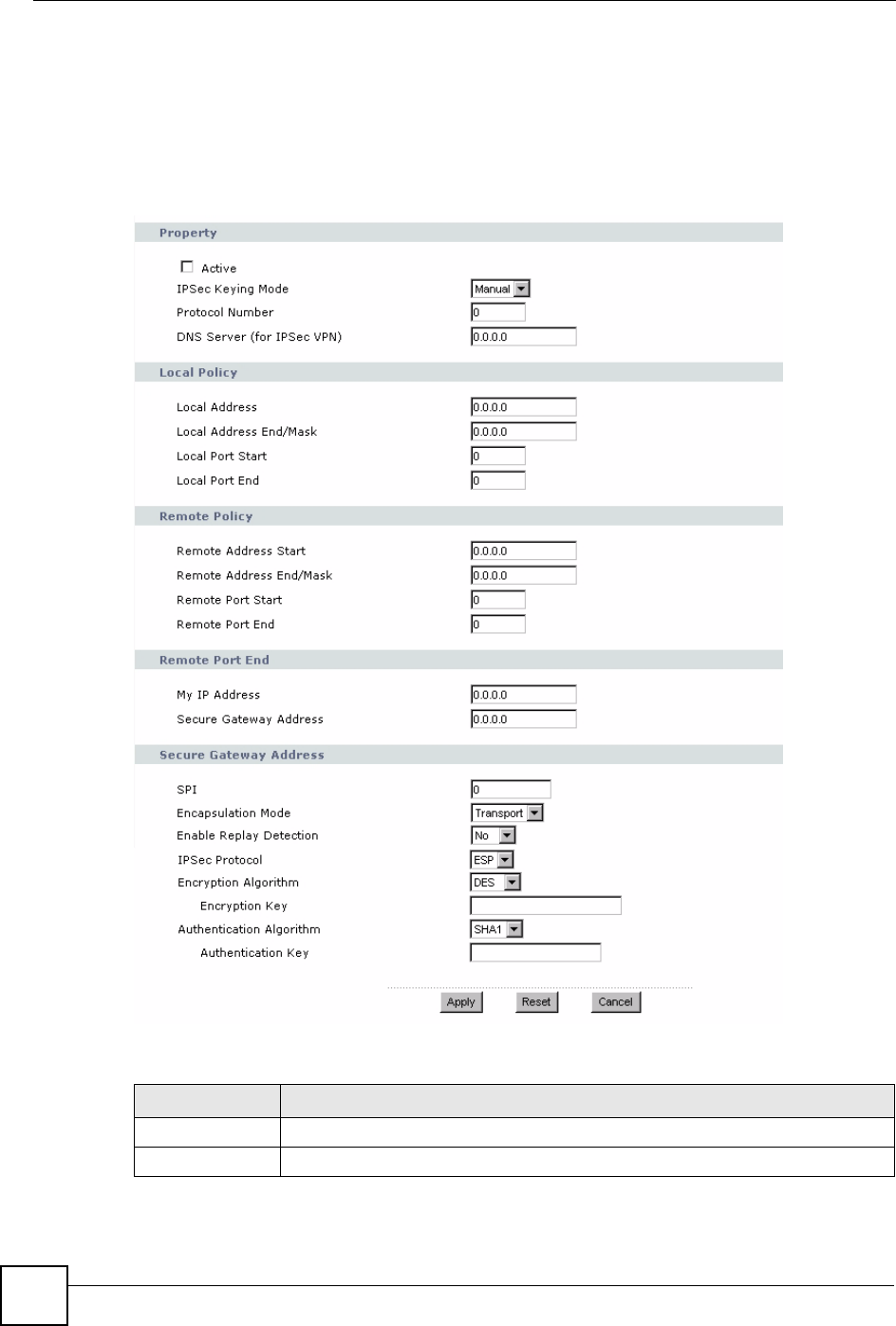
Chapter 15 IPSec VPN
NBG420N User’s Guide
180
15.2.3.3 Authentication and the Security Parameter Index (SPI)
For authentication, the NBG420N and remote IPSec router use the SPI, instead of pre-shared
keys, ID type and content. The SPI is an identification number.
Note: The NBG420N and remote IPSec router must use the same SPI.
Figure 108 Security > VPN > General > Rule Setup: Manual
The following table describes the labels in this screen.
Table 65 Security > VPN > Rule Setup: Manual
LABEL DESCRIPTION
Property
Active Select this check box to activate this VPN policy.

Chapter 15 IPSec VPN
NBG420N User’s Guide 181
IPSec Keying
Mode
Select IKE or Manual from the drop-down list box. IKE provides more protection
so it is generally recommended. Manual is a useful option for troubleshooting if
you have problems using IKE key management.
Protocol Number Enter 1 for ICMP, 6 for TCP, 17 for UDP, etc. 0 is the default and signifies any
protocol.
DNS Server (for
IPSec VPN)
If there is a private DNS server that services the VPN, type its IP address here.
The NBG420N assigns this additional DNS server to the NBG420N's DHCP
clients that have IP addresses in this IPSec rule's range of local addresses.
A DNS server allows clients on the VPN to find other computers and servers on
the VPN by their (private) domain names.
Local Policy Local IP addresses must be static and correspond to the remote IPSec router's
configured remote IP addresses.
Two active SAs can have the same configured local or remote IP address, but not
both. You can configure multiple SAs between the same local and remote IP
addresses, as long as only one is active at any time.
In order to have more than one active rule with the Secure Gateway Address
field set to 0.0.0.0, the ranges of the local IP addresses cannot overlap between
rules.
If you configure an active rule with 0.0.0.0 in the Secure Gateway Address field
and the LAN’s full IP address range as the local IP address, then you cannot
configure any other active rules with the Secure Gateway Address field set to
0.0.0.0.
Local Address For a single IP address, enter a (static) IP address on the LAN behind your
NBG420N.
For a specific range of IP addresses, enter the beginning (static) IP address, in a
range of computers on your LAN behind your NBG420N.
To specify IP addresses on a network by their subnet mask, enter a (static) IP
address on the LAN behind your NBG420N.
Local Address
End /Mask
When the local IP address is a single address, type it a second time here.
When the local IP address is a range, enter the end (static) IP address, in a range
of computers on the LAN behind your NBG420N.
When the local IP address is a subnet address, enter a subnet mask on the LAN
behind your NBG420N.
Local Port Start 0 is the default and signifies any port. Type a port number from 0 to 65535. Some
of the most common IP ports are: 21, FTP; 53, DNS; 23, Telnet; 80, HTTP; 25,
SMTP; 110, POP3.
Local Port End Enter a port number in this field to define a port range. This port number must be
greater than that specified in the previous field. If Local Port Start is left at 0,
Local Port End will also remain at 0.
Remote Policy Remote IP addresses must be static and correspond to the remote IPSec router's
configured local IP addresses. The remote fields do not apply when the Secure
Gateway IP Address field is configured to 0.0.0.0. In this case only the remote
IPSec router can initiate the VPN.
Two active SAs cannot have the local and remote IP address(es) both the same.
Two active SAs can have the same local or remote IP address, but not both. You
can configure multiple SAs between the same local and remote IP addresses, as
long as only one is active at any time.
Table 65 Security > VPN > Rule Setup: Manual (continued)
LABEL DESCRIPTION

Chapter 15 IPSec VPN
NBG420N User’s Guide
182
Remote Address For a single IP address, enter a (static) IP address on the network behind the
remote IPSec router.
For a specific range of IP addresses, enter the beginning (static) IP address, in a
range of computers on the network behind the remote IPSec router.
To specify IP addresses on a network by their subnet mask, enter a (static) IP
address on the network behind the remote IPSec router.
Remote Address
End /Mask
When the remote IP address is a single address, type it a second time here.
When the remote IP address is a range, enter the end (static) IP address, in a
range of computers on the network behind the remote IPSec router.
When the remote IP address is a subnet address, enter a subnet mask on the
network behind the remote IPSec router.
Remote Port Start 0 is the default and signifies any port. Type a port number from 0 to 65535. Some
of the most common IP ports are: 21, FTP; 53, DNS; 23, Telnet; 80, HTTP; 25,
SMTP; 110, POP3.
Remote Port End Enter a port number in this field to define a port range. This port number must be
greater than that specified in the previous field. If Remote Port Start is left at 0,
Remote Port End will also remain at 0.
My IP Address Enter the NBG420N's static WAN IP address (if it has one) or leave the field set to
0.0.0.0.
The NBG420N uses its current WAN IP address (static or dynamic) in setting up
the VPN tunnel if you leave this field as 0.0.0.0. If the WAN connection goes down,
the NBG420N uses the dial backup IP address for the VPN tunnel when using dial
backup or the LAN IP address when using traffic redirect.
Otherwise, you can enter one of the dynamic domain names that you have
configured (in the DDNS screen) to have the NBG420N use that dynamic domain
name's IP address.
The VPN tunnel has to be rebuilt if My IP Address changes after setup.
Secure Gateway
Address
Type the WAN IP address or the domain name (up to 31 characters) of the IPSec
router with which you're making the VPN connection. Set this field to 0.0.0.0 if the
remote IPSec router has a dynamic WAN IP address (the IPSec Keying Mode
field must be set to IKE).
In order to have more than one active rule with the Secure Gateway Address
field set to 0.0.0.0, the ranges of the local IP addresses cannot overlap between
rules.
If you configure an active rule with 0.0.0.0 in the Secure Gateway Address field
and the LAN’s full IP address range as the local IP address, then you cannot
configure any other active rules with the Secure Gateway Address field set to
0.0.0.0.
Note: You can also enter a remote secure gateway’s domain name
in the Secure Gateway Address field if the remote secure
gateway has a dynamic WAN IP address and is using DDNS.
The NBG420N has to rebuild the VPN tunnel each time the
remote secure gateway’s WAN IP address changes (there
may be a delay until the DDNS servers are updated with the
remote gateway’s new WAN IP address).
SPI Type a unique SPI (Security Parameter Index) from one to four characters long.
Valid Characters are "0, 1, 2, 3, 4, 5, 6, 7, 8, and 9".
Encapsulation
Mode
Select Tunnel mode or Transport mode from the drop-down list box.
Table 65 Security > VPN > Rule Setup: Manual (continued)
LABEL DESCRIPTION

Chapter 15 IPSec VPN
NBG420N User’s Guide 183
15.3 The SA Monitor Screen
In the web configurator, click Security > VPN > SA Monitor. Use this screen to display and
manage active VPN connections.
A Security Association (SA) is the group of security settings related to a specific VPN tunnel.
This screen displays active VPN connections. Use Refresh to display active VPN connections.
Figure 109 Security > VPN > SA Monitor
Enable Replay
Detection
As a VPN setup is processing intensive, the system is vulnerable to Denial of
Service (DoS) attacks The IPSec receiver can detect and reject old or duplicate
packets to protect against replay attacks. Select Yes from the drop-down menu to
enable replay detection, or select No to disable it.
IPSec Protocol Select the security protocols used for an SA.
Both AH and ESP increase processing requirements and communications latency
(delay).
If you select ESP here, you must select options from the Encryption Algorithm
and Authentication Algorithm fields (described below).
Encryption
Algorithm
Select which key size and encryption algorithm to use in the IKE SA. Choices are:
DES - a 56-bit key with the DES encryption algorithm
3DES - a 168-bit key with the DES encryption algorithm
The NBG420N and the remote IPSec router must use the same algorithms and
keys. Longer keys require more processing power, resulting in increased latency
and decreased throughput.
Encryption Key This field is applicable when you select ESP in the IPSec Protocol field above.
With DES, type a unique key 8 characters long. With 3DES, type a unique key 24
characters long. Any characters may be used, including spaces, but trailing
spaces are truncated.
Authentication
Algorithm
Select which hash algorithm to use to authenticate packet data in the IPSec SA.
Choices are SHA1 and MD5.SHA1 is generally considered stronger than MD5,
but it is also slower.
Authentication
Key
Type a unique authentication key to be used by IPSec if applicable. Enter 16
characters for MD5 authentication or 20 characters for SHA-1 authentication. Any
characters may be used, including spaces, but trailing spaces are truncated.
Apply Click Apply to save your changes back to the NBG420N.
Reset Click Reset to begin configuring this screen afresh.
Cancel Click Cancel to exit the screen without making any changes.
Table 65 Security > VPN > Rule Setup: Manual (continued)
LABEL DESCRIPTION
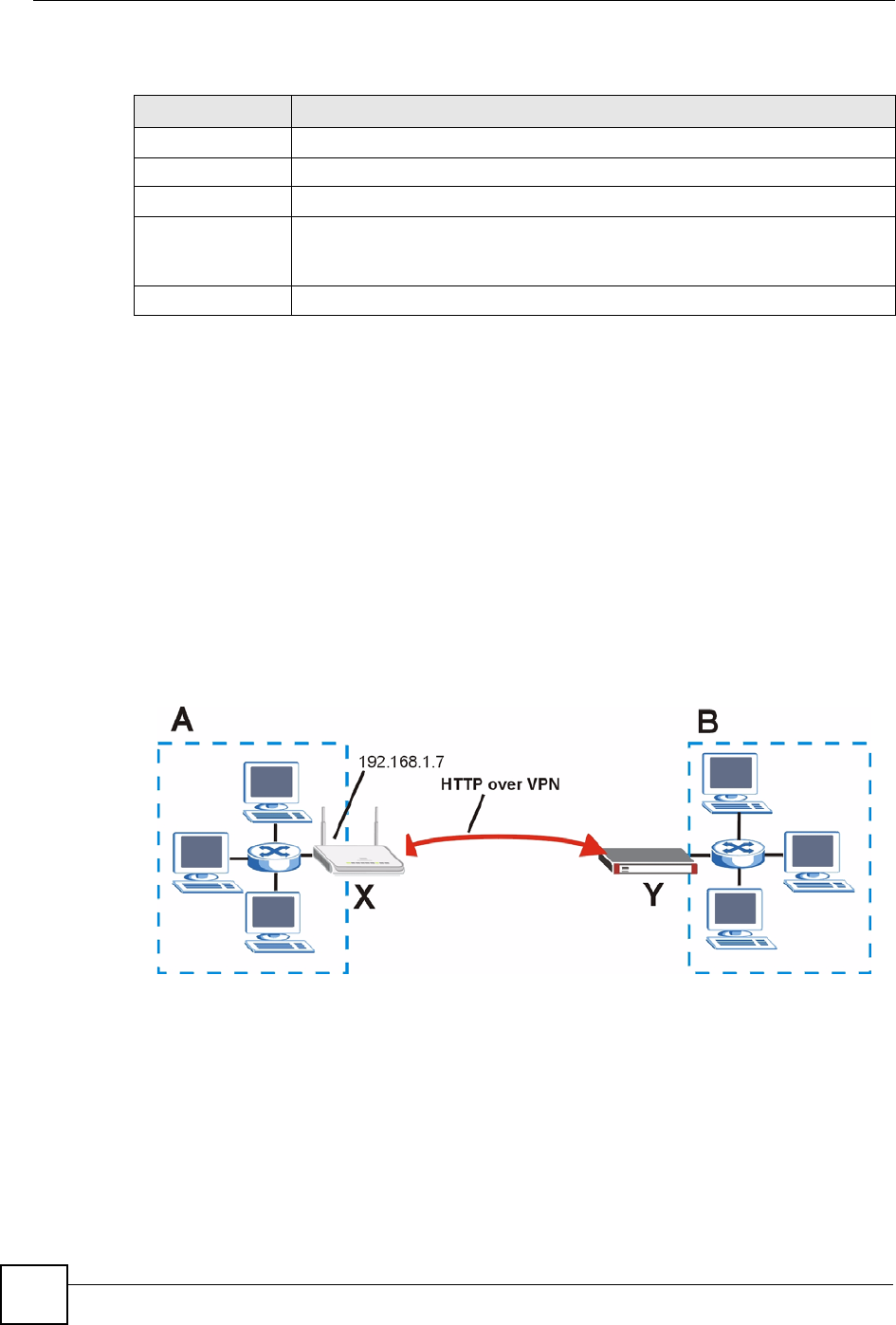
Chapter 15 IPSec VPN
NBG420N User’s Guide
184
The following table describes the labels in this screen.
15.4 VPN and Remote Management
You can allow someone to use a service (like Telnet or HTTP) through a VPN tunnel to
manage the NBG420N. One of the NBG420N’s ports must be part of the VPN rule’s local
network. This can be the NBG420N’s LAN port if you do not want to allow remote
management on the WAN port. You also have to configure remote management (REMOTE
MGMT) to allow management access for the service through the specific port.
In the following example, the VPN rule’s local network (A) includes the NBG420N’s LAN IP
address of 192.168.1.7. Someone in the remote network (B) can use a service (like HTTP for
example) through the VPN tunnel to access the NBG420N’s LAN interface. Remote
management must also be configured to allow HTTP access on the NBG420N’s LAN
interface.
Figure 110 VPN for Remote Management Example
Table 66 Security > VPN > SA Monitor
LABEL DESCRIPTION
# This is the security association index number.
Name This field displays the identification name for this VPN policy.
Encapsulation This field displays Tunnel or Transport mode.
IPSec Algorithm This field displays the security protocols used for an SA.
Both AH and ESP increase NBG420N processing requirements and
communications latency (delay).
Refresh Click Refresh to display the current active VPN connection(s).
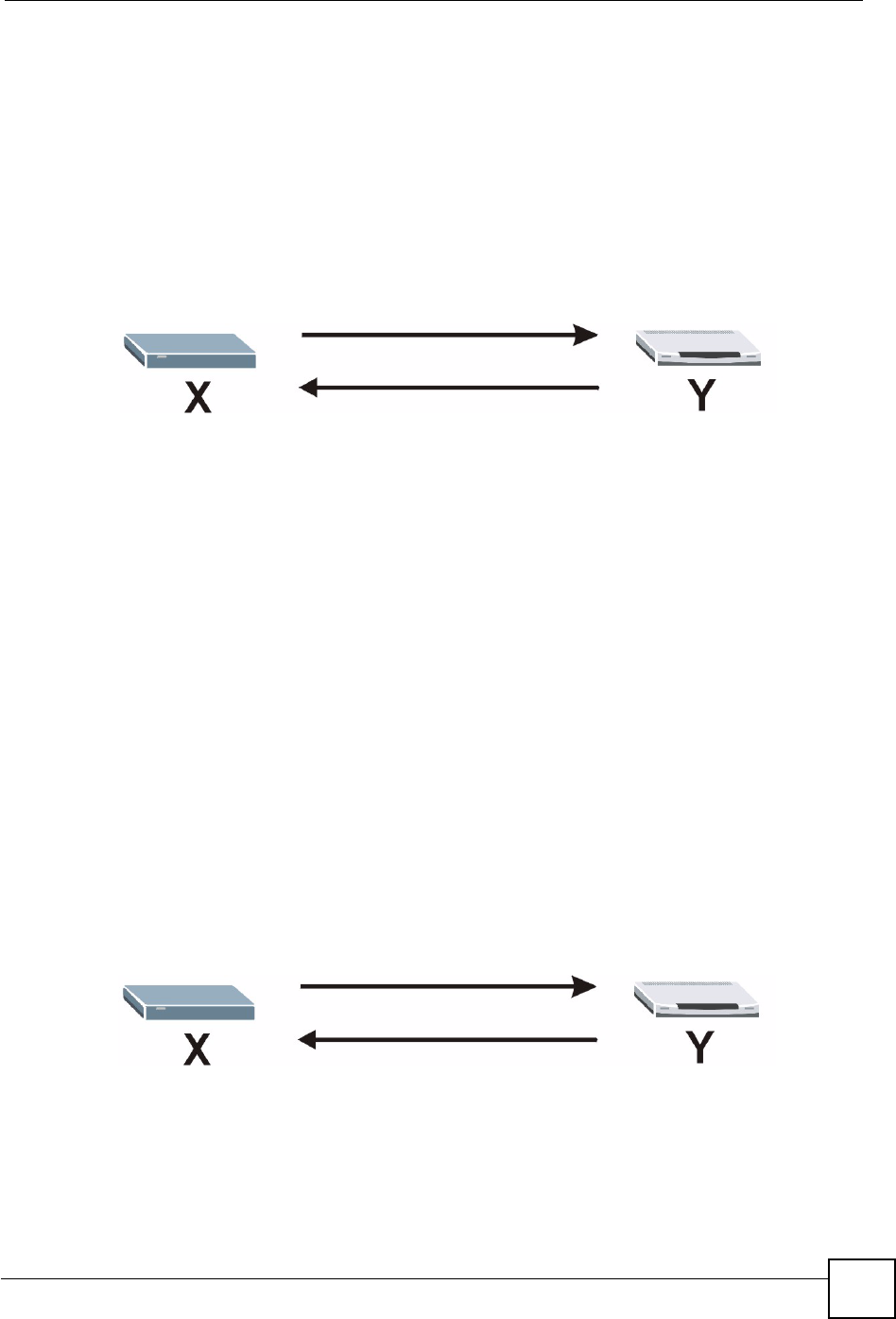
Chapter 15 IPSec VPN
NBG420N User’s Guide 185
15.5 IPSec VPN Technical Reference
IKE SA Proposal
The IKE SA proposal is used to identify the encryption algorithm, authentication algorithm,
and Diffie-Hellman (DH) key group that the NBG420N and remote IPSec router use in the
IKE SA. In main mode, this is done in steps 1 and 2, as illustrated below.
Figure 111 IKE SA: Main Negotiation Mode, Steps 1 - 2: IKE SA Proposal
The NBG420N sends a proposal to the remote IPSec router. Each proposal consists of an
encryption algorithm, authentication algorithm, and DH key group that the NBG420N wants
to use in the IKE SA. The remote IPSec router sends the accepted proposal back to the
NBG420N. If the remote IPSec router rejects the proposal (for example, if the VPN tunnel is
not configured correctly), the NBG420N and remote IPSec router cannot establish an IKE SA.
Note: Both routers must use the same encryption algorithm, authentication algorithm,
and DH key group.
See the field descriptions for information about specific encryption algorithms, authentication
algorithms, and DH key groups. See Diffie-Hellman (DH) Key Exchange on page 185 for
more information about DH key groups.
Diffie-Hellman (DH) Key Exchange
The NBG420N and the remote IPSec router use a DH key exchange to establish a shared
secret, which is used to generate encryption keys for IKE SA and IPSec SA. In main mode, the
DH key exchange is done in steps 3 and 4, as illustrated below.
Figure 112 IKE SA: Main Negotiation Mode, Steps 3 - 4: DH Key Exchange
The DH key exchange is based on DH key groups. Each key group is a fixed number of bits
long. The longer the key, the more secure the encryption keys, but also the longer it takes to
encrypt and decrypt information. For example, DH2 keys (1024 bits) are more secure than
DH1 keys (768 bits), but DH2 encryption keys take longer to encrypt and decrypt.
1
2
3
4
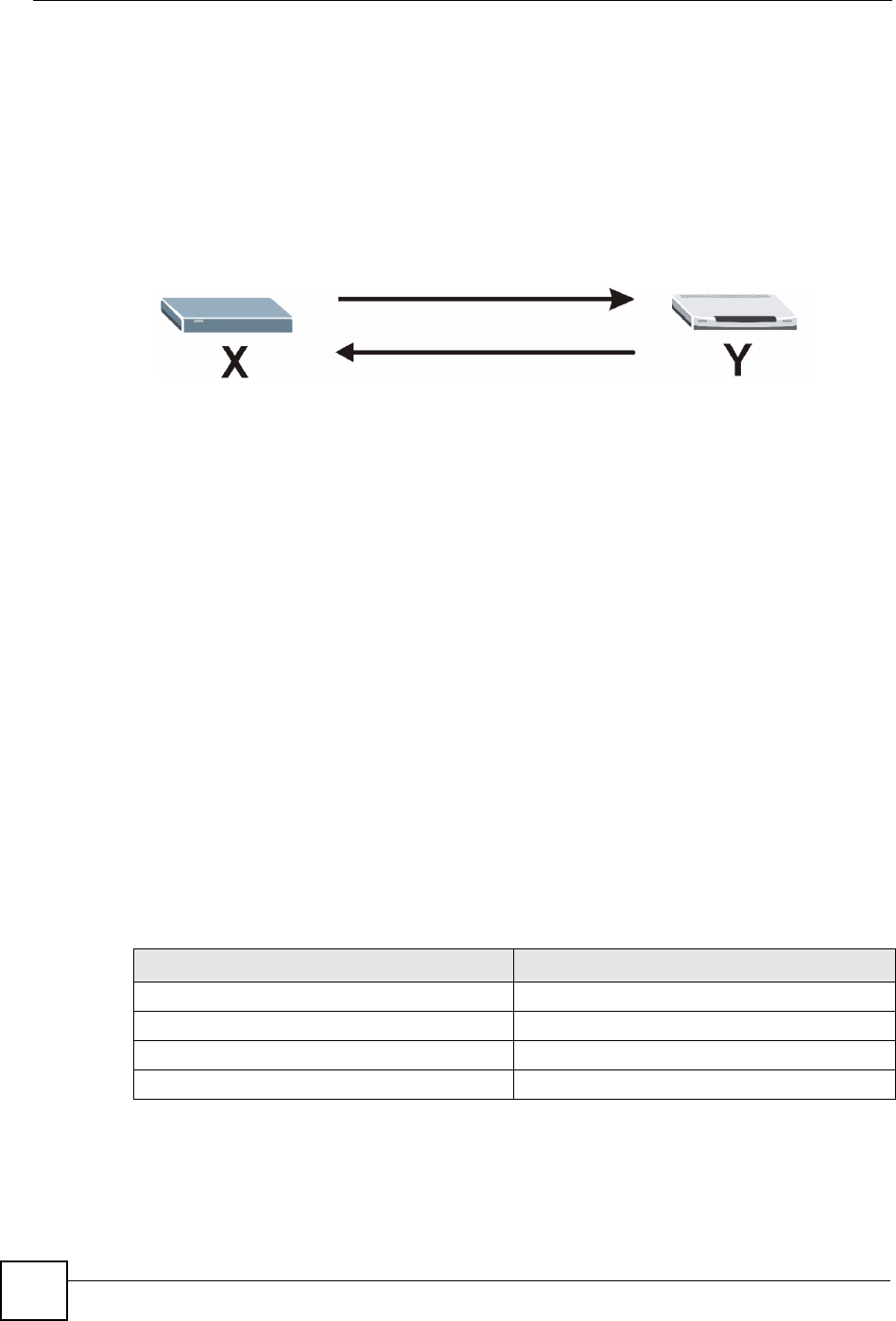
Chapter 15 IPSec VPN
NBG420N User’s Guide
186
Authentication
Before the NBG420N and remote IPSec router establish an IKE SA, they have to verify each
other’s identity. This process is based on pre-shared keys and router identities.
In main mode, the NBG420N and remote IPSec router authenticate each other in steps 5 and 6,
as illustrated below. Their identities are encrypted using the encryption algorithm and
encryption key the NBG420N and remote IPSec router selected in previous steps.
Figure 113 IKE SA: Main Negotiation Mode, Steps 5 - 6: Authentication
The NBG420N and remote IPSec router use a pre-shared key in the authentication process,
though it is not actually transmitted or exchanged.
Note: The NBG420N and the remote IPSec router must use the same pre-shared
key.
Router identity consists of ID type and ID content. The ID type can be IP address, domain
name, or e-mail address, and the ID content is a specific IP address, domain name, or e-mail
address. The ID content is only used for identification; the IP address, domain name, or e-mail
address that you enter does not have to actually exist.
The NBG420N and the remote IPSec router each has its own identity, so each one must store
two sets of information, one for itself and one for the other router. Local ID type and ID
content refers to the ID type and ID content that applies to the router itself, and peer ID type
and ID content refers to the ID type and ID content that applies to the other router in the IKE
SA.
Note: The NBG420N’s local and peer ID type and ID content must match the remote
IPSec router’s peer and local ID type and ID content, respectively.
In the following example, the ID type and content match so the NBG420N and the remote
IPSec router authenticate each other successfully.
Table 67 VPN Example: Matching ID Type and Content
NBG420N REMOTE IPSEC ROUTER
Local ID type: E-mail Local ID type: IP
Local ID content: tom@yourcompany.com Local ID content: 1.1.1.2
Peer ID type: IP Peer ID type: E-mail
Peer ID content: 1.1.1.2 Peer ID content: tom@yourcompany.com
5
6

Chapter 15 IPSec VPN
NBG420N User’s Guide 187
In the following example, the ID type and content do not match so the authentication fails and
the NBG420N and the remote IPSec router cannot establish an IKE SA.
Negotiation Mode
There are two negotiation modes: main mode and aggressive mode. Main mode provides
better security, while aggressive mode is faster.
Main mode takes six steps to establish an IKE SA.
Steps 1-2: The NBG420N sends its proposals to the remote IPSec router. The remote IPSec
router selects an acceptable proposal and sends it back to the NBG420N.
Steps 3-4: The NBG420N and the remote IPSec router participate in a Diffie-Hellman key
exchange, based on the accepted DH key group, to establish a shared secret.
Steps 5-6: Finally, the NBG420N and the remote IPSec router generate an encryption key from
the shared secret, encrypt their identities, and exchange their encrypted identity information
for authentication.
In contrast, aggressive mode only takes three steps to establish an IKE SA.
Step 1: The NBG420N sends its proposals to the remote IPSec router. It also starts the Diffie-
Hellman key exchange and sends its (unencrypted) identity to the remote IPSec router for
authentication.
Step 2: The remote IPSec router selects an acceptable proposal and sends it back to the
NBG420N. It also finishes the Diffie-Hellman key exchange, authenticates the NBG420N,
and sends its (unencrypted) identity to the NBG420N for authentication.
Step 3: The NBG420N authenticates the remote IPSec router and confirms that the IKE SA is
established.
Aggressive mode does not provide as much security as main mode because the identity of the
NBG420N and the identity of the remote IPSec router are not encrypted. It is usually used
when the address of the initiator is not known by the responder and both parties want to use
pre-shared keys for authentication (for example, telecommuters).
VPN, NAT, and NAT Traversal
In the following example, there is another router (A) between router X and router Y.
Table 68 VPN Example: Mismatching ID Type and Content
NBG420N REMOTE IPSEC ROUTER
Local ID type: E-mail Local ID type: IP
Local ID content: tom@yourcompany.com Local ID content: 1.1.1.2
Peer ID type: IP Peer ID type: E-mail
Peer ID content: 1.1.1.15 Peer ID content: tom@yourcompany.com
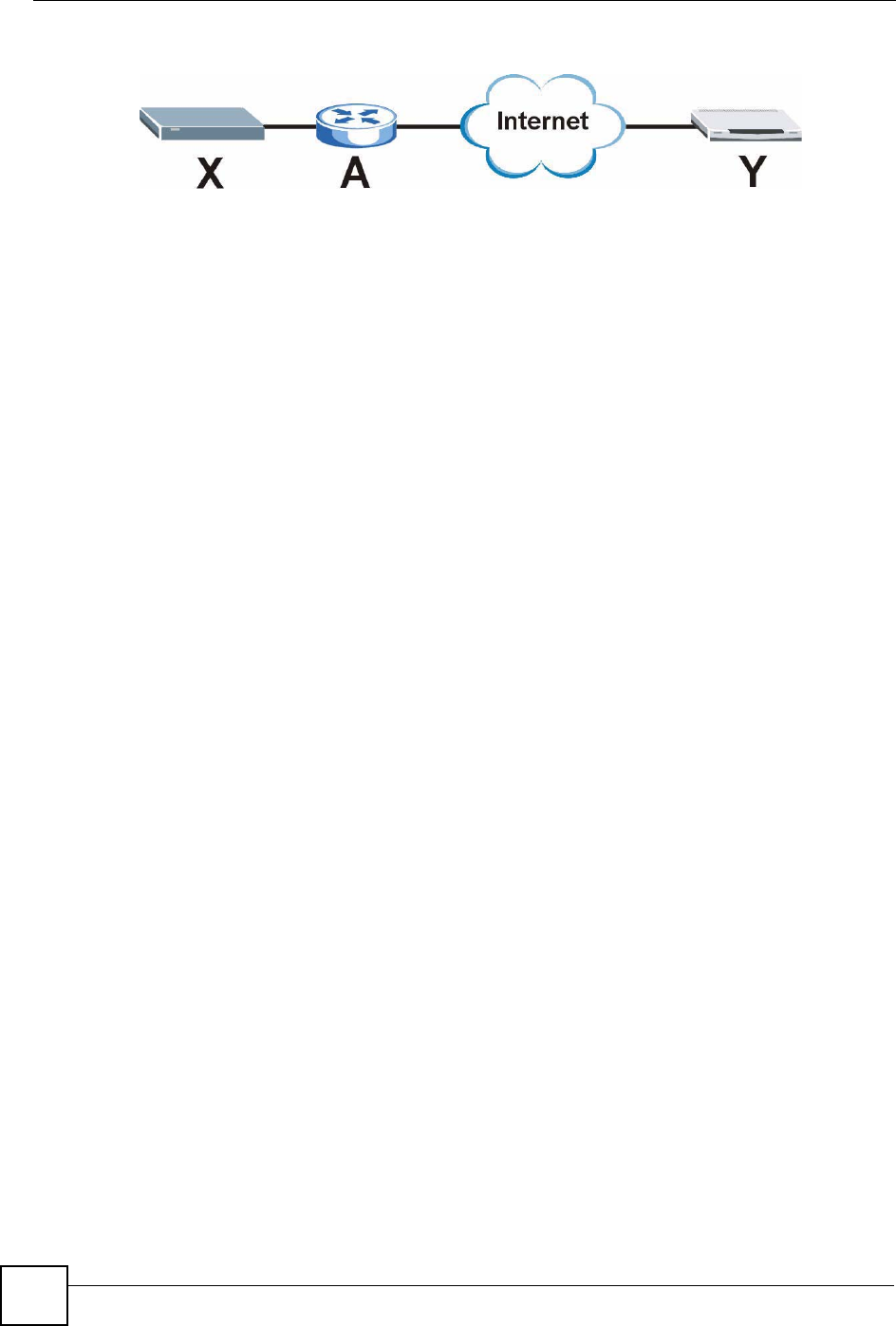
Chapter 15 IPSec VPN
NBG420N User’s Guide
188
Figure 114 VPN/NAT Example
If router A does NAT, it might change the IP addresses, port numbers, or both. If router X and
router Y try to establish a VPN tunnel, the authentication fails because it depends on this
information. The routers cannot establish a VPN tunnel.
Most routers like router A now have an IPSec pass-through feature. This feature helps router A
recognize VPN packets and route them appropriately. If router A has this feature, router X and
router Y can establish a VPN tunnel as long as the IPSec protocol is ESP. (See IPSec Protocol
on page 188 for more information about active protocols.)
If router A does not have an IPSec pass-through or if the IPSec protocol is AH, you can solve
this problem by enabling NAT traversal. In NAT traversal, router X and router Y add an extra
header to the IKE SA and IPSec SA packets. If you configure router A to forward these
packets unchanged, router X and router Y can establish a VPN tunnel.
You have to do the following things to set up NAT traversal.
• Enable NAT traversal on the NBG420N and remote IPSec router.
• Configure the NAT router to forward packets with the extra header unchanged.
The extra header may be UDP port 500 or UDP port 4500, depending on the standard(s) the
NBG420N and remote IPSec router support.
IPSec Protocol
The IPSec protocol controls the format of each packet. It also specifies how much of each
packet is protected by the encryption and authentication algorithms. IPSec VPN includes two
IPSec protocols, AH (Authentication Header, RFC 2402) and ESP (Encapsulating Security
Payload, RFC 2406).
Note: The NBG420N and remote IPSec router must use the same IPSec protocol.
Usually, you should select ESP. AH does not support encryption, and ESP is more suitable
with NAT.
Encapsulation
There are two ways to encapsulate packets. Usually, you should use tunnel mode because it is
more secure. Transport mode is only used when the IPSec SA is used for communication
between the NBG420N and remote IPSec router (for example, for remote management), not
between computers on the local and remote networks.
Note: The NBG420N and remote IPSec router must use the same encapsulation.

Chapter 15 IPSec VPN
NBG420N User’s Guide 189
These modes are illustrated below.
In tunnel mode, the NBG420N uses the IPSec protocol to encapsulate the entire IP packet. As
a result, there are two IP headers:
• Outside header: The outside IP header contains the IP address of the NBG420N or remote
IPSec router, whichever is the destination.
• Inside header: The inside IP header contains the IP address of the computer behind the
NBG420N or remote IPSec router. The header for the IPSec protocol (AH or ESP)
appears between the IP headers.
In transport mode, the encapsulation depends on the IPSec protocol. With AH, the NBG420N
includes part of the original IP header when it encapsulates the packet. With ESP, however, the
NBG420N does not include the IP header when it encapsulates the packet, so it is not possible
to verify the integrity of the source IP address.
IPSec SA Proposal and Perfect Forward Secrecy
An IPSec SA proposal is similar to an IKE SA proposal (see IKE SA Proposal on page 185),
except that you also have the choice whether or not the NBG420N and remote IPSec router
perform a new DH key exchange every time an IPSec SA is established. This is called Perfect
Forward Secrecy (PFS).
If you enable PFS, the NBG420N and remote IPSec router perform a DH key exchange every
time an IPSec SA is established, changing the root key from which encryption keys are
generated. As a result, if one encryption key is compromised, other encryption keys remain
secure.
If you do not enable PFS, the NBG420N and remote IPSec router use the same root key that
was generated when the IKE SA was established to generate encryption keys.
The DH key exchange is time-consuming and may be unnecessary for data that does not
require such security.
Figure 115 VPN: Transport and Tunnel Mode Encapsulation
Original Packet IP Header TCP
Header
Data
Transport Mode Packet IP Header AH/ESP
Header
TCP
Header
Data
Tunnel Mode Packet IP Header AH/ESP
Header
IP Header TCP
Header
Data

Chapter 15 IPSec VPN
NBG420N User’s Guide
190
Additional IPSec VPN Topics
This section discusses other IPSec VPN topics that apply to either IKE SAs or IPSec SAs or
both. Relationships between the topics are also highlighted.
SA Life Time
SAs have a lifetime that specifies how long the SA lasts until it times out. When an SA times
out, the NBG420N automatically renegotiates the SA in the following situations:
• There is traffic when the SA life time expires
• The IPSec SA is configured on the NBG420N as nailed up (see below)
Otherwise, the NBG420N must re-negotiate the SA the next time someone wants to send
traffic.
Note: If the IKE SA times out while an IPSec SA is connected, the IPSec SA stays
connected.
An IPSec SA can be set to keep alive Normally, the NBG420N drops the IPSec SA when the
life time expires or after two minutes of outbound traffic with no inbound traffic. If you set the
IPSec SA to keep alive , the NBG420N automatically renegotiates the IPSec SA when the SA
life time expires, and it does not drop the IPSec SA if there is no inbound traffic.
Note: The SA life time and keep alive settings only apply if the rule identifies the
remote IPSec router by a static IP address or a domain name. If the Secure
Gateway Address field is set to 0.0.0.0, the NBG420N cannot initiate the
tunnel (and cannot renegotiate the SA).
Encryption and Authentication Algorithms
In most NBG420Ns, you can select one of the following encryption algorithms for each
proposal. The encryption algorithms are listed here in order from weakest to strongest.
• Data Encryption Standard (DES) is a widely used (but breakable) method of data
encryption. It applies a 56-bit key to each 64-bit block of data.
• Triple DES (3DES) is a variant of DES. It iterates three times with three separate keys,
effectively tripling the strength of DES.
You can select one of the following authentication algorithms for each proposal. The
algorithms are listed here in order from weakest to strongest.
• MD5 (Message Digest 5) produces a 128-bit digest to authenticate packet data.
• SHA1 (Secure Hash Algorithm) produces a 160-bit digest to authenticate packet data.
Private DNS Server
In cases where you want to use domain names to access Intranet servers on a remote private
network that has a DNS server, you must identify that DNS server. You cannot use DNS
servers on the LAN or from the ISP since these DNS servers cannot resolve domain names to
private IP addresses on the remote private network.
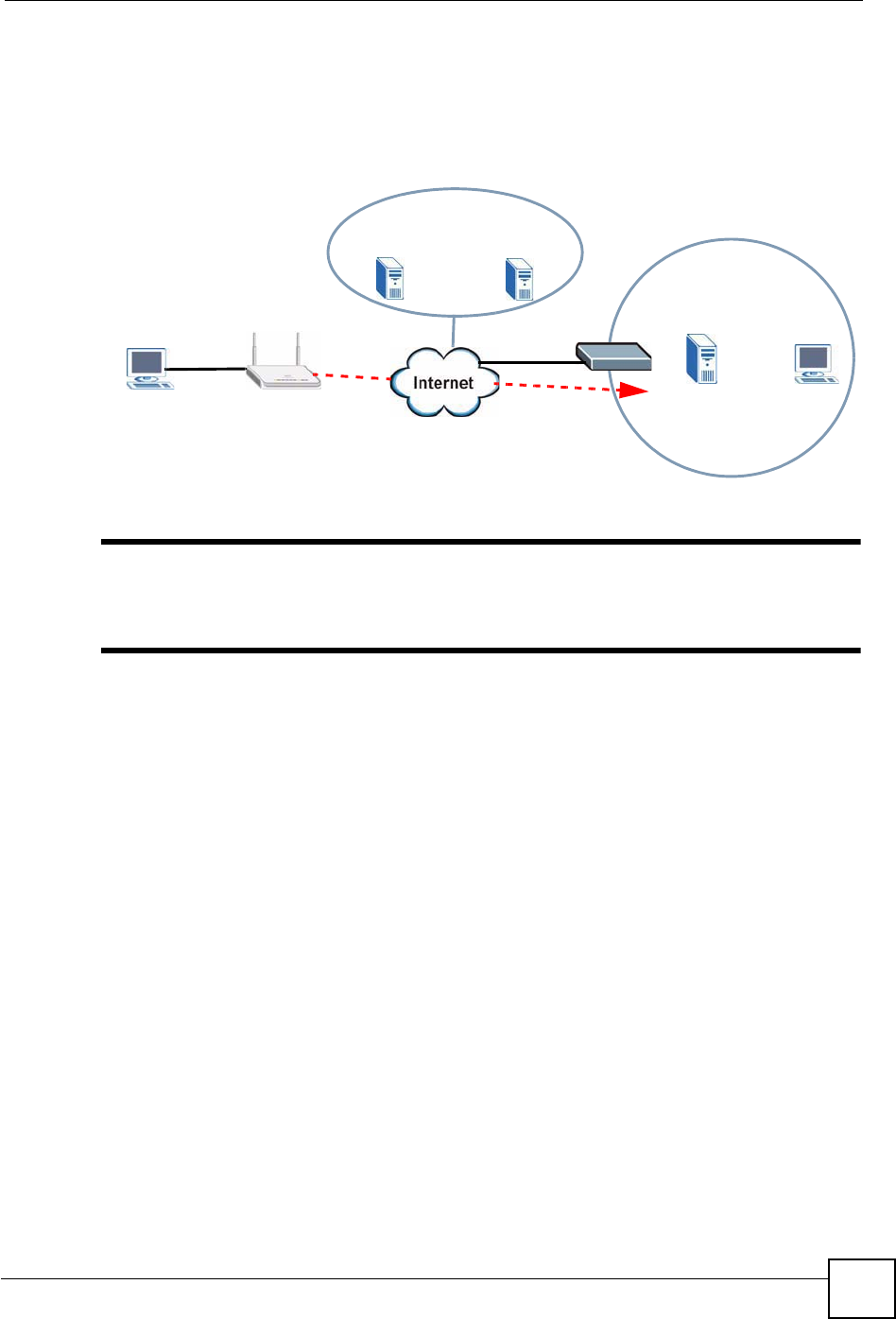
Chapter 15 IPSec VPN
NBG420N User’s Guide 191
The following figure depicts an example where one VPN tunnel is created from an NBG420N
at branch office (B) to headquarters (HQ). In order to access computers that use private
domain names on the HQ network, the NBG420N at B uses the Intranet DNS server in
headquarters.
Figure 116 Private DNS Server Example
"
If you do not specify an Intranet DNS server on the remote network, then the
VPN host must use IP addresses to access the computers on the remote
private network.
HQ
10.1.1.1/200
Intranet DNS
10.1.1.10
ISP
DNS Servers
212.54.64.170 212.54.64.171
LAN
DNS: 212.51.61.170
212.54.64.171
B

Chapter 15 IPSec VPN
NBG420N User’s Guide
192

193
PART IV
Management
Static Route Screens (195)
Bandwidth Management (199)
Remote Management (209)
Universal Plug-and-Play (UPnP) (215)

194
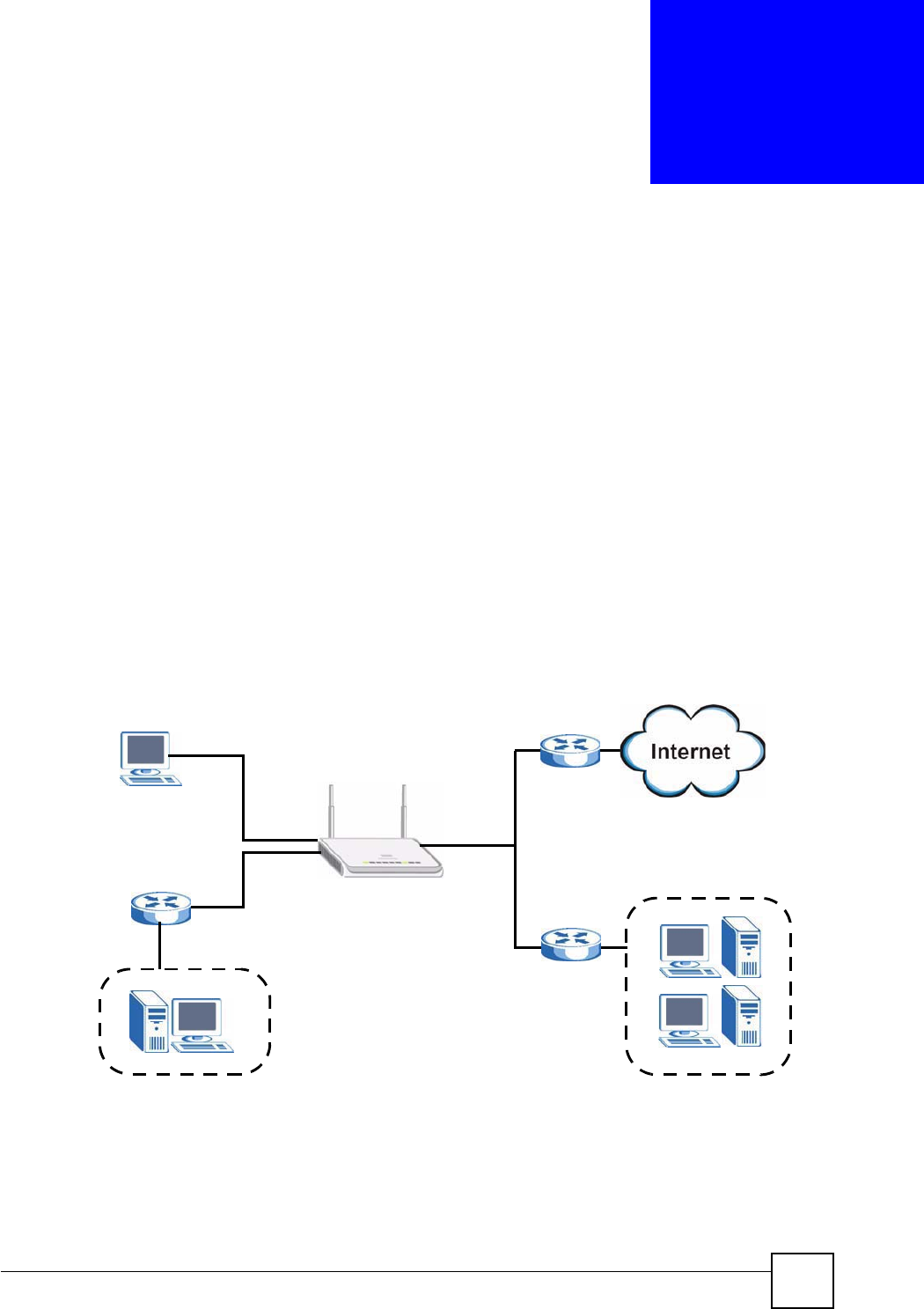
NBG420N User’s Guide 195
CHAPTER 16
Static Route Screens
This chapter shows you how to configure static routes for your NBG420N.
16.1 Static Route Overview
The NBG420N usually uses the default gateway to route outbound traffic from computers on
the LAN to the Internet. To have the NBG420N send data to devices not reachable through the
default gateway, use static routes.
For example, the next figure shows a computer (A) connected to the NBG420N’s LAN
interface. The NBG420N routes most traffic from Ato the Internet through the NBG420N’s
default gateway (R1). You create one static route to connect to services offered by your ISP
behind router R2. You create another static route to communicate with a separate network
behind a router R3 connected to the LAN.
Figure 117 Example of Static Routing Topology
16.2 IP Static Route Screen
Click Management > Static Route to open the IP Static Route screen. The following screen
displays.
WAN
R1
R2
A
R3
LAN
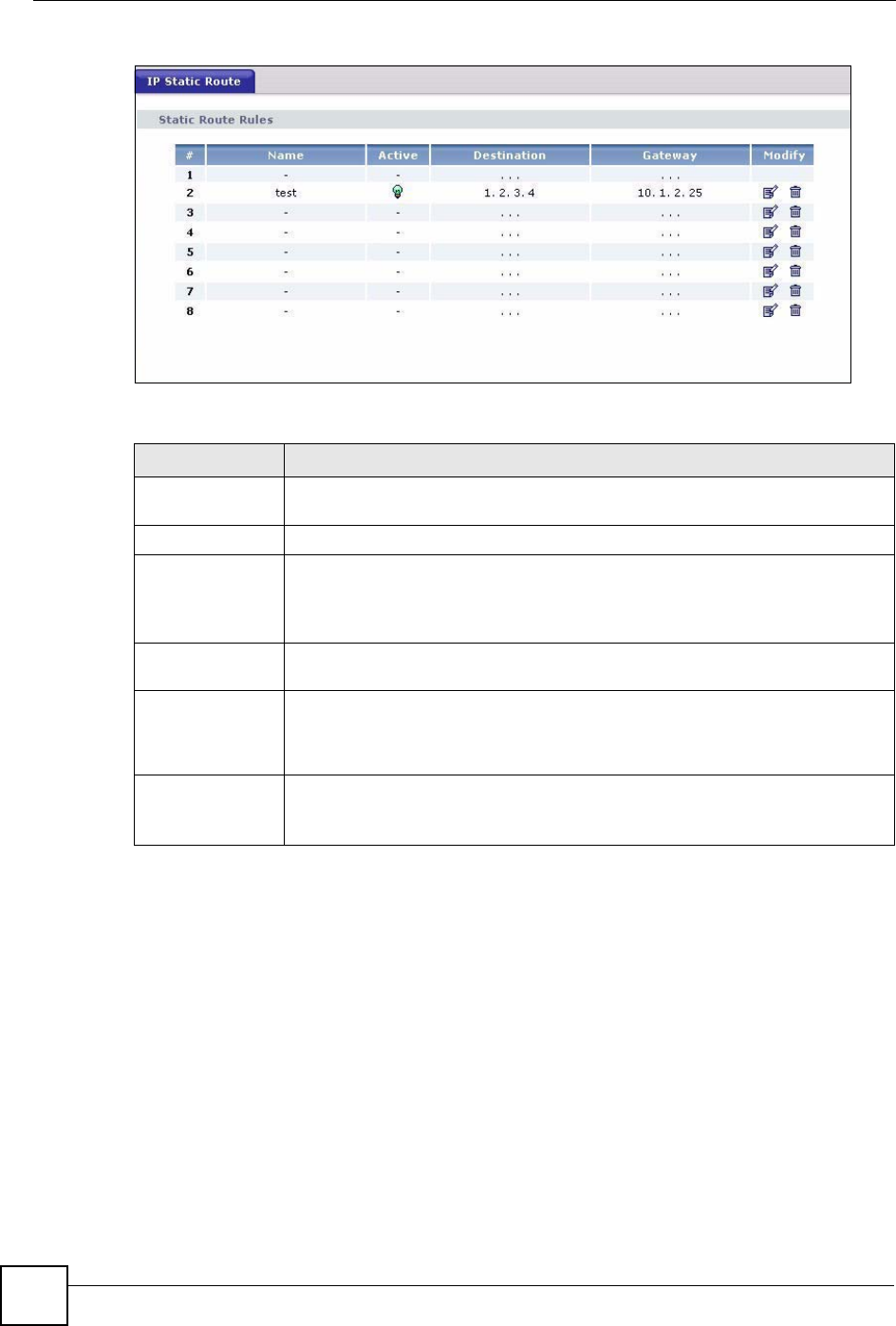
Chapter 16 Static Route Screens
NBG420N User’s Guide
196
Figure 118 Management > Static Route > IP Static Route
The following table describes the labels in this screen.
16.2.1 Static Route Setup Screen
To edit a static route, click the edit icon under Modify. The following screen displays. Fill in
the required information for each static route.
Table 69 Management > Static Route > IP Static Route
LABEL DESCRIPTION
#This is the index number of an individual static route. The first entry is for the
default route and not editable.
Name This is the name that describes or identifies this route.
Active This icon is turned on when this static route is active.
Click the Edit icon under Modify and select the Active checkbox in the Static
Route Setup screen to enable the static route. Clear the checkbox to disable this
static route without having to delete the entry.
Destination This parameter specifies the IP network address of the final destination. Routing
is always based on network number.
Gateway This is the IP address of the gateway. The gateway is an immediate neighbor of
your NBG420N that will forward the packet to the destination. On the LAN, the
gateway must be a router on the same segment as your NBG420N; over the
WAN, the gateway must be the IP address of one of the remote nodes.
Modify Click the Edit icon to open the static route setup screen. Modify a static route or
create a new static route in the Static Route Setup screen.
Click the Remove icon to delete a static route.
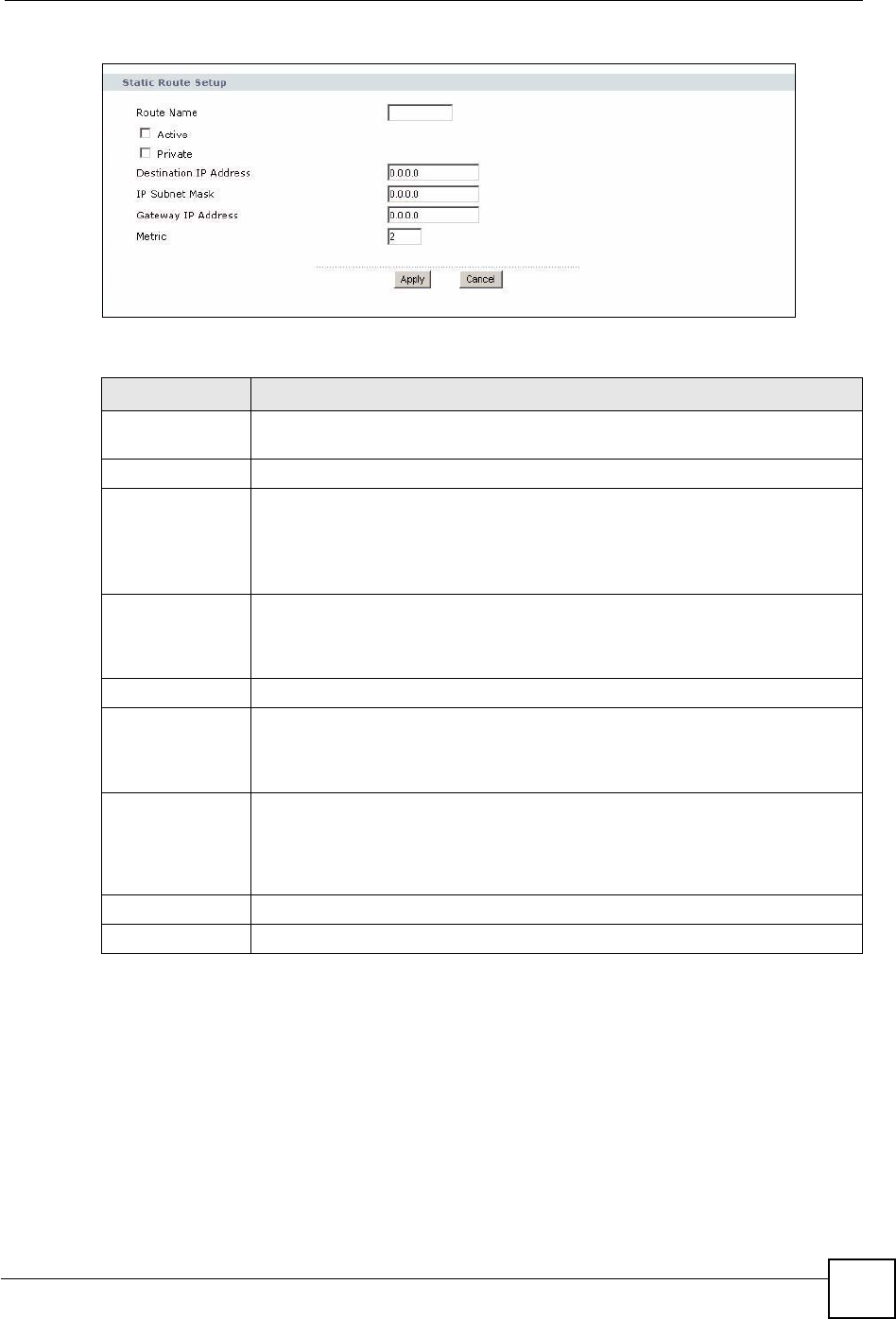
Chapter 16 Static Route Screens
NBG420N User’s Guide 197
Figure 119 Management > Static Route > IP Static Route: Static Route Setup
The following table describes the labels in this screen.
Table 70 Management > Static Route > IP Static Route: Static Route Setup
LABEL DESCRIPTION
Route Name Enter the name of the IP static route. Leave this field blank to delete this static
route.
Active This field allows you to activate/deactivate this static route.
Private This parameter determines if the NBG420N will include this route to a remote node
in its RIP broadcasts.
Select this check box to keep this route private and not included in RIP
broadcasts. Clear this checkbox to propagate this route to other hosts through RIP
broadcasts.
Destination IP
Address
This parameter specifies the IP network address of the final destination. Routing is
always based on network number. If you need to specify a route to a single host,
use a subnet mask of 255.255.255.255 in the subnet mask field to force the
network number to be identical to the host ID.
IP Subnet Mask Enter the IP subnet mask here.
Gateway IP
Address
Enter the IP address of the gateway. The gateway is an immediate neighbor of
your NBG420N that will forward the packet to the destination. On the LAN, the
gateway must be a router on the same segment as your NBG420N; over the WAN,
the gateway must be the IP address of one of the Remote Nodes.
Metric Metric represents the “cost” of transmission for routing purposes. IP routing uses
hop count as the measurement of cost, with a minimum of 1 for directly connected
networks. Enter a number that approximates the cost for this link. The number
need not be precise, but it must be between 1 and 15. In practice, 2 or 3 is usually
a good number.
Apply Click Apply to save your changes back to the NBG420N.
Cancel Click Cancel to return to the previous screen and not save your changes.

Chapter 16 Static Route Screens
NBG420N User’s Guide
198

NBG420N User’s Guide 199
CHAPTER 17
Bandwidth Management
This chapter contains information about configuring bandwidth management, editing rules and
viewing the NBG420N’s bandwidth management logs.
17.1 Bandwidth Management Overview
ZyXEL’s Bandwidth Management allows you to specify bandwidth management rules based
on an application and/or subnet. You can allocate specific amounts of bandwidth capacity
(bandwidth budgets) to different bandwidth rules.
The NBG420N applies bandwidth management to traffic that it forwards out through an
interface. The NBG420N does not control the bandwidth of traffic that comes into an
interface.
Bandwidth management applies to all traffic flowing out of the router, regardless of the
traffic's source.
Traffic redirect or IP alias may cause LAN-to-LAN traffic to pass through the NBG420N and
be managed by bandwidth management.
• The sum of the bandwidth allotments that apply to the WAN interface (LAN to WAN,
WLAN to WAN, WAN to WAN / NBG420N) must be less than or equal to the Upstream
Bandwidth that you configure in the Bandwidth Management Advanced screen.
• The sum of the bandwidth allotments that apply to the LAN port (WAN to LAN, WLAN
to LAN, LAN to LAN / NBG420N) must be less than or equal to 100,000 kbps (you
cannot configure the bandwidth budget for the LAN port).
• The sum of the bandwidth allotments that apply to the WLAN port (LAN to WLAN,
WAN to WLAN, WLAN to WLAN / NBG420N) must be less than or equal to 54,000
kbps (you cannot configure the bandwidth budget for the WLAN port).
17.2 Application-based Bandwidth Management
You can create bandwidth classes based on individual applications (like VoIP, Web, FTP, E-
mail and Video for example).
17.3 Subnet-based Bandwidth Management
You can create bandwidth classes based on subnets.
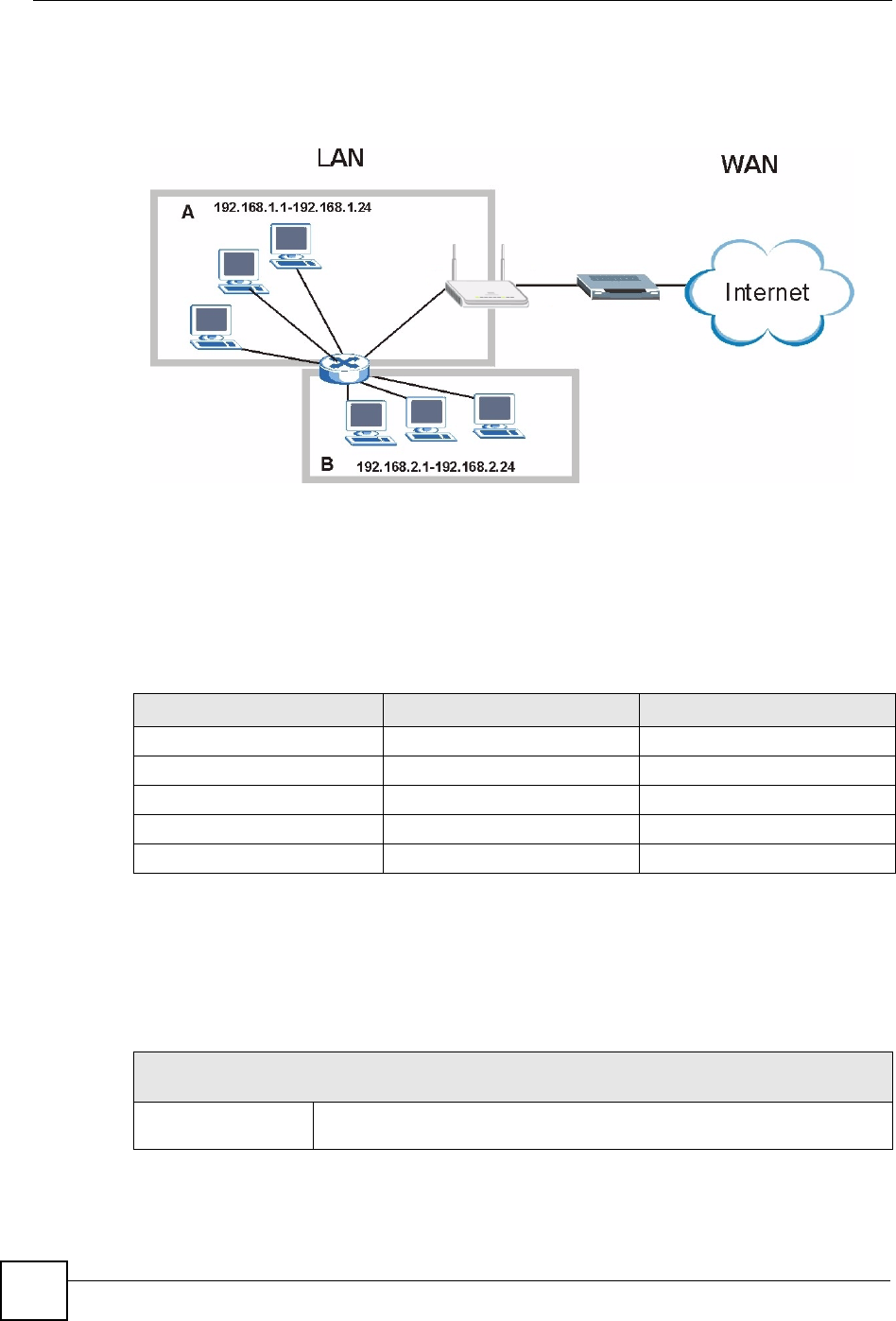
Chapter 17 Bandwidth Management
NBG420N User’s Guide
200
The following figure shows LAN subnets. You could configure one bandwidth class for subnet
A and another for subnet B.
Figure 120 Subnet-based Bandwidth Management Example
17.4 Application and Subnet-based Bandwidth Management
You could also create bandwidth classes based on a combination of a subnet and an
application. The following example table shows bandwidth allocations for application specific
traffic from separate LAN subnets.
17.5 Bandwidth Management Priorities
The following table describes the priorities that you can apply to traffic that the NBG420N
forwards out through an interface.
Table 71 Application and Subnet-based Bandwidth Management Example
TRAFFIC TYPE FROM SUBNET A FROM SUBNET B
VoIP 64 Kbps 64 Kbps
Web 64 Kbps 64 Kbps
FTP 64 Kbps 64 Kbps
E-mail 64 Kbps 64 Kbps
Video 64 Kbps 64 Kbps
Table 72 Bandwidth Management Priorities
PRIORITY LEVELS: TRAFFIC WITH A HIGHER PRIORITY GETS THROUGH FASTER WHILE
TRAFFIC WITH A LOWER PRIORITY IS DROPPED IF THE NETWORK IS CONGESTED.
High Typically used for voice traffic or video that is especially sensitive to jitter (jitter
is the variations in delay).